

RVing the USA: 48 States in 9 Months
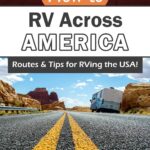
I first learned of the RV lifestyle in college. My professor was a travel writer, and I got the idea while sitting in class, “I want to travel full-time and see all 50 states”.
It was a dream I couldn’t quit, and after years of career changes, saving, and a new fiance, I had a plan.
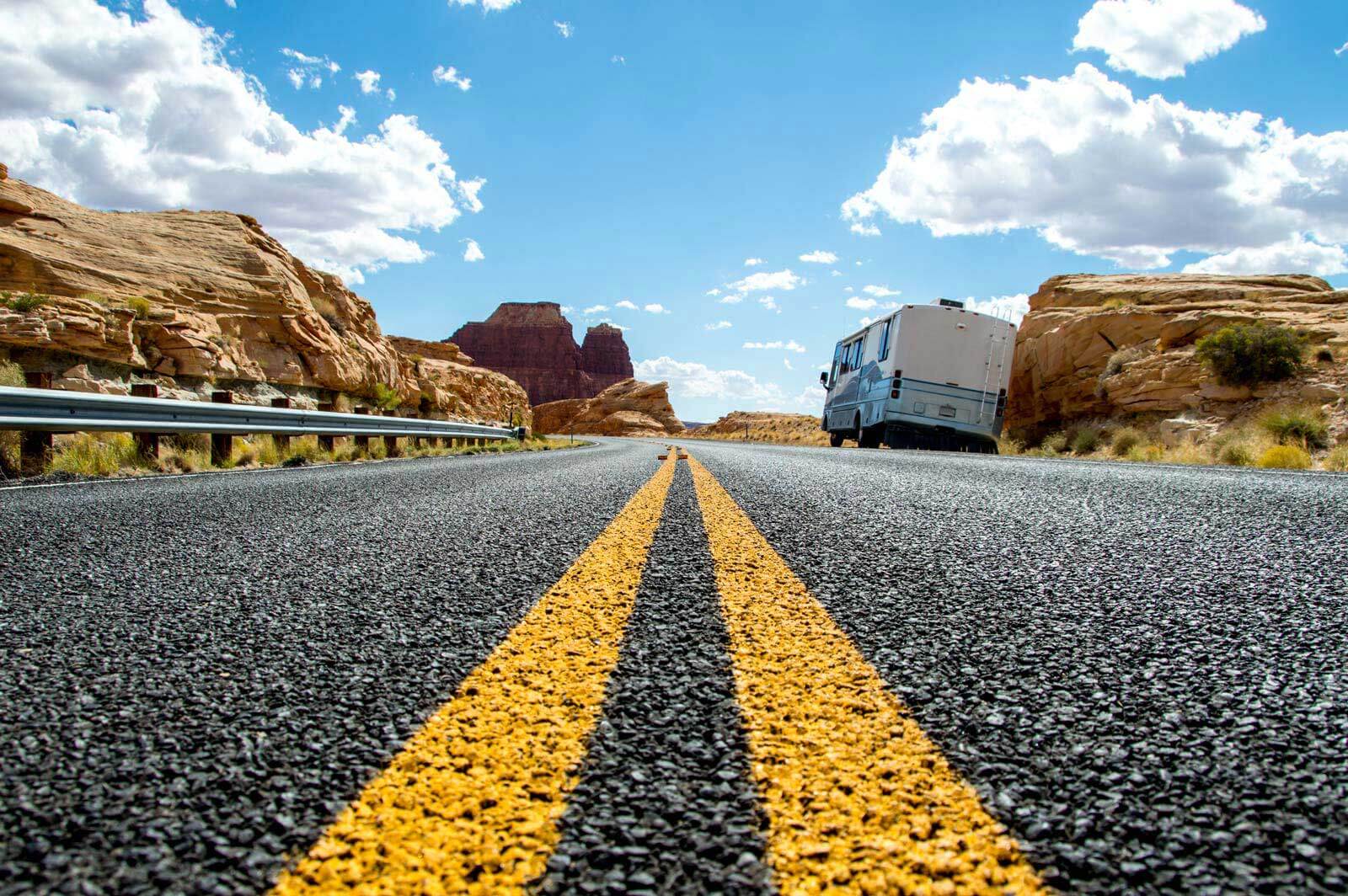
The new dream: See as many states as we can in our budget-friendly travel trailer with our senior pets, with the goal being all lower 48.
We left Idaho in November 2020, and by August 2021, we were popping champagne in Arkansas, our 48th state together.
Below, we’ll give our best advice, RV travel tips, and route planning hacks for RVing the USA.
Why You Should RV the USA
It’s not all about bragging rights, bucket list adventures, or filling up the sticker map.
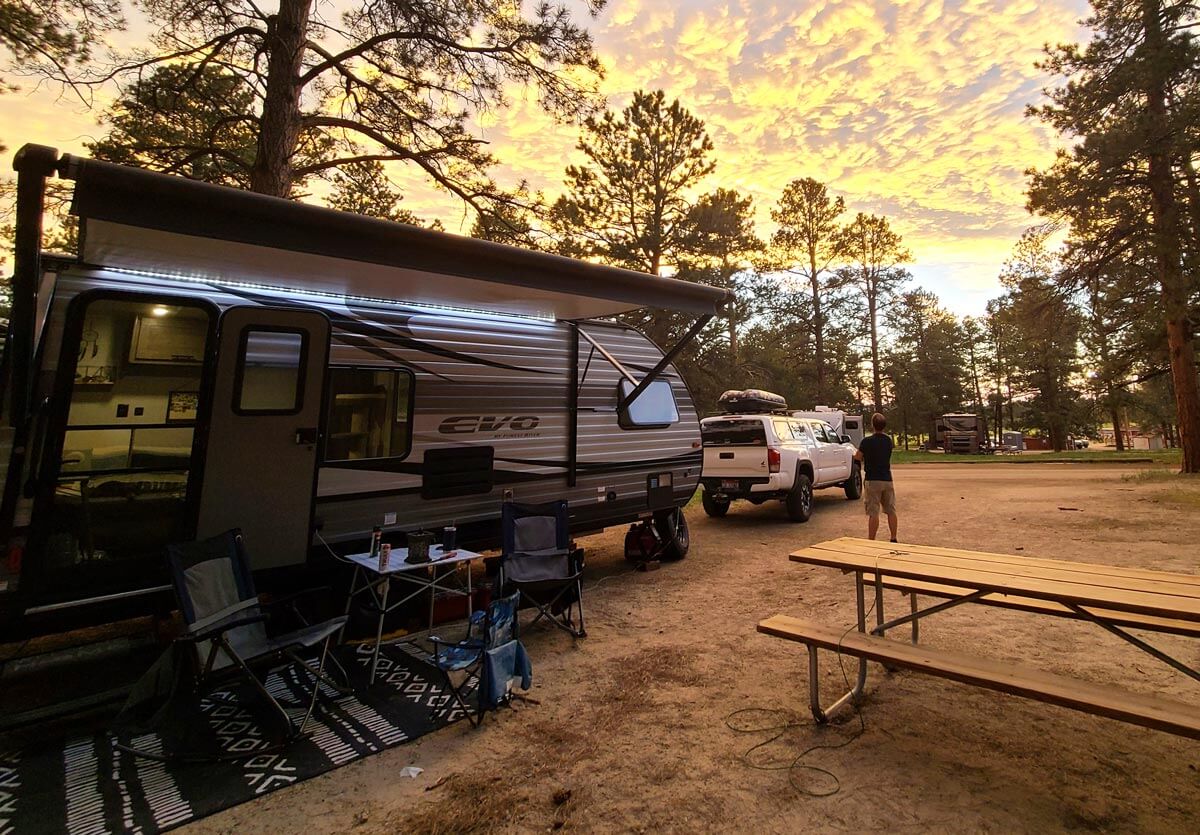
It’s better than traveling via airplane.
If you’re wanting to get somewhere fast, one of the best ways is to travel via airplane. But some of our favorite memories were made in those flyover states.
Soaking in historic hot springs in Arkansas and watching fireflies dance over a field in Iowa. You’d miss all of this if you were buzzing by them at 30,000 feet.
It’s better than a road trip in a car.
Imagine never having to worry about forgetting to pack something or wondering if that hotel bed is really clean or not. That’s the benefit of traveling with a home on wheels versus a sedan.
Experiencing different cultures around the U.S.
I feel like I could have an enjoyable conversation with just about anybody in this country. I could bond with a good ol’ boy from Alabama talking about my first crawfish-eating experience while also being able to share my favorite hiking trail with a granola girl from Denver.
Traveling in an RV means meeting more people than you would via airplane or car. You’re hanging out in campgrounds and national parks and spending more time at gas station pumps.
RVs are a great ice breaker for people, and some of the best conversations I’ve ever had have been with other RV owners on a cross-country journey.
Discovering hidden gems.
When you’re traveling in an RV, you tend to go at a slower pace. So you have time to discover those hidden gems around our country.
The billboards start tempting you as you’re cruising along at 55 mph. Before you know it, you’re searching for aliens in Roswell or eating the best chicken fried steak of your life from a drug store in West Texas.
Challenges of RVing across the USA
It’s not all Instagram-worthy sunsets and twirling in wildflowers. RVing across the US is not for the faint of heart.
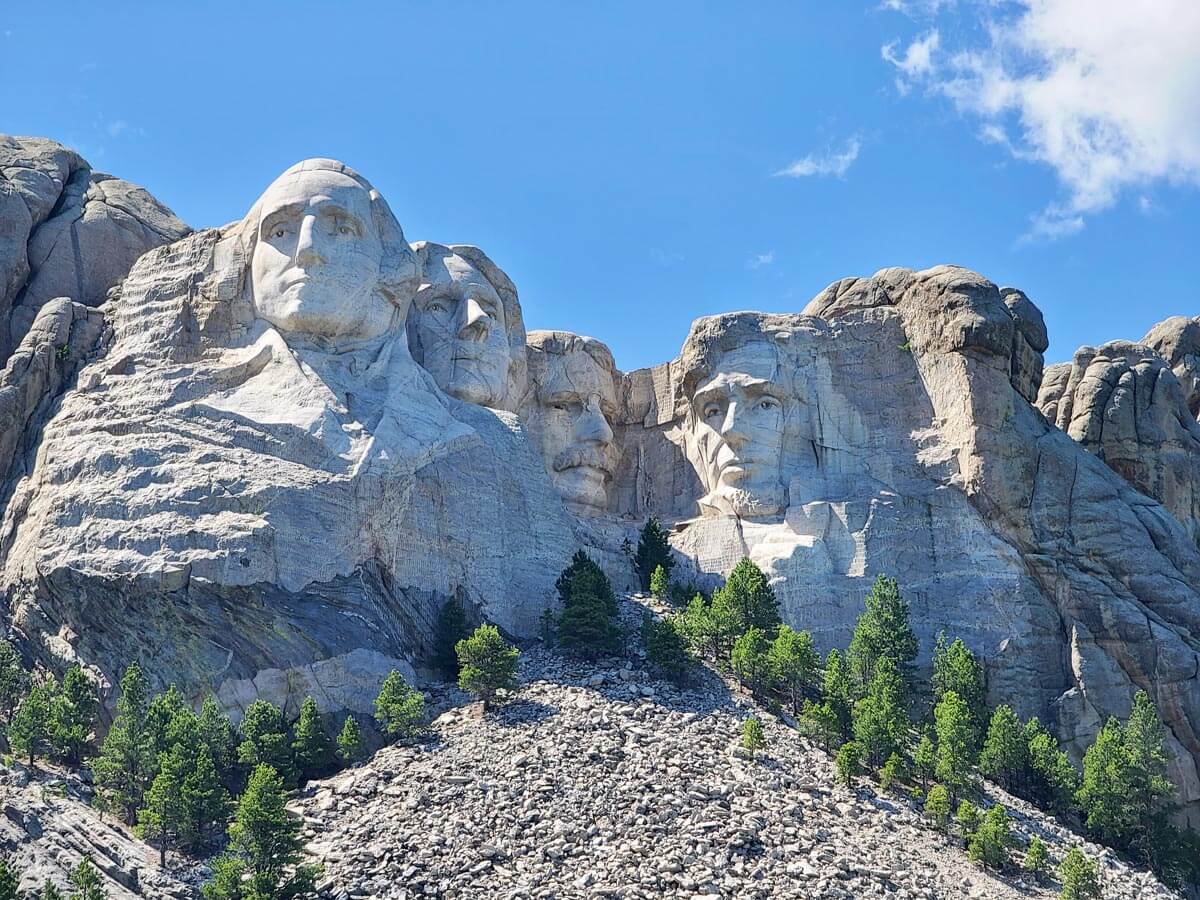
RVs are not fuel-efficient and tend to have big fuel tanks, so you’ll spend a lot of time and money at the pumps. (Use our RV cost gas calculator to estimate your RV trip fuel cost.)
Moving Too Fast
Moving at a fast pace means you’ll miss lots of things. The biggest regret we have with visiting all lower 48 states in less than a year was we missed so many interesting things we wanted to see!
Whether you’re driving a motorhome or even a camper van, parking tends to be a stressful experience. Plan ahead to ensure you have parking covered for things you want to see on the road.
The RV lifestyle is expensive, especially during the peak season of summer months.
Traveling with Pets
Not everywhere is pet friendly, and although it’s easier to travel with pets in an RV as compared to air or car travel, it still comes with safety concerns and extra planning. (You might also want to check out How to Go RVing with Cats ).
RV Repairs & Maintenance
\When you drive an RV down the road, it goes through the equivalent of a 5.0 earthquake. Things WILL break often, and never at a convenient time. Not to mention you’ll have to budget enough time for routine maintenance such as waxing your RV, greasing your bearings, and changing the oil in your motorhome or tow vehicle.
Should You Buy or Rent an RV?
There are both pros and cons to using an RV rental or purchasing your own RV for a cross-country road trip.
The pros of RV rentals are avoiding maintenance from wear and tear, which could be cheaper than purchasing based on your budget.
The con of RV rentals – it’s not your RV. You can only enjoy the comfort of your home as much as the rental company will allow. No permanent upgrades, painting, or anything that can’t be easily removed from the RV.
A big pro of owning an RV is it’s yours. You get to make your fifth wheel, travel trailer, or motorhome your own and travel with all the comforts of home! You can travel as long as you’d like, with the only time constraint being the ones you set yourself.
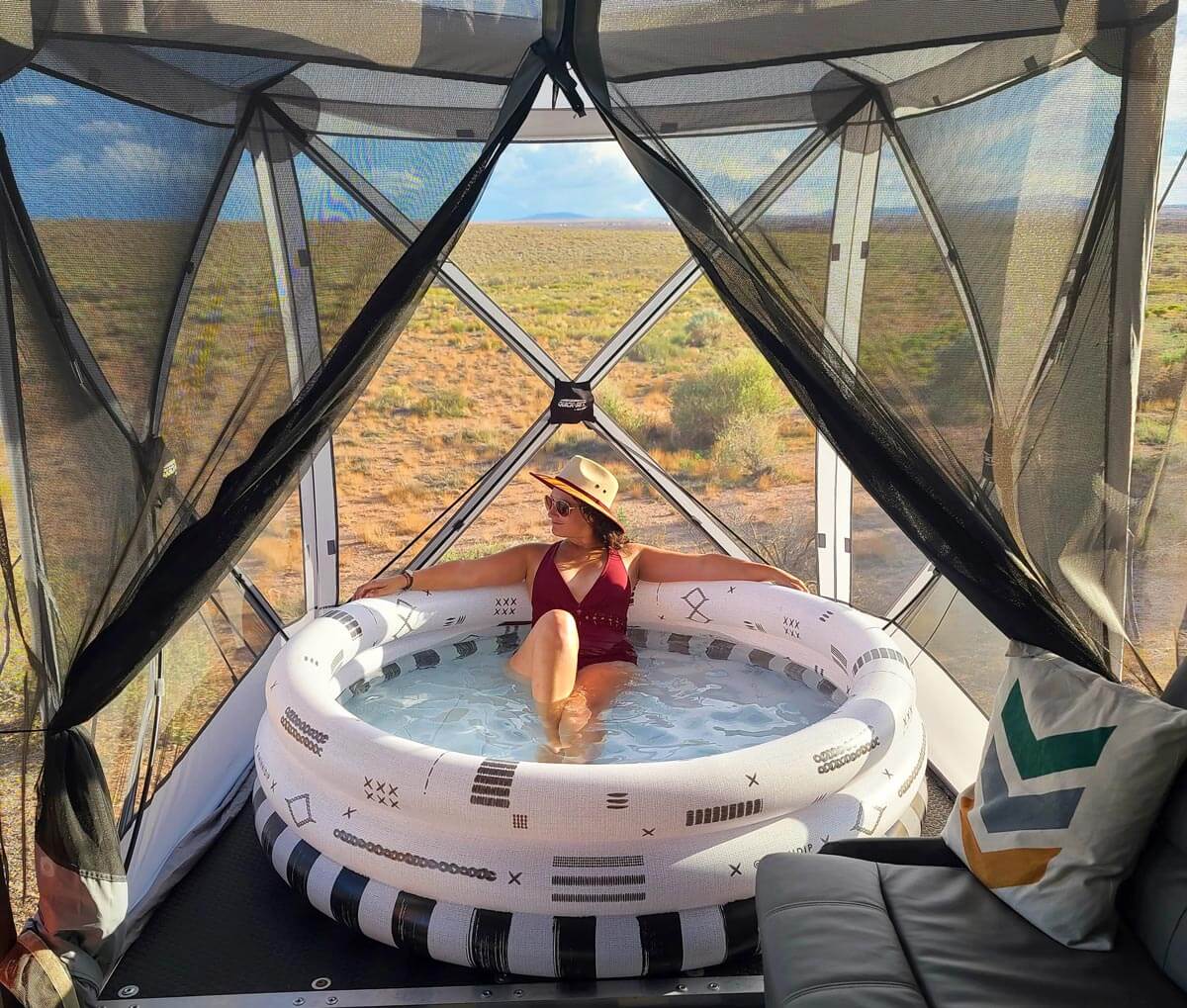
The obvious con is the cost of your RV . RVs can cost as little as a few thousand dollars or be more expensive than a house!
How to Plan to RV Across America
Creating a travel itinerary of the United States is no easy task. I sat down with a map of the country and a pencil with the intention of having to stay at least one night in every state.
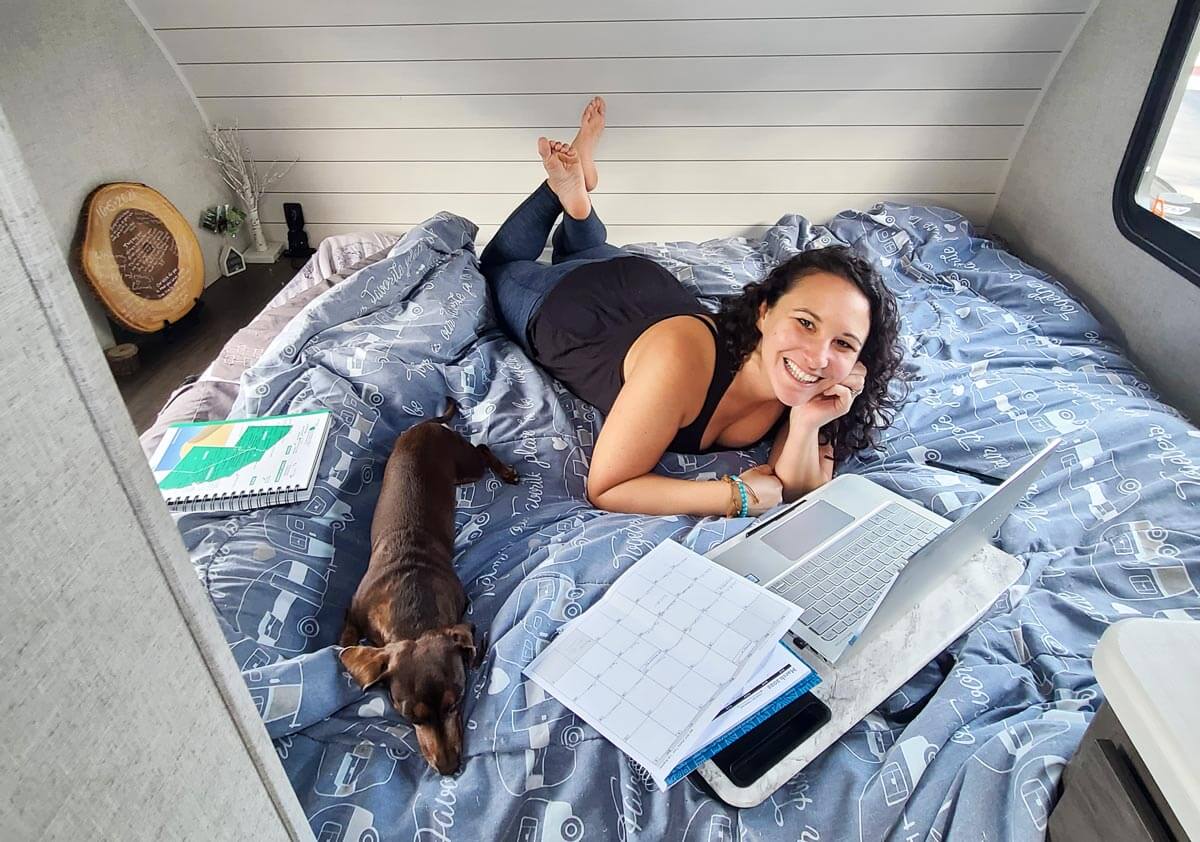
Here are 5 crucial tips to start planning your RV trip across the US.
1. Research Where You Want to Go
Scroll Instagram for ideas, check Pinterest for inspiration, and read blogs for helpful tips. Make a non-negotiable list of places you have to visit.
2. Check the Weather for that Time of the Year
New England isn’t very enjoyable in January. Instead, plan to visit somewhere warm like the Florida Keys. Avoid Tornado Alley in the spring by enjoying Yellowstone National Park. Arizona in summer isn’t as pleasant as Glacier National Park.
3. Use a Calendar and a Pencil
A calendar will help you better keep track of dates when it comes time to make reservations. I’ve found not to get too attached to a plan until sites are booked, so use a pencil and some patience.
4. Map Your Route
You’re going to want a visual of your route, be sure to factor in elevation and traffic routes. Chances are Google is going to direct you through the heart of Atlanta. Consider an alternate route to a surrounding area to avoid the stress.
5. Research and Book Campgrounds
I personally use Campendium as a starting point to find National Parks, State Parks, RV parks, and free camping options. I then add one-night stops with membership programs such as Harvest Hosts , and Boondockers Welcome. Lastly, I research overnight stay rules in the city I’m interested in visiting to confirm we can use truck stops, Home Depot, Walmart parking lots, and other free overnight options . Then it’s time to book!
Best RV Road Trip Routes
I-40 & i-10.
These main highways that run west and east are the easiest for your first RV road trip, but not as scenic as other choices.
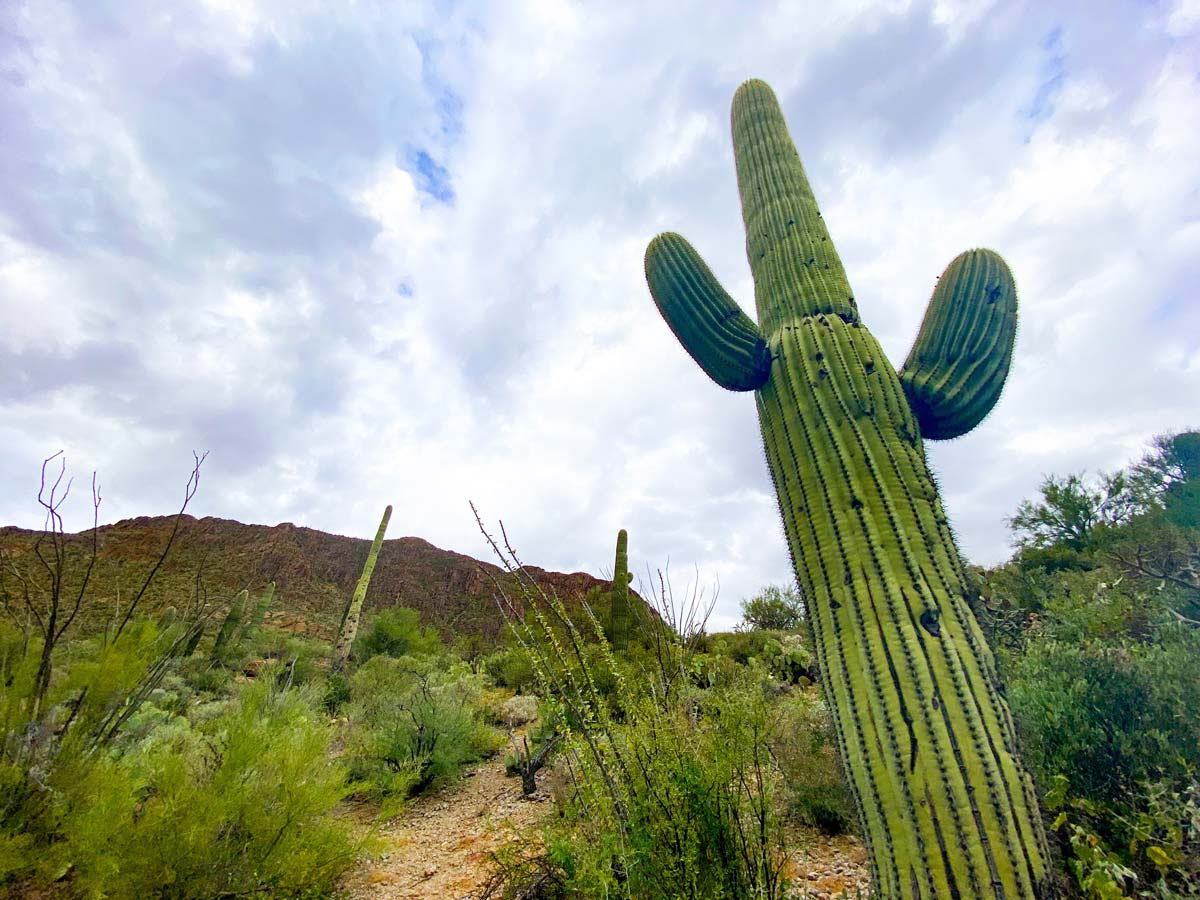
Nevertheless, there are still tons of great places to see along these routes. Including Joshua Tree National Park, Graceland, the Alamo, Saguaro National Park (shown above), and the Grand Ole Opry.
The ultimate road trip. You can still drive portions of the original Mother Road that runs from Chicago to Santa Monica, which have some of the best roadside attractions in the U.S.
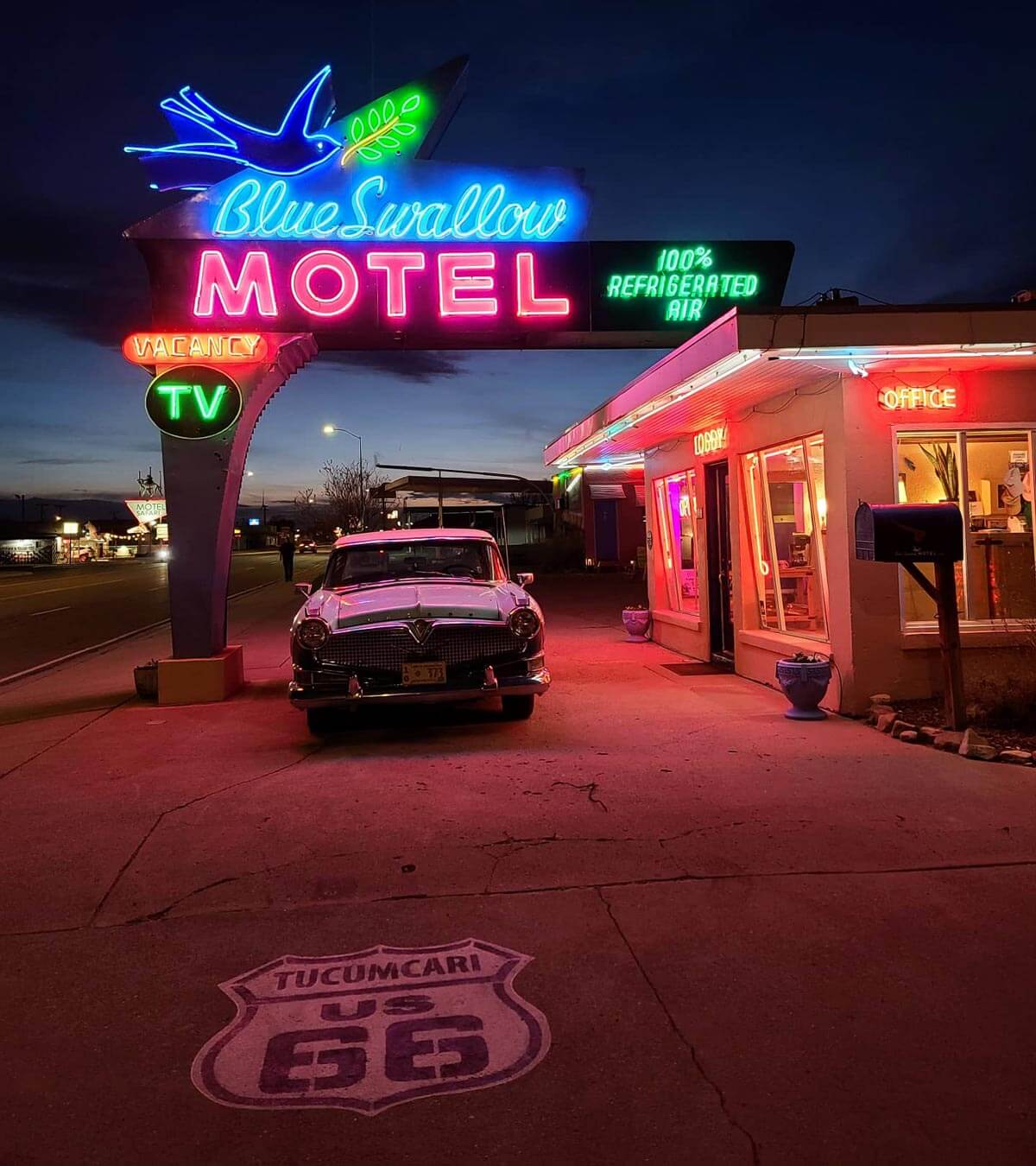
Also, the Grand Canyon National Park is only about 60 miles off the route, the perfect place to add to your RV trip bucket list.
PCH (Pacific Coast Highway)
One of the most scenic drives in the U.S., the Pacific Coast Highway is an iconic road trip route that hugs the California coastline. It runs from Dana Point in Southern Cali to Leggett in Northern California (approximately 650 miles).
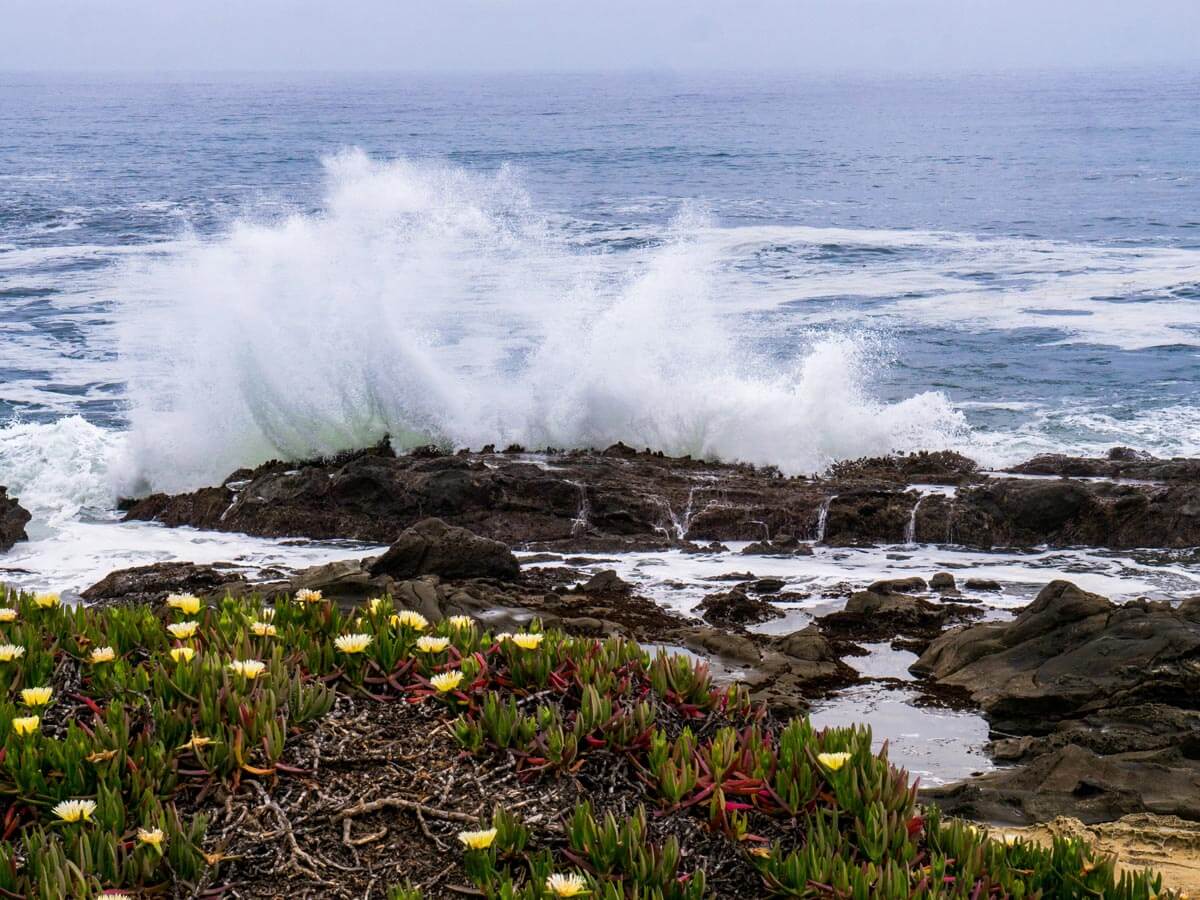
It’s one of the most challenging drives in an RV and is best done in a small motorhome. Portions of Highway 1 are extremely narrow, with steep cliffs. But you’ll be rewarded with breathtaking views of the Pacific Ocean, rugged cliffs, and gorgeous beaches along the route.
Another iconic scenic coastal route is on the east coast and spans the length of Florida. The A1A stretches from Key West all the way to Fernandina Beach, Florida.
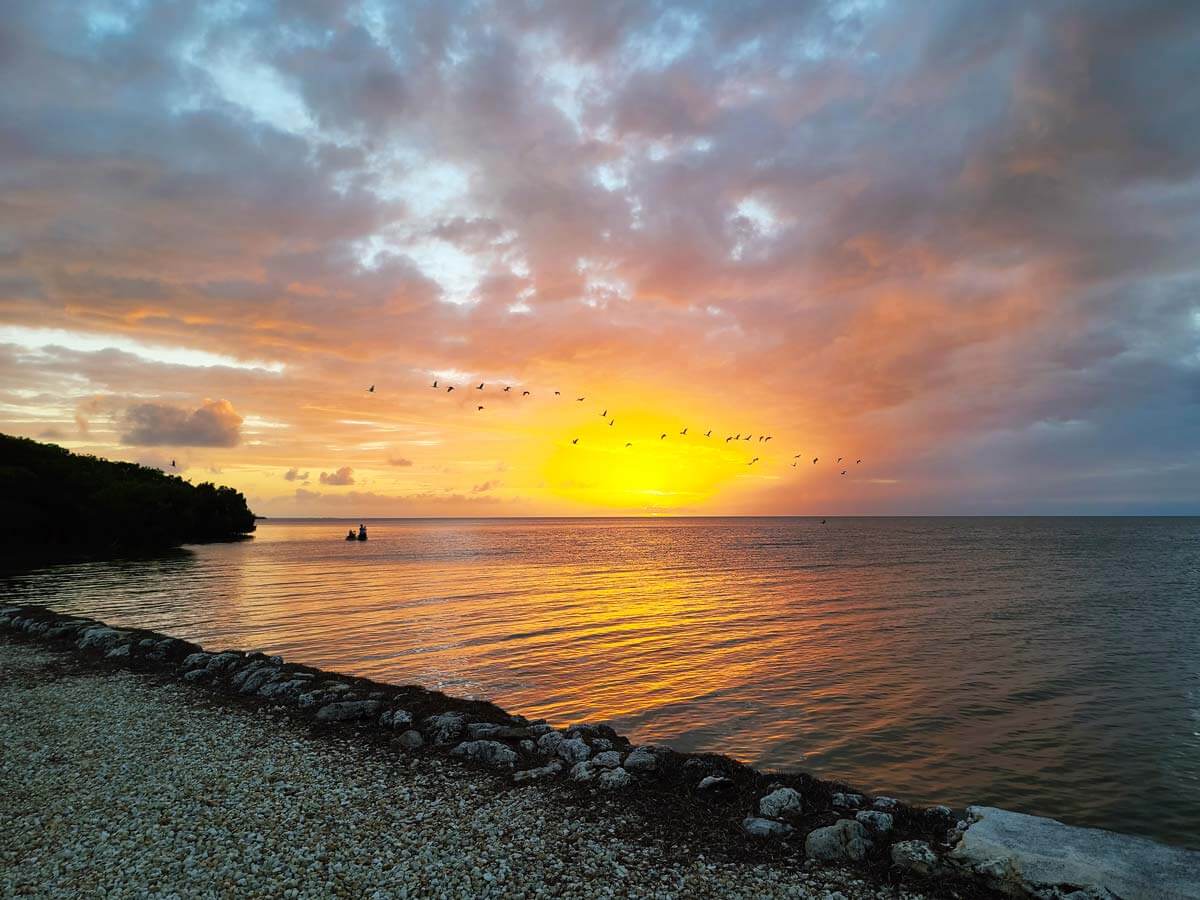
This road trip route offers breathtaking ocean views, charming beach towns, and a glimpse into the region’s rich history and natural beauty. There are many popular locations on this route, so be sure to book campsites early!
READ NEXT: Start planning your RV trip around the county with our nine best RV road trips in the USA .
6 tips for rving the usa.
Here are a few of my best tips for a successful RV trip around the US.

1. BOOK EARLY. This is number one for a reason. RVing has never been more popular!
2. KNOW YOUR RIG. Know both the height and length of your rig, and pay attention to warning signs on the road.
3. TRAVEL SLOW. Low and slow is the name of the game. Plan for short drive days of no more than 250 miles at a time. These travel habits will allow you ample time to enjoy the natural wonders you’re here to see and embrace slow travel.
4. TRAVEL WITH TOOLS. You don’t want to end up on the side of the road unprepared. You’ll need some RV essentials for maintenance and safety on your trip.
5. PAD YOUR SAVINGS. Make sure you have extra savings. You’re going to experience both good and bad unexpected expenses with this RV lifestyle. Tire blowouts, as well as unplanned adventures, are bound to happen.
6. SIGN UP FOR RV MEMBERSHIPS. Save on RV expenses where you can by joining RV discount clubs.
- A Good Sam membership gives you discounts at Camping World and offers fuel discounts at Flying J & Pilot stations.
- Sign up for campground discounts such as Passport America and Thousand Trails to save on camping spot costs.
- Don’t forget to ask for weekly discounts if you stay at a park longer than a week.
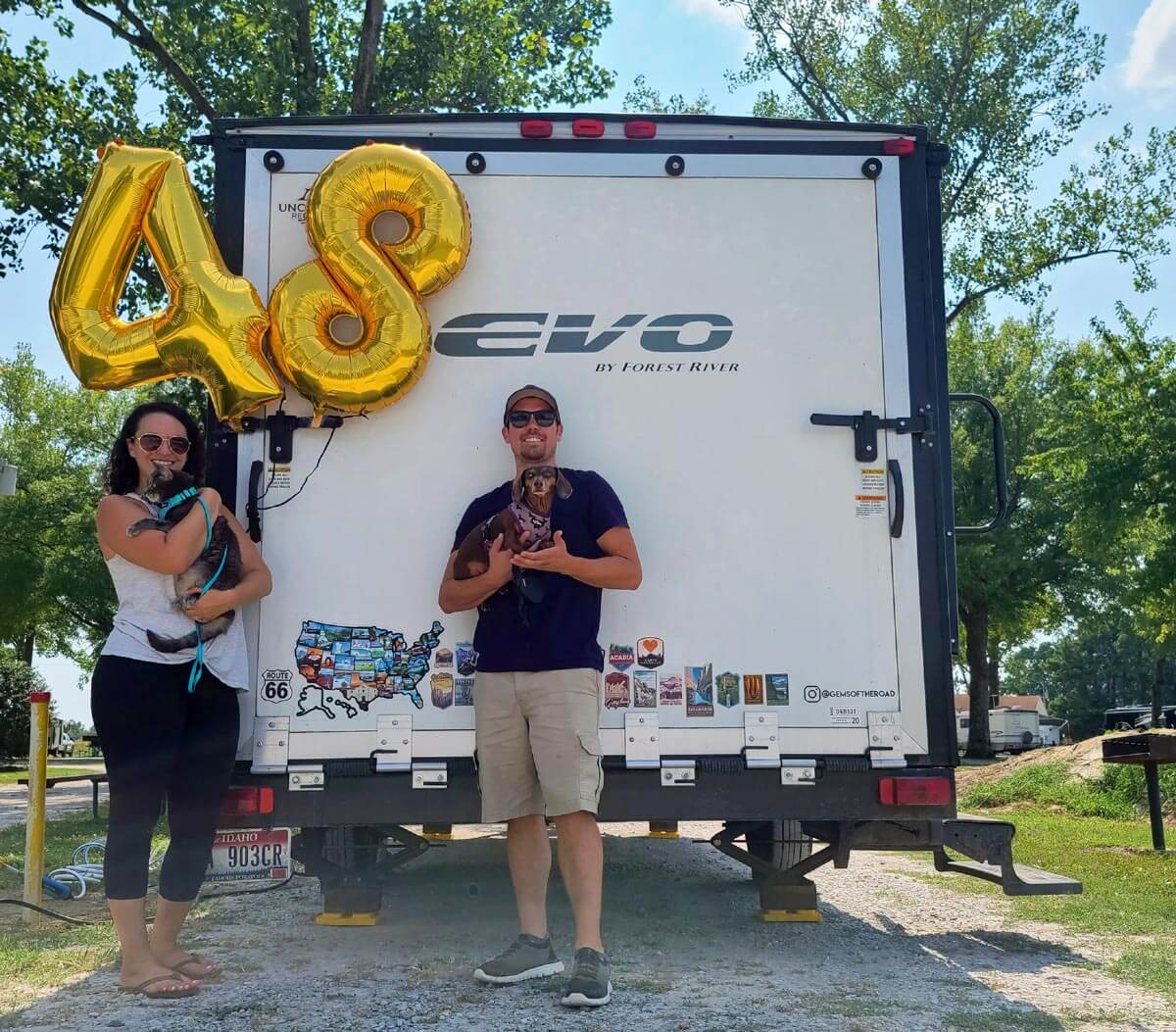
Whether it takes you six months or six years to see all lower 48 states, my biggest piece of advice I can give you is JUST DO IT!
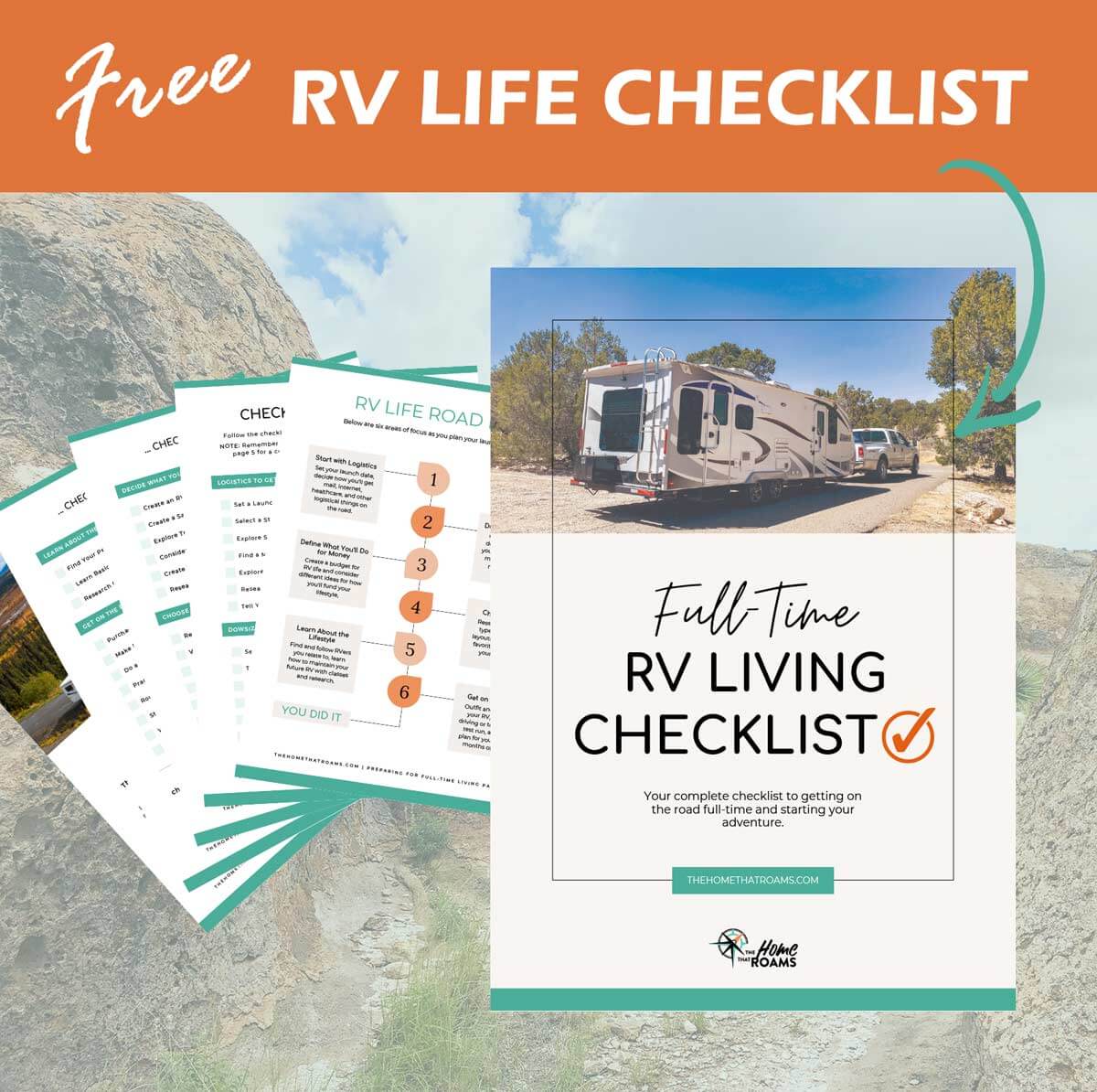
Your Guide to Launching RV Life
Road Map & Checklist – Start Now!
Unsubscribe at any time. View our privacy policy .
RELATED ARTICLES
- Best RV Road Trips: 9 Top Routes Around the USA
- What Stores Allow Overnight RV Parking?
- Best Discount Fuel Cards for RV Owners & How to Save at the Pump
- An Honest Harvest Hosts Review: Is It Worth It?
Want more beginner tips on RV living and travel?
Check out our guide to preparing for full-time RV living, including info on choosing an RV, the pros and cons of the lifestyle, RV gear, and more.
Like this post? Save it on Pinterest for later.
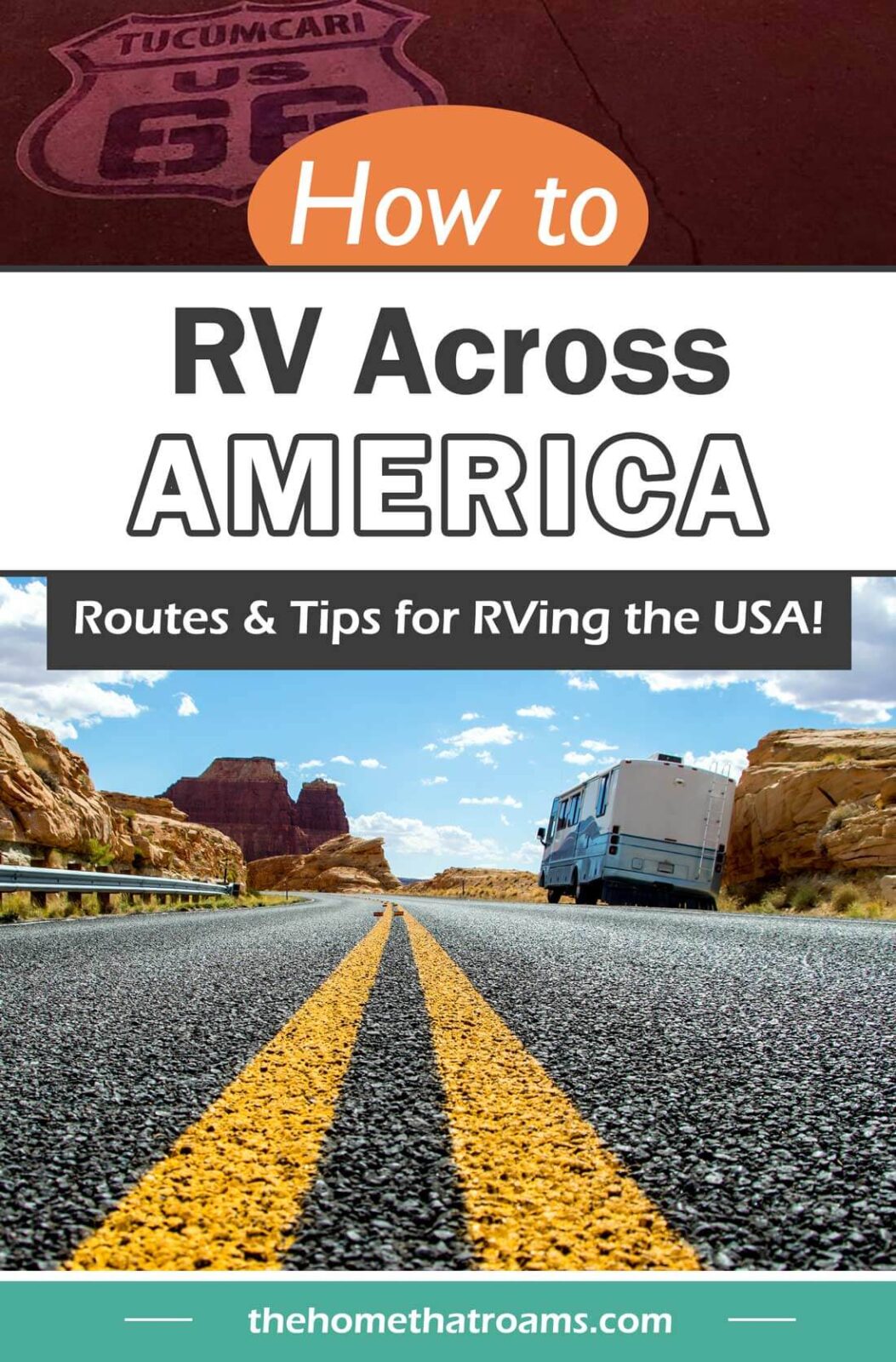
Kerisa has been traveling the U.S. with her husband and fur kids in their 89 sq. ft. home on wheels since 2020 and has been to all 50 states. She is the copywriter/owner of Outside Voice Collective and blogger at the Traveling Tiongsons. You'll most likely find her behind the wheel on a scenic byway or relaxing around a campfire with a good glass of wine at the end of the day.
Leave a Reply Cancel reply
Your email address will not be published. Required fields are marked *
Sign Me Up!
Learn how to live in an rv.
Get weekly tips on how to start traveling full-time in an RV.
View our privacy policy .
Privacy Overview


Travels with Ted
10 Epic Bucket List RV Road Trips in the US
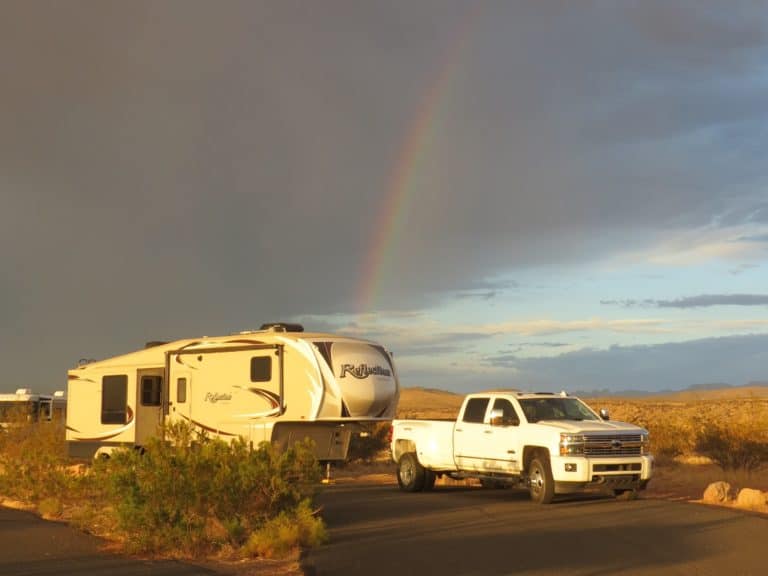
This post may contain affiliate links. See our affiliate disclaimer here.
I’ve lived in an RV since 2016, and traveled thousands of miles across the country (and into Mexico and Canda). In this guide to the best bucket list road trips in the USA, I share my favorite RV road trips.
Ready to start planning your own RV trip across America? Let’s get started.
- 1.1 Renting an RV
- 1.2 Finding Campgrounds
- 1.3 Buying Gear for your RV Road Trip
- 2.1 Olympic Peninsula
- 2.2 Utah National Parks
- 2.3 Route 66
- 2.4 California’s Pacific Coast
- 2.5 Blue Ridge Parkway
- 2.6 South Florida
- 2.7 Upper Peninsula of Michigan
- 2.8 Columbia River Gorge
- 2.9 Las Vegas to the Grand Canyon
- 2.10 North to Alaska
Planning your RV Road Trip
If you already an experienced or full-time RVer, go ahead and skip down to the bucket list RV road trips . Otherwise, here are some key planning tools to utilize before your first RV trip.
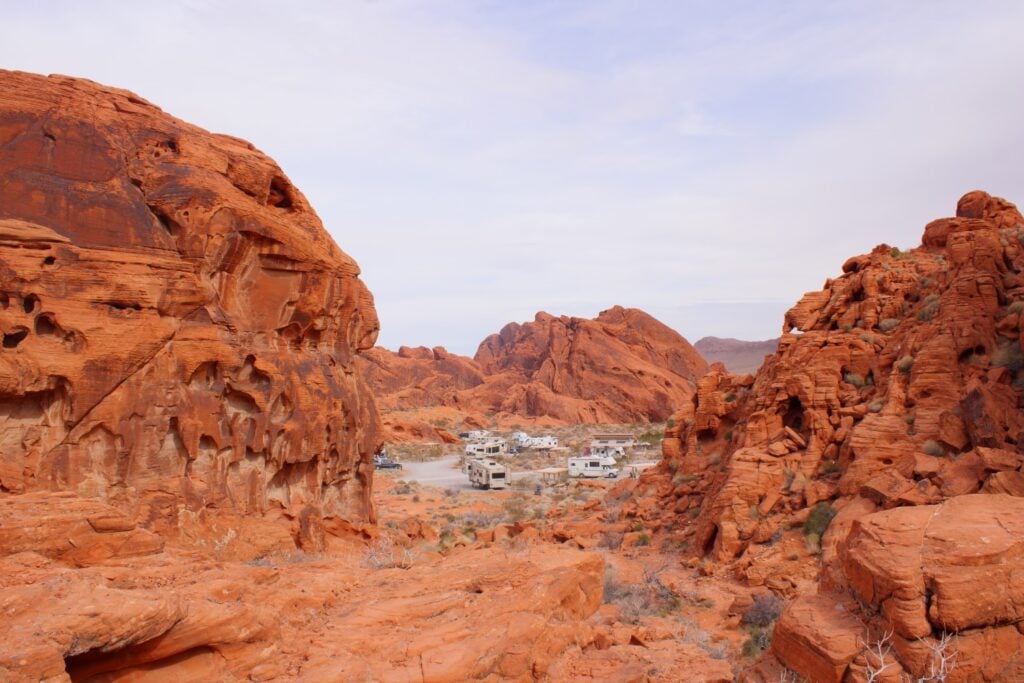
Renting an RV
If you do not already own an RV, it is best to rent a rig for your first RV road trip in the USA. A rental RV allows you to test drive the type, layout and travel style of an RV before you make a large investment.
RVshare allows you to rent fifth wheels, travel trailers and motorhomes directly from local owners. They have every type of rig available, and you can filter by price and features to pick the perfect RV.
Finding Campgrounds
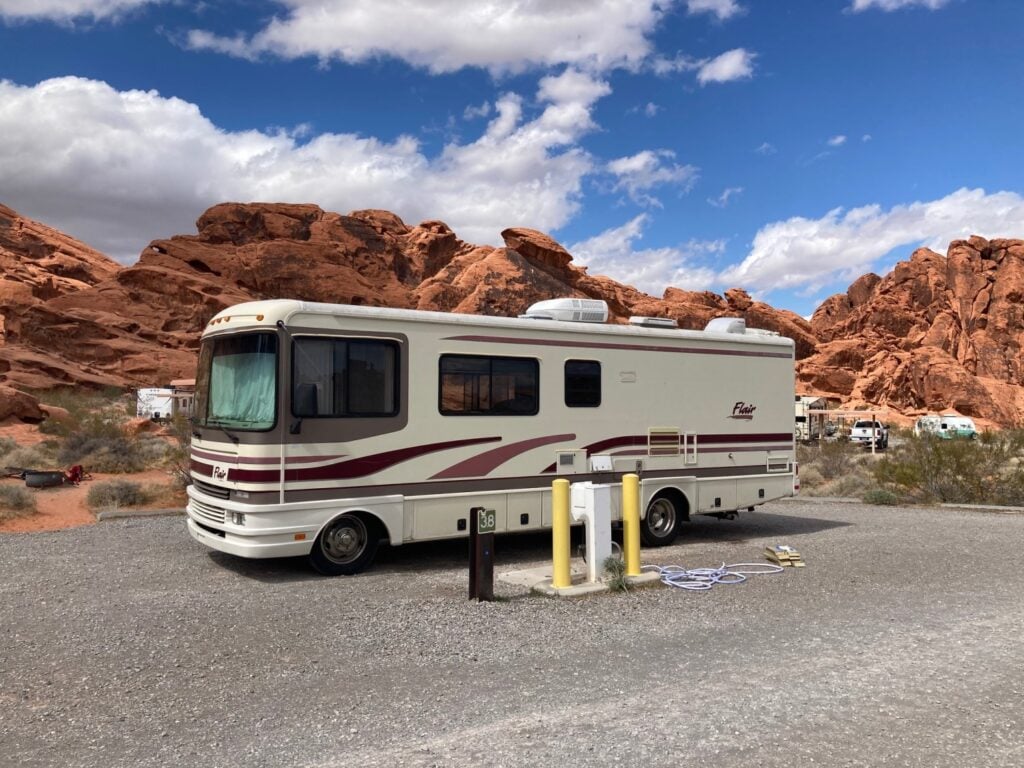
After you’ve secured an RV, you need to find places to sleep. Fortunately, there are several great apps to help you find campgrounds and RV parks in the USA. If you are visiting an area during the peak season (i.e. Winter in Florida) you will need to make campground reservations in advance.
However, if you are traveling during less busy times, it is best to leave a few open days between reservations so you can be more spontaneous.
To find RV parks and campgrounds, download the AllStays Camp & RV app ($9.99). The AllStays app has an interactive map that allows you to find campsites directly along your route.
AllStays has the most comprehensive list of campgrounds and RV parks for people RVing in the USA. The app also shows truck stops, dump stations and RV services so you can easily find fuel and supplies.
For free RV camping , use the Campendium website to find no cost RV campsites. Free camping is a great way to save money and find more secluded locations.
However, most free campsites do not offer water, electric or sewer hook-ups, so you should be prepared to “rough it.” If you plan on dry camping or boondocking at free campsites, choose a rental RV that has a generator on board.
If you are planning an extended RV round trip, consider joining one or more RV membership clubs to enjoy discounted camping fees.
Buying Gear for your RV Road Trip
The last step in the planning process for an RV road trip is buying all the gear you need. Review our Amazon list of must have RV supplies and either buy them or verify that your rental RV comes equipped with the proper gear.
I also highly recommend buying a road trip journal to record your adventures and experiences RVing in the USA.
10 Best RV Road Trips in the USA
Olympic peninsula.
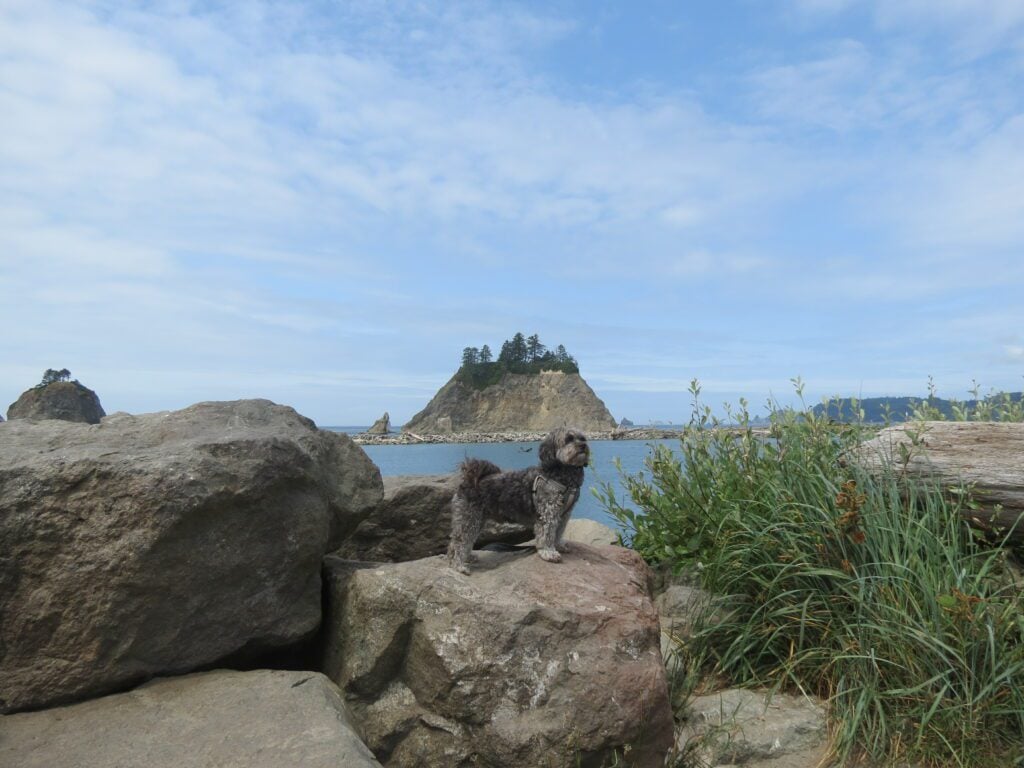
Driving highway 101 around the Olympic Peninsula is a short but sweet RV road trip. The complete Olympic Peninsula rod trip is just over 300 miles, so it can easily be completed in a few days.
On the other hand, there is so much to see in this region you could also stay for weeks. The main attraction on the Peninsula is Olympic National Park which features a lush rain forest, stunning mountain peaks, crystal clear lakes and the Pacific Coast.
There are plenty of RV campground options in the area. There are several private campgrounds just off highway 101 and there are 10 campgrounds in the National Park that can accommodate RVs.
Most National Park campsites are designed for RVs up to 21 feet long, and none of them accept rigs over 35 feet. If you plan to camp in the park, make sure to travel in a smaller RV.
While the National Park is the main feature, there are several other sights to see along this route. For incredible views, take a side trip to Cape Flattery, the most northwesterly tip of the contiguous 48 states.
To reach Cape Flattery, first head to the town of Neah Bay from highway 112. In Neah Bay, go as far west as you can, follow signs to Cape Flattery Road and head south. After 7.7 miles the road will take you to the trail head parking lot.
Don’t forget to stop in Neah Bay and purchase a Makah Recreation Pass , which is required to hike on the trail. The trail is an easy 1.5 mile round trip that winds through the forest and ends in stunning views of the Pacific Ocean.
Utah National Parks

Utah has five National Parks with jaw dropping scenery. Combining all five parks into a single road trip is an unforgettable adventure, and one of my personal favorite experiences RVing in the USA.
Start your adventure in Zion National Park then drive on Bryce Canyon, Capitol Reef, Arches and Canyonlands. Allot at least 2 days in each park to make sure you have ample time to hike and relax. Since most of the trails in National Parks are not pet-friendly, this is not a great RV road trip with dogs.
All of the Utah National Parks, except Canyonlands, have RV-friendly campgrounds that can be reserved in advance. Reservations are accepted 6 months ahead of time and should be made exactly 6 months in advance for summer reservations.
None of the NPS campgrounds offer electric hook-ups, so RVers looking for more comfort should stay in private campgrounds near the parks. Reservations for RV parks also need to be made at least six months in advance to guarantee availability.
Don’t forget to add a few Utah State parks into your road trip itinerary. Dead Horse Point State Park, located just outside of Canyonlands, offers dramatic views of the Colorado River and the pinnacles of Canyonlands.
This state park has two campgrounds with 30 and 50 amp electric outlets. An hour from Zion, Sand Hollow State Park is a great summer stop if you are looking to get in the water.
The main feature of this state park is a refreshing reservoir with boat rentals. Their Westside campground also offers spacious campsites with full hook-ups.
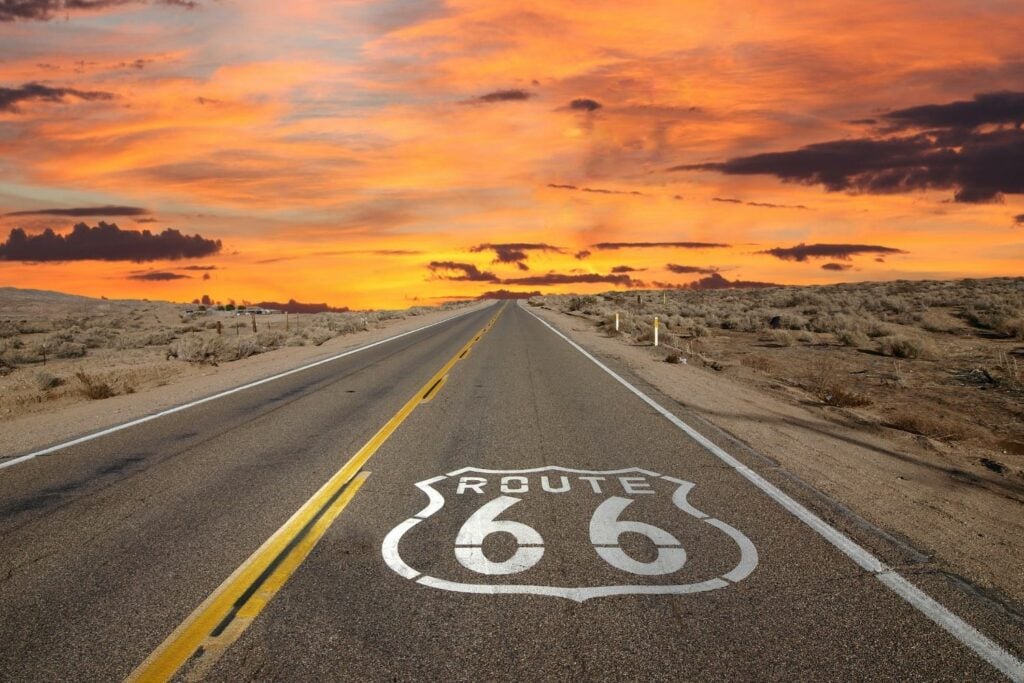
Route 66, also know as the Mother Road, is the most iconic and celebrated RVing route in the USA. Historic Route 66 covers over 2,400 miles, starting in Chicago and ending at Santa Monica, California.
For the classic experience, I would recommend sticking to the westernmost portion of the route. This area features many kitschy attractions that will take you back in time. Start your journey in Amarillo, TX and take Route 66 all the way to the Pacific Ocean in California.
There are many RV campgrounds along historical Route 66. Simply use the AllStays app to find campgrounds with good reviews at your desired stopping points.
State park campgrounds are a good option if you are looking to incorporate more outdoor adventures into your road trip. Consider camping at Santa Rosa Lake, Homolovi Ruins and Malibu Creek State Parks.
Hualapai Mountain Park, 11-miles off of the road in Arizona, offers a great break from the desert. The campground sits in the Hualapai Mountain Range, so you can enjoy views of the desert below from a cooler elevation.
You want to take your time driving down Route 66, so you have plenty of time to stop for roadside attractions and detours. Starting in Amarillo, check out the Cadillac Ranch, an art installation made using old Cadillac cars.
During your RV road trip, stop at the ghost town of Oatman, Arizona that has a friendly local population of wild burros.
California’s Pacific Coast
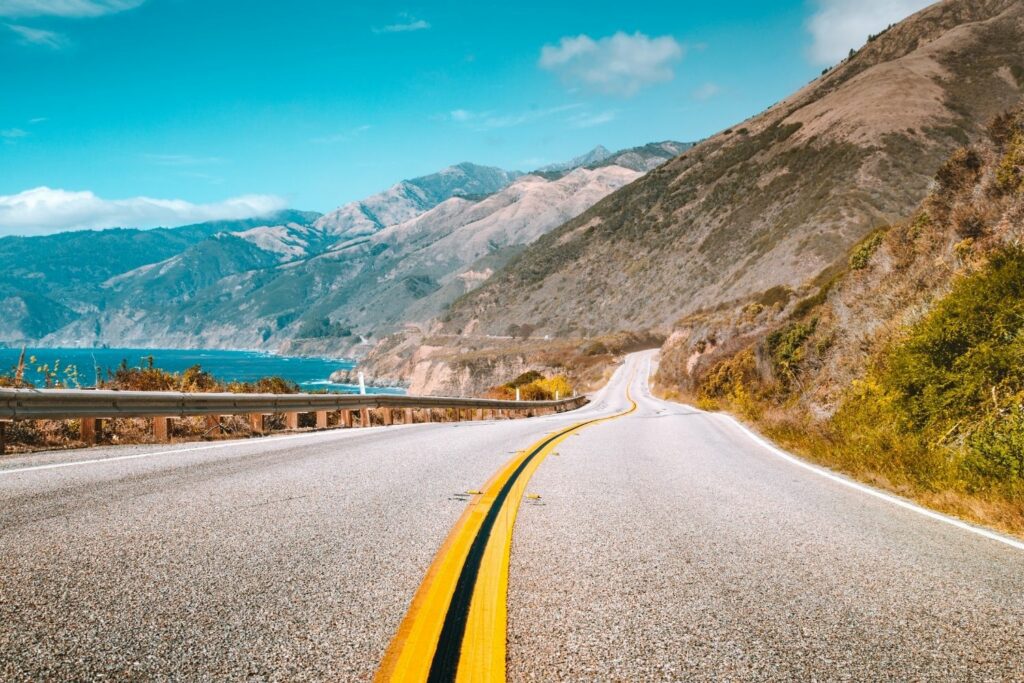
The Pacific Coast Highway (Highway 1) hugs the Pacific Coast of California for 650 miles. The route is best driven from north to south, so you are on the ocean side of the road for the entire drive.
This coastal road trip is not for the faint of heart. The route features winding turns, small shoulders and big drop offs. I would recommend this RV road trip for more experienced drivers not first time RVers. Drive slow and plan short days to keep this drive fun and safe.
There are several state park campgrounds and private RV parks available along Highway 1. Spend a few days at the San Francisco RV Resort just outside of the city. This resort is pricey, but it features stunning ocean views, full hook-ups and easy access to the city.
Also stop at Doheny State Beach campground in Dana Point. This campground does not have any hook-ups, but there are campsites available right on the beach.
One of the most iconic stops along the California Coast is Big Sur. Plan to spend at least a few days of your road trip exploring this area.
The hike to McWay Falls should definitely be on your travel and adventure bucket list. The trail is less than a mile, but the views are incredible. You can access the trail head directly off of Highway 1.
Blue Ridge Parkway
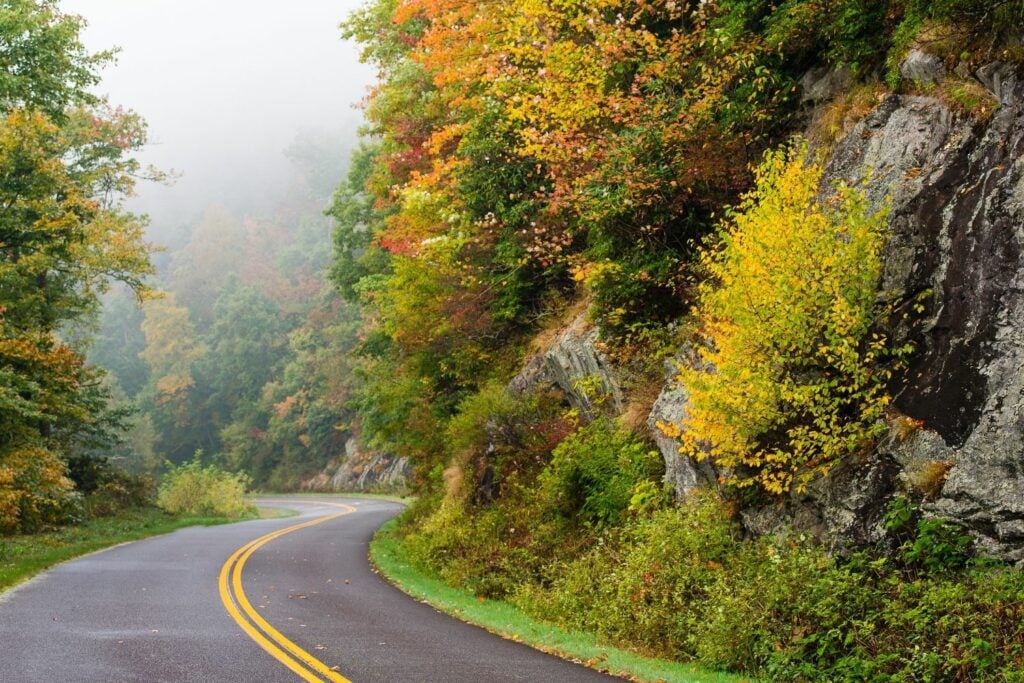
The Blue Ridge Parkway stretches through the mountains from Afton, Virginia to Cherokee, North Carolina (my home state). This road is an iconic route for people RVing in the USA.
There are plenty of overlooks and the speed limit never exceeds 45 mile per hour, making for a leisurely RV road trip. The route has many sweeping curves, but is generally easy to drive without many tight turns. The vistas are stunning during the peak fall season when the leaves are changing, but be prepared for crowds during this time.
There are eight National Park Service Campgrounds on the Blue Ridge Parkway. Most of these campgrounds do not have hook-ups, but they offer potable water, bathrooms with flush toilets, picnic tables, fire rings and RV dump stations.
These campgrounds are open from May to October for a fee of $20 per night. If you are looking for higher-end accommodations, there a plenty of private RV parks a short drive off the parkway. Near Asheville, North Carolina, spend a night or two at the stunning mountaintop RV sites at Mama Gertie’s Hideaway Camp.
Views and hiking are the two main features of the Blue Ridge Parkway. One of our favorite hikes in the area is Crabtree Falls. The trail head is located at milepost 339.5.
There are two trail options: an easier 3 mile out and back hike on the same trail or a more strenuous 3.5 mile loop trail that climbs a ridge above the falls. The main feature of the hike is the 70 foot waterfall but there are also beautiful wildflowers in the early summer.
South Florida
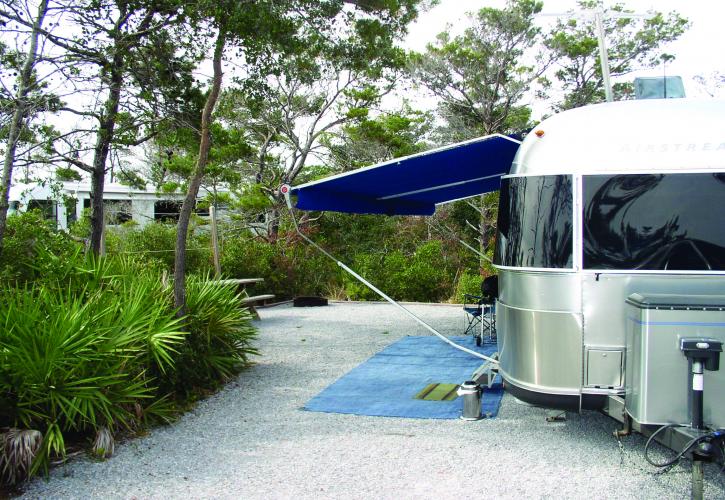
If you are looking for a winter destination to RV in the USA, look no further than the Sunshine State. While many RVers park in one spot for the winter, a Florida road trip is a much better adventure.
I recommend starting your Florida road trip near Everglades National Park and driving down the Florida Keys.
Start your trip at the Miami Everglades RV Resort, a full hook-up RV park near the Everglades that offers amenities including a pool and game room. In the Keys, Sunshine Key RV Resort is another high-end RV park located right on the water.
For a more affordable camping option in the Keys, stay at Bahia Honda State Park which offers campsites with electric for $38 per night. Be sure to make your campground reservations six to twelve months in advance to avoid being stuck without a place to stay.
If you make it all the way to Key West, consider leaving your RV behind for the day to visit Dry Tortugas National Park. The park which is an island 70 miles west of Key West is only accessible by boat or seaplane.
Daily ferries shuttle visitors from Key West to the park, or you can arrive in style by flying in with Key West Seaplane Adventures. Once you arrive, you can spend the day swimming, snorkeling and exploring the 19th century fort.
Upper Peninsula of Michigan
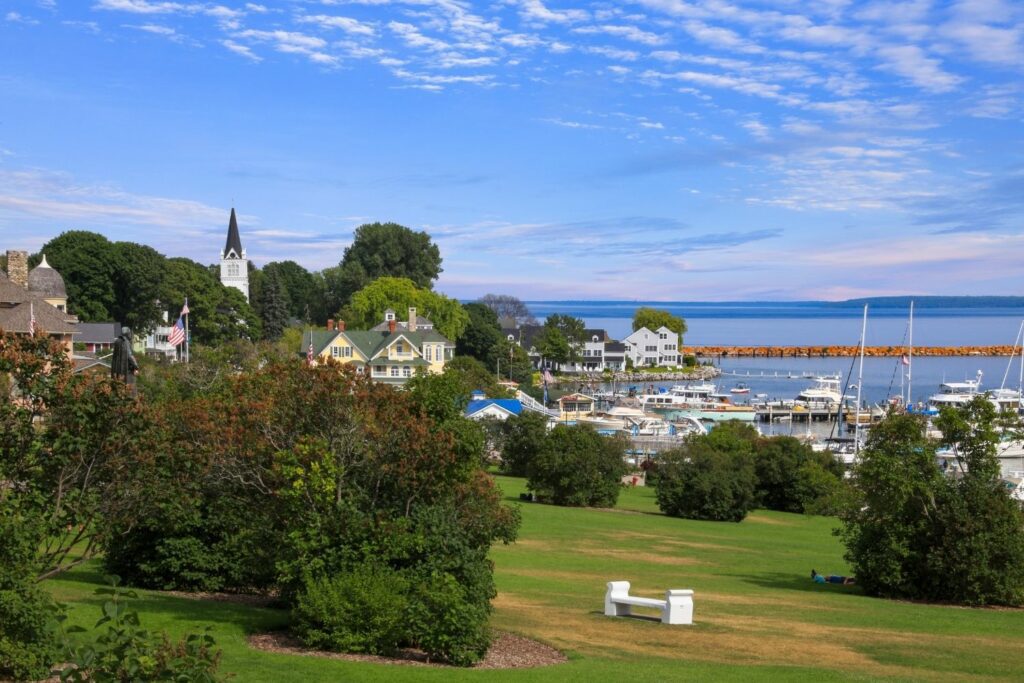
The Upper Peninsula of Michigan (The U.P.) is a beautiful natural playground for campers RVing in the USA. Summer is the best time to visit when you can count on warm, pleasant weather.
The U.P. is accessed from I-75 on the lower peninsula of Michigan. From there, you can plan your own route around the U.P.
Straits State Park is a great place to start and end your U.P. RV road trip. Located right after the bridge onto the Upper Penninsula, the park has two campgrounds with electric hook-ups. From this location, you can easily access the ferry to car-free Mackinac Island.
Also consider staying at Indian Lake State Park which offers lake front campsites. There are also plenty of private campgrounds on the U.P. for the remainder of your road trip.
Just 10 minutes from Indian Lake State Park is The Big Spring ( Kitch-iti-kipi ) . The natural spring has crystal clear blue water that makes for a beautiful photo opportunity.
While you can’t swim in the spring, the park offers a self-operated observation raft that you can take out onto the water. Through observation windows on the raft floor, you can see trout swimming below. Also, don’t forget to eat a Pasty, a local meat pie delicacy.
Columbia River Gorge
The drive along the Columbia River Gorge is one of the most scenic drives in the Pacific Northwest. The gorge reaches heights of 4,000 feet, and the river serves as the boundary between Oregon and Washington.
I recommend starting in Troutdale, Oregon and driving on Interstate 84 to at least Hood River. This trip is a very short drive, but you can extend the trip by taking detours over the river to the Washington side.
This is a perfect first time RV road trip, allowing you to drive just 30 minutes between RV parks.
In Troutdale, stay at the Sandy Riverfront RV resort. This full hook-up campground offers direct access to the Sandy River where you can swim and float on hot summer days.
At the end of your trip, stay at the Blue Barn Grill & RV park on the Washington side of the river. In between, small RVs (20 feet max) can stay at the Eagle Creek campground within the National Scenic Area.
Even though the Columbia River Gorge is a short trip, it is not lacking in activities. There are stunning waterfalls, local breweries and hundreds of hiking trails to explore. One can’t miss hike along the gorge is Beacon Rock.
The trail is a one-mile hike up the 848 foot Beacon Rock, the core of an ancient volcano. The hike involves many switchbacks and steep drop-offs, but handrails make it safe for even casual hikers. At the top you are rewarded with vast views of the Columbia River Gorge.
Las Vegas to the Grand Canyon

If you are looking to incorporate both city life and the great outdoors into your RV road trip, consider driving from Las Vegas to the Grand Canyon. The drive from Las Vegas to the south rim is just over four hours, but you can spend a significant amount of time at each destination.
If you are renting an RV , you can take a round trip route so you can fly in and out of Las Vegas. Alternatively, this trip can be combined with a Utah National Park or Route 66 road trip for a longer adventure.
There are many large RV resorts around Las Vegas that offer pools, outdoor activities and shuttles to casinos. If you want to stay right on The Strip, camp at Circus Circus RV Park. The campground offers full hook-up sites on the Circus Circus property, and campers have access to all the same amenities as hotel guests.
Once you reach the Grand Canyon , stay at the Trailer Village campground which offers full hook-up RV sites close to the south rim of the canyon.
Don’t forget to stop along the way to the canyon and explore Arizona a little more. Stop in the town of Chloride for some history and culture. The old silver mining town now features some interesting art with many residents creating junk art sculptures on their property.
Just outside of town, park the RV and walk 1.5 up a rough dirt road to see the murals of Chloride miner, Roy Purcell. Painted in 1966, these murals are a sight to see, covering 2,000 square feet of rocks and granite.
North to Alaska
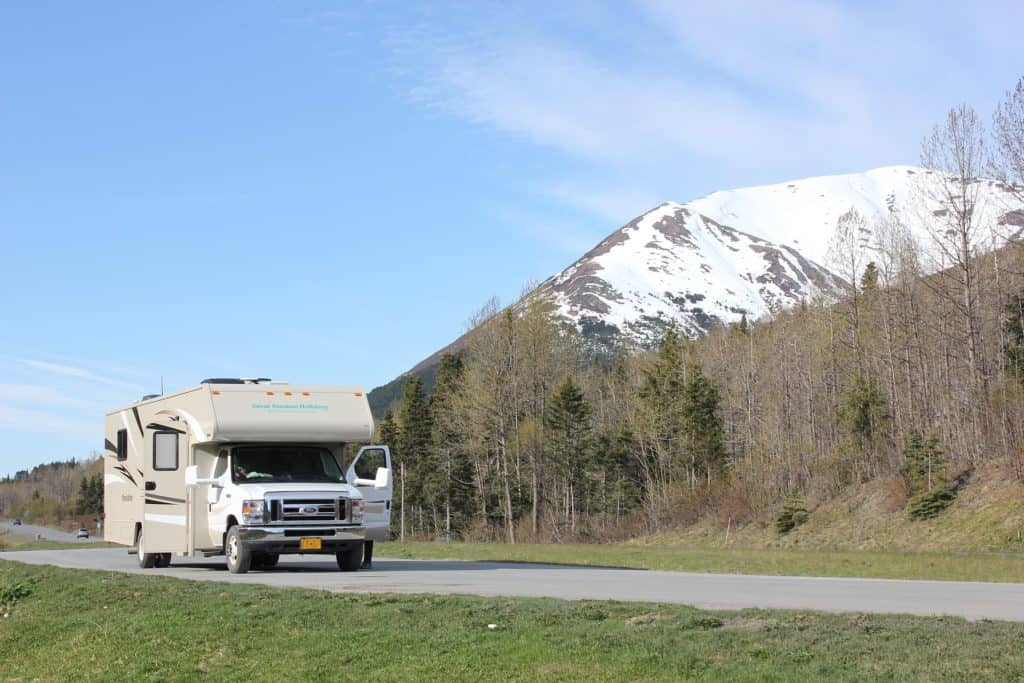
Once you have completed some shorter road trips RVing in the USA, consider upping your road trip game and driving to Alaska. Leaving from Washington state, you can drive through British Columbia and The Yukon to reach Alaska.
Allow an absolute minimum of one month for this RV road trip, so you have plenty of time for driving and exploring. Ideally, this RV road trip would take two to three months so you have plenty of time to explore Western Canada as well.
On the route to Alaska, you will find plenty of RV parks off the highway. The AllStays app will help you find campsites in the US, as well as Canada.
Once you arrive in Alaska, the whole state is your campground. Alaska is one of the few places in the USA where it is legal to camp almost anywhere. Check out Call to Wander’s post for some Alaska campsite recommendations.
Once you reach Alaska, be sure to make it to Denali National Park. The park features Denali, the highest peak in North America, as well as plentiful wildlife.
The only entrance to the park is 240 miles north of Anchorage off Alaska Highway 3. There are RV-friendly campgrounds within the park, so you can enjoy the experience of camping right beside the natural wonders.
If you are new to RV travel, download our free RV setup and departure checklists to guide you when parking and packing up the RV.
Also, save our list of 250 road trip questions to help pass the time while you are driving.
Ready to hit the road and go RVing in the USA? Comment below to tell us which RV road trip is on the top of your bucket list.
Happy Camping!
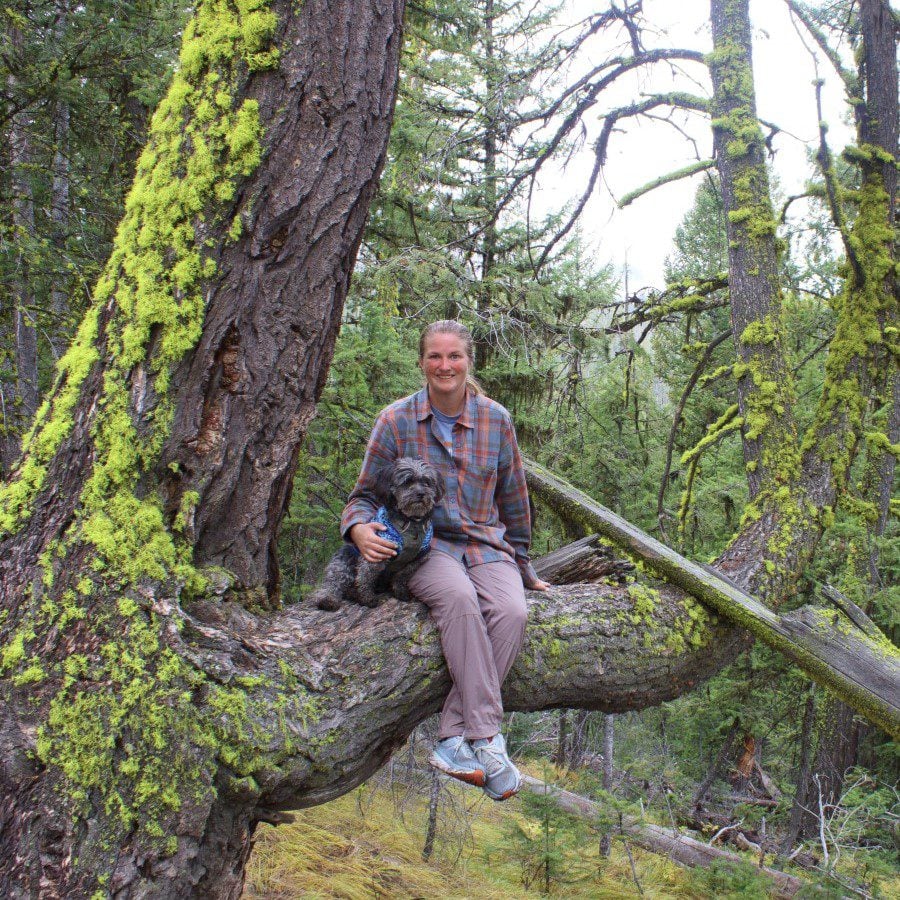
Christina Pate is a seasoned full-time RVer who, along with her husband Justin, has journeyed across the US, Canada, and Mexico. Drawing from her extensive travels, RV repairs and RV renovations, she founded Travels with Ted to guide and inspire fellow RV enthusiasts. Christina is also the co-author of The Owner’s Guide to RV Maintenance and the creator of My RV Log Book .
- Credit cards
- View all credit cards
- Banking guide
- Loans guide
- Insurance guide
- Personal finance
- View all personal finance
- Small business
- Small business guide
- View all taxes
You’re our first priority. Every time.
We believe everyone should be able to make financial decisions with confidence. And while our site doesn’t feature every company or financial product available on the market, we’re proud that the guidance we offer, the information we provide and the tools we create are objective, independent, straightforward — and free.
So how do we make money? Our partners compensate us. This may influence which products we review and write about (and where those products appear on the site), but it in no way affects our recommendations or advice, which are grounded in thousands of hours of research. Our partners cannot pay us to guarantee favorable reviews of their products or services. Here is a list of our partners .
5 Great RV Road Trip Routes in the United States
Many or all of the products featured here are from our partners who compensate us. This influences which products we write about and where and how the product appears on a page. However, this does not influence our evaluations. Our opinions are our own. Here is a list of our partners and here's how we make money .
RV camping is one of the most exciting and rewarding ways to explore the United States. Few modes of transport allow travelers to cover so much distance for little money while coming face-to-face with the nation's natural treasures.
We've come up with five route suggestions for folks looking to hit the road and tour America's most beautiful natural preserves.
» Learn more: The beginner’s guide to renting an RV
California loop
Distance: 2,226 miles
California offers a cornucopia of natural beauty, from towering redwood forests to dusty deserts to breathtaking seascapes and shorelines. This 14-destination loop will take RV travelers across the entire state. While we start our journey just northeast of San Diego and go in a clockwise loop, you can use any location as your starting point. We've highlighted some of the top nature and camping destinations across California, but feel free to improvise as there is no shortage of parks and preserves in the Golden State.
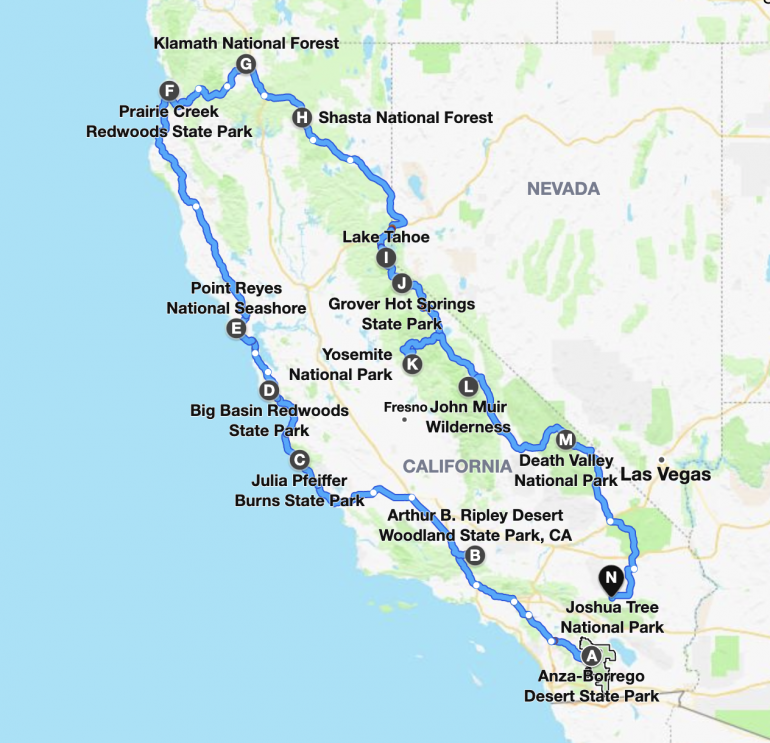
A. Anza-Borrego State Park
B. Arthur B. Ripley Desert Woodland State Park.
C. Julia Pfeiffer Burns State Park.
D. Big Basin Redwoods State Park
E. Point Reyes.
F. Prairie Creek Redwoods State Park.
G. Klamath National Forest.
H. Shasta National Forest.
I. Lake Tahoe.
J. Grover Hot Springs.
K. Yosemite National Park.
L. John Muir Wilderness.
M. Death Valley.
N. Joshua Tree National Park.
Rocky Mountains
Distance: 2,826 miles
The Rocky Mountains stretch over 3,000 miles from New Mexico to British Columbia and offer a life's worth of exploration opportunities. You could spend weeks at Yellowstone and Grand Teton alone. We've chosen just a few of the more popular destinations and suggest you set aside a hefty chunk of time for this trip. Again, the locations are ordered clockwise, but you can jump in at the most convenient destination. We begin in southern Idaho.
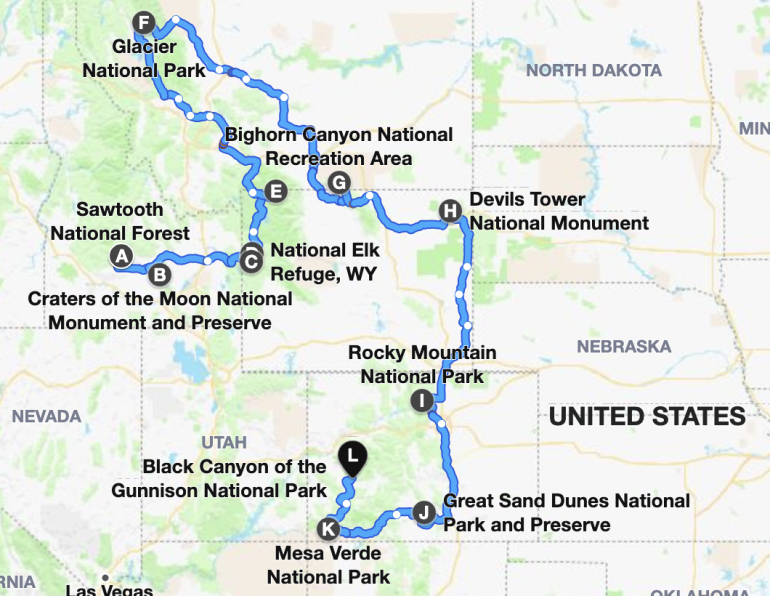
A. Sawtooth National Forest, Idaho.
B. Craters of the Moon Monument, Idaho.
C. National Elk Refuge, Wyo.
D. Grand Teton National Park, Wyo.
E. Yellowstone National Park, Mont.
F. Glacier National Park, Mont.
G. Bighorn Canyon National Recreation Area, Mont.
H. Devil's Tower National Monument, Wyo.
I. Rocky Mountain National Park, Colo.
J. Great Sand Dunes National Park, Colo.
K. Mesa Verde National Park, Colo.
L. Black Canyon of the Gunnison National Park, Colo.
Distance: 2,332 miles
The classic American road trip, Route 66 spans from Chicago to Los Angeles. Unlike the other trips we list here, Route 66 is less a nature excursion and more a nostalgic cruise along a collection of museums, diners and roadside attractions. Route 66 has hundreds of potential stops; we've chosen just a few. If you plan on taking Route 66 both away from home and back toward it, remember to leave plenty of attractions for the return trip.
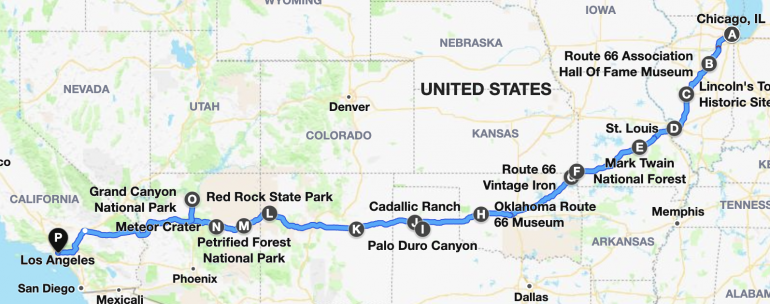
A. Chicago, Ill.
B. Route 66 Association Hall of Fame and Museum, Ill.
C. Lincoln's Tomb, Ill.
D. St. Louis, Mo.
E. Mark Twain National Forest, Mo.
F. Galena Mining and Historical Museum, Kan.
G. Route 66 Vintage Iron Motorcycle Museum, Okla.
H. Oklahoma Route 66 Museum, Okla.
I. Palo Duro State Park, Texas
J. Cadillac Ranch, Texas
K. Route 66 Auto Museum, N.M.
L. Red Rock State Park, N.M.
M. Petrified Forest National Park, Ariz.
N. Meteor Crater, Ariz.
O. The Grand Canyon, Ariz.
P. Los Angeles, Calif.
New England loop
Distance: 1,515 miles
A road trip around New England offers a balanced blend of verdant forests, rocky seascapes, colonial history and gorgeous seaside towns. We start our loop in upstate New York, heading east and north into the parks of upper New England. After Acadia, head south along the coast for breathtaking ocean views. A collection of historic New England towns (Salem, Cape Cod and more) will provide a break from the greenery and a lesson in American history. Pick up the route at the location closest to you.
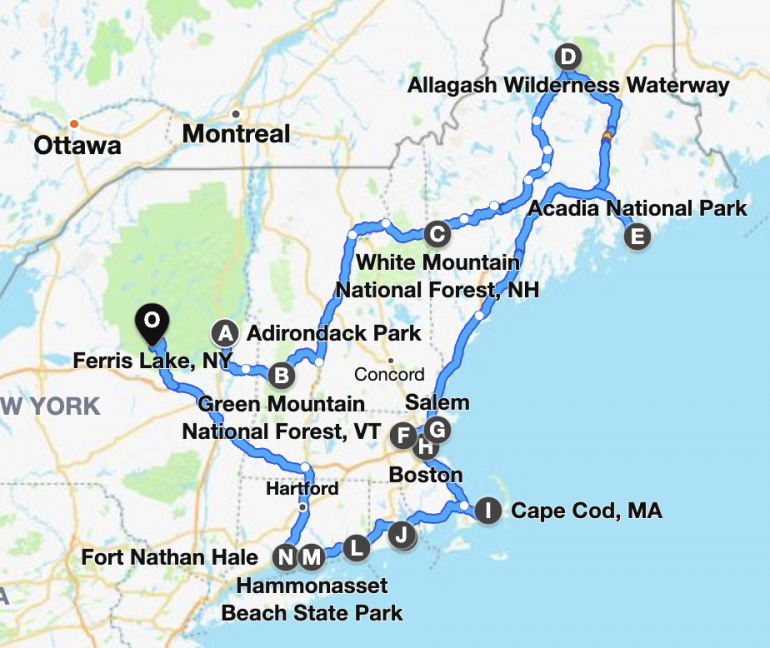
A. Adirondack State Park, N.Y.
B. Green Mountain National Forest, Vt.
C. White Mountain National Forest, N.H.
D. Allagash Wilderness Waterway State Park, Maine
E. Acadia National Park, Maine
F. Minute Man National Historic Park, Mass.
G. Salem, Mass.
H. Boston, Mass.
I. Cape Cod, Mass.
J. Jamestown, R.I.
K. Fort Adams State Park, R.I.
L. Mystic Seaport, Conn.
M. Hammonasset State Park, Conn.
N. Fort Hale Park, Conn.
O. Ferris Lake, N.Y.
Distance: 5,776 miles
The Southern states have plenty to offer in terms of nature, culture and relaxation. A satisfying southern RV expedition will sample forests, beaches and everything in between. This loop starts in historic Savannah, drops down into Florida and meanders along the Southern coast before launching back east into Tennessee and Virginia. The last leg of the journey comprises a series of beaches for a proper cool down at the end of a long journey. Of course, you can begin anywhere along the route and eventually end up back where you started.
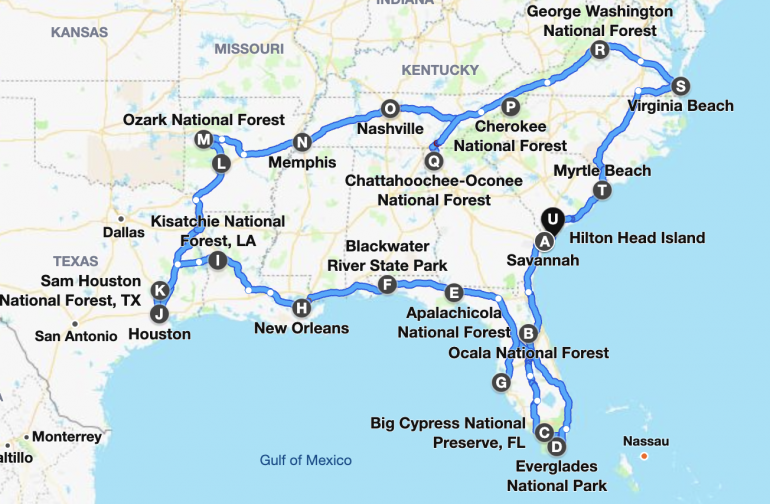
A. Savannah, Ga.
B. Ocala National Forest, Fla.
C. Big Cypress National Preserve, Fla.
D. Everglades National Park, Fla.
E. Apalachicola National Forest, Fla.
F. Blackwater River State Park, Fla.
G. De Soto National Forest, Fla.
H. New Orleans, La.
I. Kisatchie National Forest, La.
J. Houston, Texas
K. Sam Houston National Forest, Texas
L. Ouachita National Forest, Ark.
M. Ozark National Forest, Ark.
N. Memphis, Tenn.
O. Nashville, Tenn.
P. Cherokee National Forest, Tenn.
Q. Chattahoochee National Forest, Ga.
R. George Washington National Forest, Va.
S. Virginia Beach, Va.
T. Myrtle Beach, S.C.
U. Hilton Head, S.C.
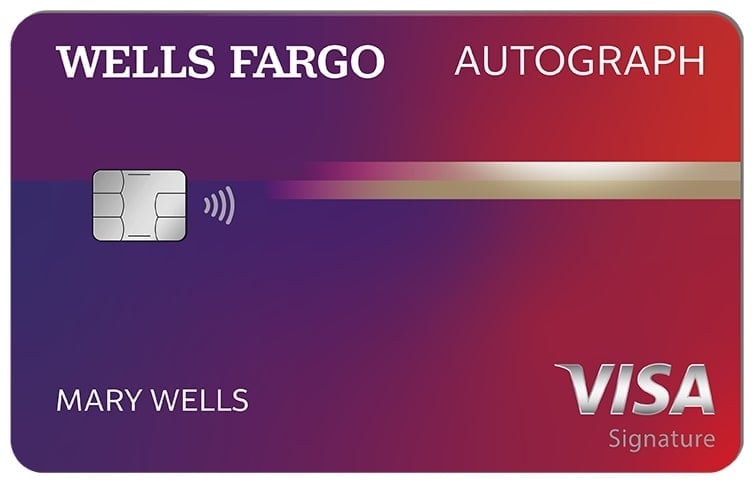
on Wells Fargo's website
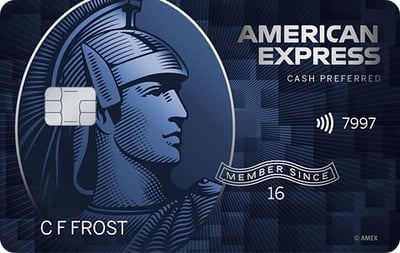
on American Express' website

on Citibank's application
Unlimited 3 points per dollar spent at gas stations.
3% Cash Back at U.S. gas stations. Terms apply.
4% cash back on gas and EV charging purchases (both at Costco and other gas stations) on up to $7,000 of spending a year, then 1% back.
How to maximize your rewards
You want a travel credit card that prioritizes what’s important to you. Here are our picks for the best travel credit cards of 2024 , including those best for:
Flexibility, point transfers and a large bonus: Chase Sapphire Preferred® Card
No annual fee: Bank of America® Travel Rewards credit card
Flat-rate travel rewards: Capital One Venture Rewards Credit Card
Bonus travel rewards and high-end perks: Chase Sapphire Reserve®
Luxury perks: The Platinum Card® from American Express
Business travelers: Ink Business Preferred® Credit Card

on Chase's website
1x-5x 5x on travel purchased through Chase Travel℠, 3x on dining, select streaming services and online groceries, 2x on all other travel purchases, 1x on all other purchases.
75,000 Earn 75,000 bonus points after you spend $4,000 on purchases in the first 3 months from account opening. That's over $900 when you redeem through Chase Travel℠.

1.5%-5% Enjoy 5% cash back on travel purchased through Chase Travel, 3% cash back on drugstore purchases and dining at restaurants, including takeout and eligible delivery service, and unlimited 1.5% cash back on all other purchases.
Up to $300 Earn an additional 1.5% cash back on everything you buy (on up to $20,000 spent in the first year) - worth up to $300 cash back!

on Capital One's website
2x-5x Earn unlimited 2X miles on every purchase, every day. Earn 5X miles on hotels and rental cars booked through Capital One Travel, where you'll get Capital One's best prices on thousands of trip options.
75,000 Enjoy a one-time bonus of 75,000 miles once you spend $4,000 on purchases within 3 months from account opening, equal to $750 in travel.


How to Travel the USA by RV – Expert Tips & Itineraries
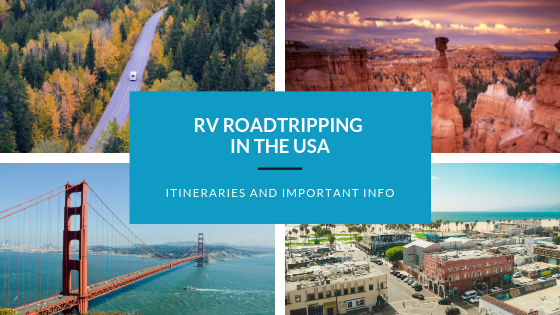
The USA covers a huge area that is often underestimated. Perhaps because of the vast distance, the country lacks the train and bus infrastructure that is found in many other parts of the world, so the intrepid traveller is usually left with the option of renting a car to get around. Why not go a step beyond and rent portable accommodation as well? By taking an RV across America, you have flexibility, everything you need in a self-contained vehicle, and you will have experiences that wouldn’t be possible by just renting a car. Imagine enjoying the national parks once the daytime tourists have gone home.
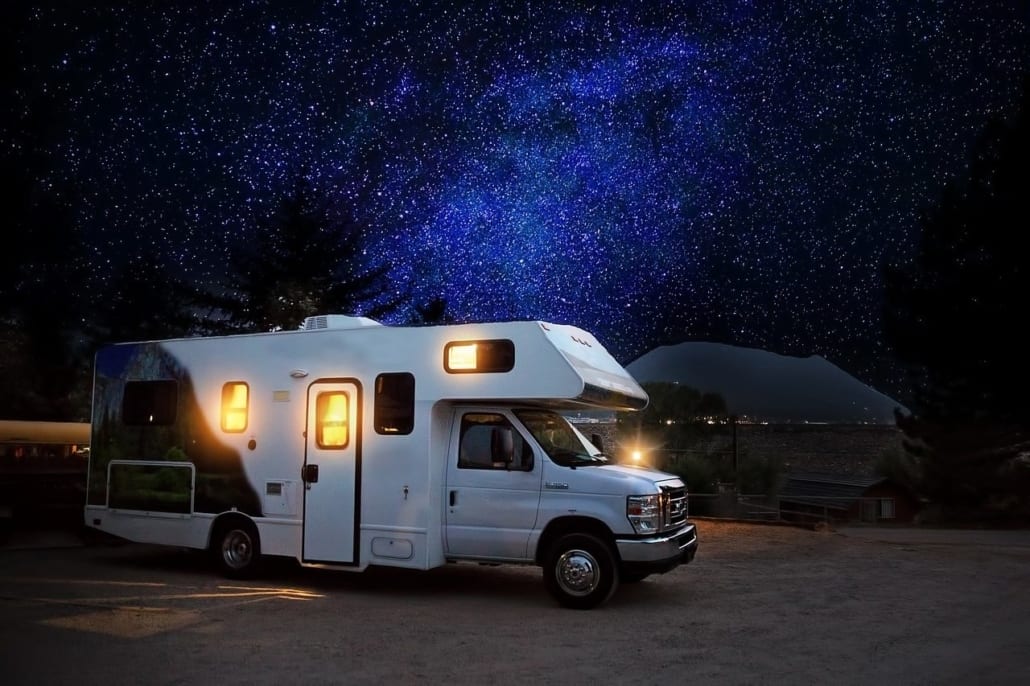
Enjoy the US National Parks after the crowds go home
What’s more, the benefits of travelling with an RV across America are not only great for camping and visiting National Parks. Road tripping and city hopping with an RV in the USA is sometimes the most practical way of exploring certain regions.
This article walks you through everything you need to know about RV travel in the USA, as well as some of the greatest road trips in the country.
Driver’s License Requirements for Renting an RV
You do not need a special class of license to rent an RV to travel across America. However, you must be at least 25 years old and your license must be valid for 12 months beyond the date that your rental contract starts.
Renting a Camper for your RV Trip
To rent an RV in the USA, you have a few choices. Cruise America is the most well-known company– if you’ve travelled in the USA you’ve surely seen these vehicles on the road. You can’t miss their branding. There is also a site called RVshare which functions as a sort of Airbnb for RVs. RV owners list their own vehicles for rent, which means you’ll have a large variety, often with cheaper options than renting directly from a large company.
How to Make Reservations for Campsites in the USA
Especially during the summer high season, it’s best to plan your overnight stops as far ahead as possible. In popular national parks, campsites are sometimes reserved a year in advance. If you dream of sleeping overnight in Joshua Tree or Yosemite, plan as far ahead as possible. Nowadays, you can easily book campsites using booking.com . You can filter by amenities, check out reviews from other campers, and reserve most places with free-cancellation policies. Or, you can visit the homepage of the National Park where you’d like to stay.
In the off-season and in the lesser-known national parks you should generally be ok with just showing up.
For city trips, it’s not impossible with an RV but once you get closer to the compact downtown you may have problems finding parking. It’s best to park in the outskirts of the city and then rely on public transportation. You can usually find RV-friendly parking lots like shopping malls or a subway station.
How to Plan your Budget for an RV Across America
Costs during your RV road trip adventure will come down to the RV rental costs, campsite fees, fuel, National Park fees, and food/drink. However, there are some tricks of the trade to keep your expenses low.
- Use your RV kitchen! Even when on the road, try to limit your restaurant pit stops.
- If you plan to visit at least 3 national parks (entrance fees cost about $30 per car), it’s worth investing in a national park pass . With it, you get a year of access to national parks for $80.
- Learn to love ‘dry camping’ aka parking for free wherever it’s legal. You won’t have hookups for water or electricity, but your water tank and generator should be enough for a night. Park on a friend’s property, on National Forest land, or in any Walmart parking lot– they allow parking overnight for free, as long as you ask the store manager’s permission.
4 Itineraries for RVing Across America
Usa rv itinerary #1: california highlights (plus las vegas).
With this RV itinerary, you’ll hit the best national parks and major cities in California, plus take a small detour to Las Vegas. The camping sites along this RV itinerary range from forest sites to beach-side camping. This is a circular route, so you could start from any point.
USA RV Itinerary #2: Iconic American Southwest
The American Southwest is full of National Parks where red sandstone has been carved by wind, water, and tectonic activity. These are some of the most awe-inspiring landscapes in the entire world. Even with all the major highlights, this RV route is surprisingly compact — most people choose to combine it with RV Itinerary #1 so that they can do California plus these desert landscapes in one trip.
Highlights : Grand Canyon, Antelope Canyon, The Wave, Monument Valley, Bryce Canyon, Zion National Park
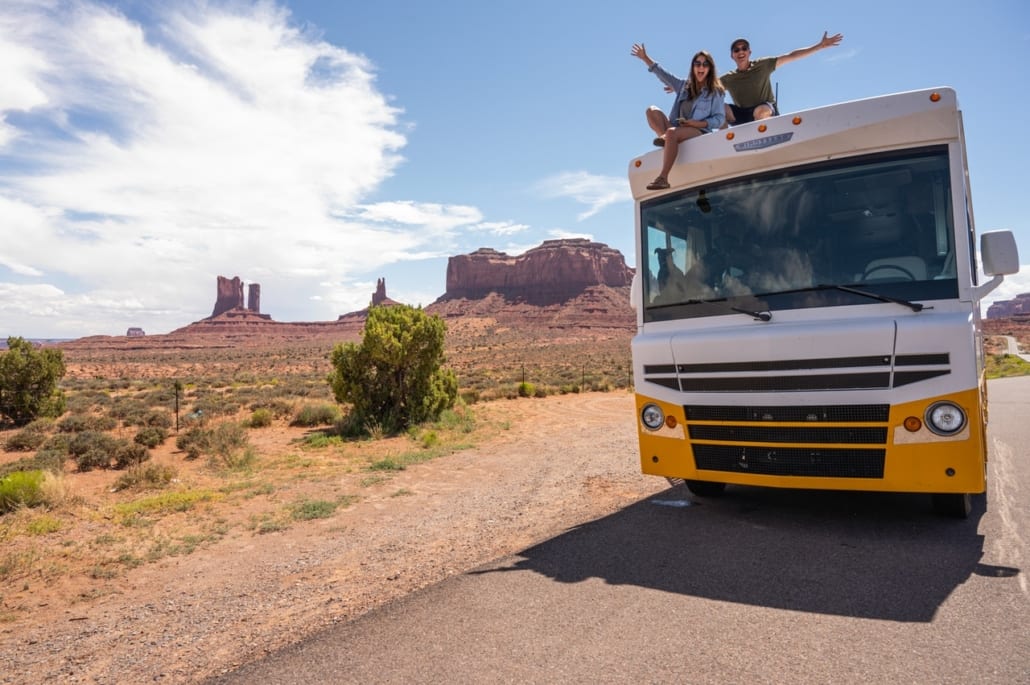
RV camping near Monument Valley, Arizona
USA RV Itinerary #3 New England (plus some Canada)
The states are smaller in the Northeast, which means you can visit some world-famous cities and National Parks all in one trip. Plus, it’s not too far to drive to the French-Canadian cities of Montreal and Quebec City.
During half of this itinerary, you’ll be surrounded by pristine nature, but you can also visit major metropolitan areas like Boston, Manhattan, and Washington D.C.
Rather than navigate the busy cities in your RV, it’s best to park at a Subway station in the outskirts, and take public transportation into the center.
USA RV Itinerary #4: The South
Camping in the South is a different type of trip. The focus of this RV itinerary is not national parks, but we think this region is best seen with a road trip. This region of the USA has a uniqueness that some of the larger cities in the rest of the USA have lost long ago. It feels like a completely different country from what you would experience on the West Coast or in New England.
So there you have it, the essential information you need to plan your RV across America camping experience, as well as some great itineraries to explore. Last but not least, here are some websites you can use to plan your trip and make reservations online as you go:
- National Park Service – a list of all US national parks
- State Parks USA – a list of all state parks
- Booking.com – a large database of campsites in the USA
- Go RVing – Meta-search for campgrounds
- Reserve America – leading online reservation system for campgrounds
- Woodall’s – lists campgrounds by state
- KOA – nationwide chain of campgrounds in the USA
Liked this post? Share it with others who might be after the same information!
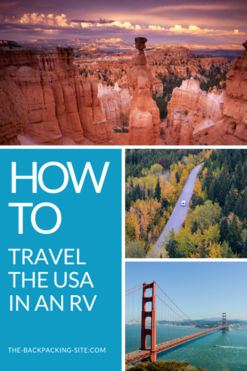
About the author

Monica Woerner
Monica is an avid traveler and backpacker who seeks to inspire others to embark on great adventures off the beaten path. Originally from California, she has travelled to over 60 countries, most of which she explored while backpacking or camping.
- Monica Woerner #molongui-disabled-link 3 Days in Berlin - an Insider's Guide to See It All
- Monica Woerner #molongui-disabled-link Backpacking in India - Our 2 Week Route
- Monica Woerner #molongui-disabled-link My Field-Tested Packing List for a Safari in Tanzania
- Monica Woerner #molongui-disabled-link How to Travel in Argentina on a Budget
You might also like

After nearly 60,000 miles of traveling across the USA and Canada by RV, we have learned a few tricks along the way – not only about saving money but also how to do things just a little differently.
UK citizens – My 30 yr old son and I are planning a 3-week father/son getaway and hoping a USA “west coast” trip will be the he perfect experience. We are looking at flying into Vancouver and meandering our way to California picking up a variety of experiences. The bus and train option would bring a better “life and people experience ” with an added RV element that could have some major pluses. I as thinking 1-way but i could drive / fly back alone if time was to difficult and cost more beneficial. All advice welcome.
Great info. Lucky me I ran across your site by accident (stumbleupon). I have book marked it for later!
This must be such an amazing experience to travel by RV across the states! I really want to do a road trip in the states, so I may look into getting an RV to do it in now!
Great collection of itineraries! I’d love to embark on that American southwest adventure, so thanks for the inspiration!
Leave a Reply
Leave a reply cancel reply.
Your email address will not be published. Required fields are marked *

Van Life Guide for Beginners: Traveling Around the United States in a Campervan
Written By Bastian Graf
The best way to see North America is on a road trip. Whether you’re planning a road trip and plan to rent a campervan or RV or you’re considering becoming a full-time van lifer, we have you covered. We’ve put together a full guide covering do’s and don’ts, great tips, and expert recommendations for traveling around the United States by road.

Download the full guide here
The best way to see North America is on a road trip. Whether you’re planning a road trip and plan to rent a campervan or RV or you’re considering becoming a full-time van lifer, we...
Here’s what you can find in this Guide:
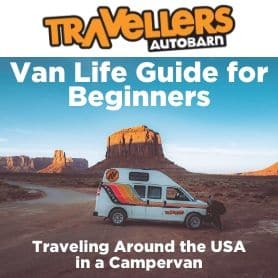
1. Best Campervan Rentals
- Campervans or Conversion Vans
2. Tips for Campervan Travel
Plan Out Your Route
Be prepared on the road, must-have travel apps.
- Campervan/Minivan Maintenance
Campervanning = Minimalism so Pack Smart
3. Budget Travel Tips to Save Money on Your Campervan Trip
4. Campervan Travel Guide – Road Trips To Consider
5. Best Campsites or RV Parks to Visit in the US
6. Van Life Tips – Best Places to…?
Take Selfies
Go Stargazing
- Watch the Sunsets
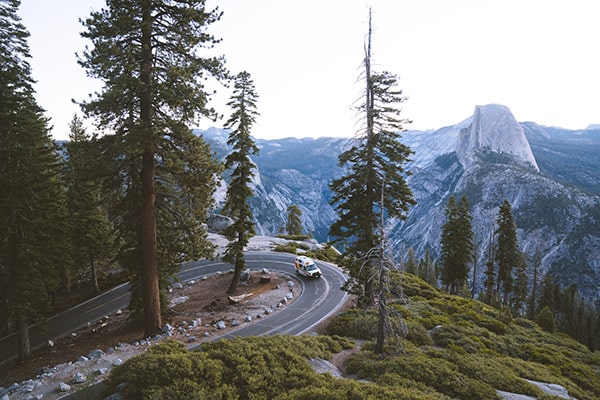
Best Campervan Rentals
Fridge vs. no fridge – lots of space vs. not so much space – proper campervan vs. minivan … decisions decisions decisions.
Renting a car or campervan for the first time can be pretty daunting, and with so many options out there, it can be hard to decide on what’s the best van is for you. Read on for top tips and expert advice on how to find the right vehicle for you.
Here are a few questions you should ask yourself.
- What am I most comfortable driving?
- How many people are in my group?
- What is my overall budget for this road trip?
- Do I prefer to sleep in a vehicle or a tent?
Answering those simple questions will help you to decide between renting a campervan or minivan.
Minivan Rentals
These dependable vehicles are cheap, reliable, and, most importantly, easy to pick up all over the country. We recommend minivans for:
- Travelers who are happy to fold down the seats and throw a mattress in the back of the van. Packing a tent is also an option.
- Travelers on a budget – minivans are cheaper vehicles to run than campervans or RVs .
- Groups of people who are traveling together (this is a great way to save on the cost of fuel)
- People who are planning to mix it up between camping and staying in hotels .
Campervan Rentals
The perfect vehicle for groups of two who are planning on living on the road, experiencing the van life, for the length of their road trip.
We recommend campervans for:
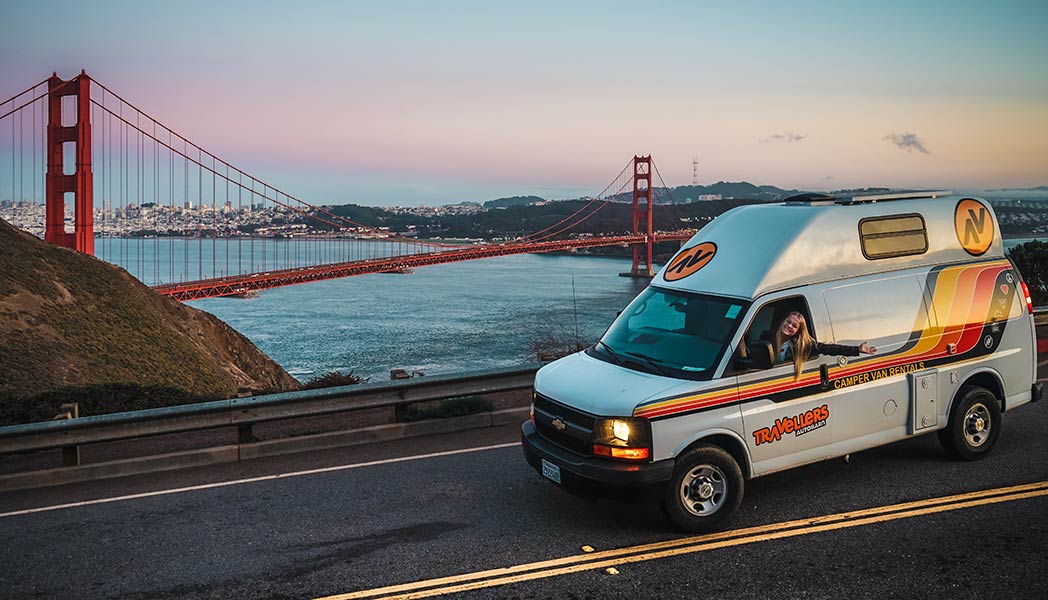
- People who have a bigger budget to spend on a vehicle
- Travelers who prefer their home comforts such as the fridge, kitchen sink, and gas stove.
- Travelers who are planning on sleeping in their vehicle every night, and are looking for a little more room.
- Travelers who are considering van living as a lifestyle
*Bonus – Some campervans have solar panels! Having solar panels means you have less of a need to stay at a powered campsite to recharge the batteries for your fridge & lights!
Still not sure what vehicle to rent? Check out our articles 6 Reasons to Rent a Minivan for your Next Road Trip and 6 Reasons Renting a Campervan is the Best Way to Travel the USA .
Tips for Campervan Travel
Traveling around in a campervan is a brand new experience to many people, so we thought we’d put together some tips to ensure that your trip around the USA with Travelers Autobarn is the ultimate, stress-free road trip!
The United States is vast, and you won’t be the first road tripper to look at Google Maps and underestimate how long it will take you to drive from one place to another. But, while you still want to keep some degree of spontaneity in your trip, it’s ideal to have a rough idea of where you want to travel to, the route you want to take, and how long it will take you to get there. If you are going through larger cities, try to avoid rush hour traffic, or you may get delayed for hours.
Have a rough plan of where you want to go, your must-see sites, and where you plan to stay each night will help you stay on budget, be more relaxed, and have a more enjoyable trip. Bring a map of the United States too! You never know when you may hit a stretch of highway without services, so be prepared!
*Bonus – when you rent a campervan RV or minivan from Travellers Autobarn USA, all of our vehicles come with FREE UNLIMITED MILES ! So even if you detour from your original plan, we have you covered!
Food & Water
The hotter it is, the more water you need. You don’t want to get stuck in Death Valley National Park without water!

It’s also crucial that you pack some non-perishable food to keep you going should you break down – think cereal bars, nuts, and dried fruit. Try to avoid snacking on salty snacks – it’s just going to make you even thirstier and could speed up dehydration.
Weather – Know the forecast!
Knowing the weather forecast is extremely important! Depending on the time of year and what parts of the country you plan to campervan through, Mother Nature may have a different plan for your road trip. Winter months can bring on harsh temperatures, slippery roads, high winds, and road closures. Knowing ahead of time can save you from having to turn around or from being stuck in a stressful situation.
In some parts of the United States, you will need to be aware of hurricane season and pay attention to tornado warnings. The Weather Channel app is a great way to check the forecasts before you set off on the open road each day.
Our flexible drop-offs and unlimited miles are extra helpful in these situations. Don’t be in a rush!
*Bonus – For more tips on winter travel, check out our Van Life Guide to Winter Road Trips in a Campervan .
Avoid unsealed roads
Although many of the highways and roads in the United States are in good condition, you may end up on a gravel or dirt road.
If you have rented a campervan or car from one of the big cities like Los Angeles, Las Vegas, or San Francisco (to name a few), then you might find that the insurance policy you took out does not cover you when you are driving on unsealed or unpaved roads. Make sure you read the small print.
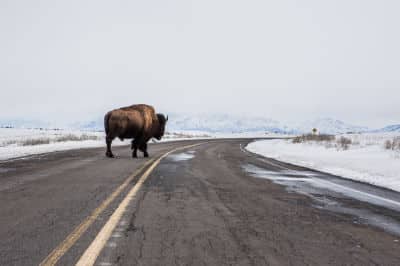
When you’re driving, be aware that collisions with these animals are frequent, as well as cows and other animals, particularly at nighttime, dawn, or dusk. If you are pulling a night shift at the wheel, then try to ensure that the passenger next to you stays awake and alert to help you watch out for any animals on the road.
And please don’t try and take a selfie with or pet the wild animals! Not only is it against the law in certain parts of the country, but it is dangerous and could result in serious injuries or even death.
Boondocking – Dry Camping – Wild Camping
Solar panels come in very handy when you need to dry camp. If you are running out of steam and need to pull over in the middle of the night, or you can’t find a campground for the night, make sure you are in an area that allows the campervan to be parked. If you are in or near a larger city, it should be reasonably easy to find a Walmart, gas station, or truck stop that will allow you to use the parking lot for the night. Make sure it is 24-hours in the event you need to use the bathroom facilities. If you are in the middle of nowhere, make sure you don’t park on private property or where there is a “no trespassing” sign.
GasBuddy – An excellent app for travelers on a budget! Gasbuddy helps locate the cheapest gas near you so you can compare prices and save. They have a rewards program that allows you to earn points towards free gas, as well.
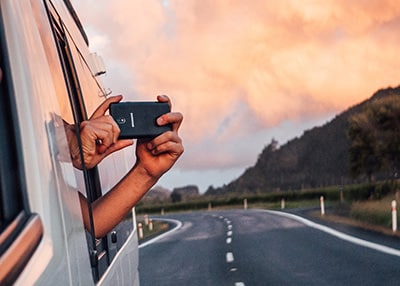
Google Maps or Waze – Real-time GPS apps with live traffic alerts. Both apps are popular, so it comes down to preference.
The Weather Channel – The Weather Channel app has a free version and is great for current and extended forecasts across the United States. If you are heading to a new location, make sure and double-check the weather forecast. You may need to change your route, stop and restock your water supply, or give yourself additional time due to slippery roads.
First Aid: American Red Cross – The First Aid app is a must! We hope you never need it, but in the event, you have a first aid emergency or need to prepare for a weather emergency, the content is preloaded, so you have access to safety tips, step by step instructions, videos, and access to 911 no matter your location. And it’s free!
HipCamp – Hipcamp is an awesome app for finding and booking campsites, RV parks, and more.
Campervan or Minivan Maintenance
Remember that you are responsible for the campervan while it is in your possession. You should treat it like it is your vehicle and carry out basic maintenance checks every 300-500 miles. Basic maintenance includes checking things like tire pressure, and oil, washer fluid, and coolant levels.
If you’re driving a campervan, then make sure you know the height of the vehicle and be wary of driving into parking garages, under bridges, or low hanging branches if you aren’t sure.
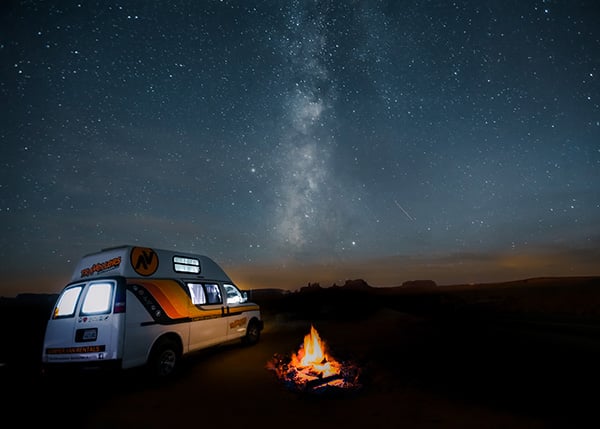
Forest fires and brushfires are unfortunately very common in parts of the United States. They can be dangerous – so always make sure you adhere to the guidelines.
We recommend that you visit the check the fire danger rating in the area and make sure campfires are permitted where you are staying (particularly in summer).
If you start a campfire, then you must always make sure it is entirely out at the end of the night and have at least 10 liters of water nearby in case it gets out of hand.
Just because you are camping doesn’t mean you have to stick to cups of noodles, hot dogs, or cans of beans. Get creative and meal prep before you head out on the open road. Here are a few prep tips for cooking in a campervan.
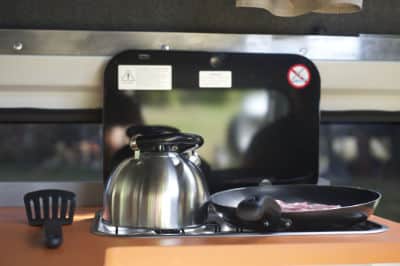
- Cut up your chicken, beef, or pork and toss them in the seasoning or sauces before you pack up. Not only does this help with cleanup in the campervan, but it also saves space. If you season the meat ahead of time, then you don’t have to pack spices or bottles of sauce, and the meat will be full of flavor! You can even go one step further and cook the meat ahead of time.
- Wash, cut, and put your fruits and veggies in a gallon bag. Again, this saves time and space on the road and makes it easier for snacks if you are traveling with kids.
- Pack Reynolds Wrap and grilling bags. These are great for preparing meals over the campfire. Toss in your preseasoned steak strips, potatoes, veggies and add a little water, seal or wrap it up tight and throw it on the fire. Quick cleanup, easy to throw together and delicious! Foil is also great for cooking breakfast burritos, shrimp boils, teriyaki chicken with peppers and pineapple, fish, and Banana S’Mores, to name a few.
- Precook a few pounds of ground beef! Ground beef is very versatile. You can throw together some tacos, taco salads or nachos, add to some pasta sauce for a quick spaghetti, or use it for breakfast burritos or hobo packets in the morning. If you aren’t a red meat eater, then chop up some sausage or ground turkey, or mushrooms if you are vegetarian/vegan.
It’s no secret that traveling in a campervan comes with less storage and smaller space than a motorhome. Dollar stores are a great place to find travel-size toiletries for your road trip, and it’s easier on the budget.
Another great packing tip is to save condiments from fast-food restaurants. If you know you are going on a campervan road trip, plan to keep any extra condiments from eating out. Ketchup, mustard, mayonnaise, salt, and pepper packets take up a lot less space than full-size bottles and don’t require refrigeration. This not only saves space for additional packing items but doesn’t take up space in the campervan fridge.
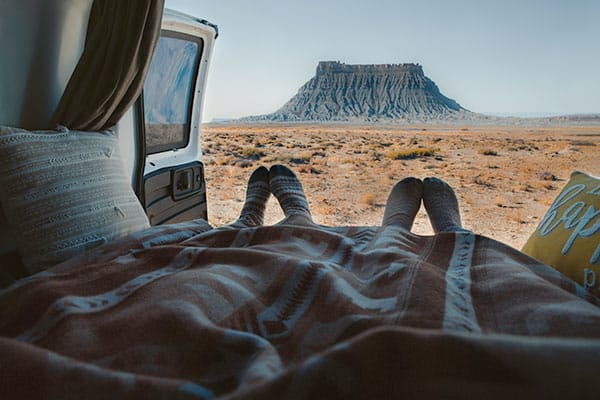
Budget Travel Tips to Save Money on your Campervan Trip
One of your biggest outgoings is going to be the cost of your fuel. As we mentioned earlier, one of the best apps we recommend is GasBuddy. It’s convenient for finding the cheapest gas prices in your area. Having an app like GasBuddy or Waze can assist you in not only finding a gas station nearby but also which station has the lowest fuel prices.
*Pro-tip: Having the A/C on all the time will eat into your fuel tank – so if you’re trying to save some money settle for opening the windows instead.
Hit a supermarket with a grocery list in hand!

Once you have rented your campervan, you will likely be departing from one major city, so we recommend that before you hit the road, you stop by a supermarket to stock up on all the essentials (and we don’t just mean beers and sausages for the barbie!). Have a list! We all know that we spend more money in the grocery store without a list frequently buying food or supplies we don’t need and forgetting items we do.
Buying food and supplies from gas stations and small local stores on the journey can hit your traveling budget hard.
National Parks Pass
If you plan on visiting more than 3 National Parks, then we highly recommend you invest in an annual America the Beautiful pass ! The cost is $80 and gives access to over 2,000 National Parks and National Refuges. Typically each park has around a $35 entrance fee, so an America the Beautiful pass is an excellent deal for travelers planning National Park Road Trips . If you are 62 and older, they have an annual Senior Pass that is significantly cheaper. If you are a current, or veteran, member of the US military or if you are a US citizen or permanent resident with permanent disabilities then you are eligible for a free pass.*
*Please confirm prices and terms have not changed for these passes at NPS.gov .
Campervan Travel Guide – Road Trips to Consider
Ultimate National Parks Campervan Road Trip – One of our top recommendations that you can enjoy in both summer and winter !
West Coast Campervan Road Trips – Los Angeles to Big Sur , LA to San Fran , or Los Angeles to Seattle
The Narrows Hike – Ultimate Zion Campervan Getaway – Zion National Park features some of the most incredible hikes in the United States.
Ultimate Rock Climbing Campervan Road Trip – Not for the novice! But if you love rock climbing, then this itinerary is a must!
San Francisco to Denver and back – You won’t regret this roundtrip campervan adventure! Our itinerary takes you through some of the most famous places in the western United States.
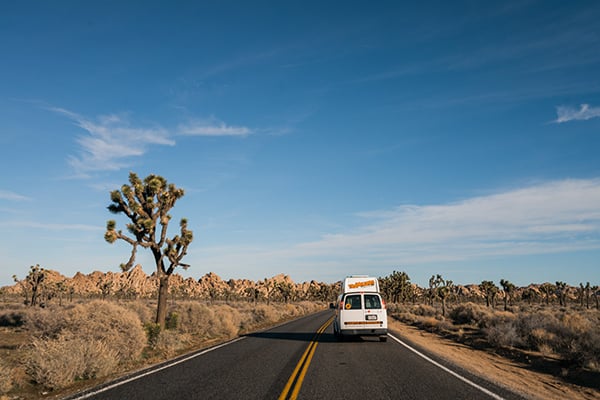
Best Campsites or RV Parks to Visit in the USA
The United States has so many amazing places to visit . Traveling around in a campervan lets you see the most popular destinations, plus all of the beauty in between. You’ve decided which campervan is best for your road trip, you know all of the tips and best travel apps, we’ve given you a few road trip itineraries to consider, so now all that is left is where to stay.
The US is full of campgrounds and RV parks with a variety of amenities. However, if you are on a tight budget, you may want to look for free campgrounds along the way. Just be prepared, many of the free campsites come with no facilities or amenities so you will need to plan accordingly. Some of these sites are within the Bureau of Land Management (BLM), in parking lots of larger retailers like Costo, Walmart, and Cabelas, and truck stops and rest areas. Make sure and do your research so that you don’t get ticketed.
Here are 5 of our favorite RV Parks to visit:
- North Pines Campground, Yosemite National Park, California
- Glacier Campground, Glacier National Park, Montana
- Zion River Resort, Zion National Park, Utah
- Mesquite Spring, Death Valley National Park, California
- Paradise on the River, outside Estes Park and Rocky Mountain National Park, Colorado
Bonus: If you are planning a road trip out of Las Vegas or California, check out our Best Campervan Campgrounds Near Las Vegas and Best Places to Campervan in California.
Van Life Tips – Best Places to…?
Whether it is the Grand Canyon in Arizona, inside of a gigantic tree in Redwood National and State Parks, overlooking the Pacific ocean with the Golden Gate Bridge in the distance, or hiking the Narrows in Zion National Park, we know travel selfies are a must! Here are our top 5 selfie spots.
- Antelope Canyon in Arizona – We already mentioned places like the Grand Canyon & Zion above, but add Antelope Canyon to your list. It is particularly incredible and something everyone should experience.
- Glacier National Park, Montana – Lake McDonald, Grinnel Glacier, Going to the Sun Road – GNP should be on everyone’s bucket list!
- Redwood National & State Parks, California – The enormous redwood trees are not only a site to see but are fantastic backdrops for the avid selfie-taker.
- San Francisco , California – Hawk Hill is a great spot to take a selfie with the Golden Gate Bridge and the city in the distance.
- Las Vegas, Nevada – There are too many spots to list, but the fountain at the Bellagio Hotel is a great place to start.
Pro tip: Any US National Park is a spectacular place for selfies.
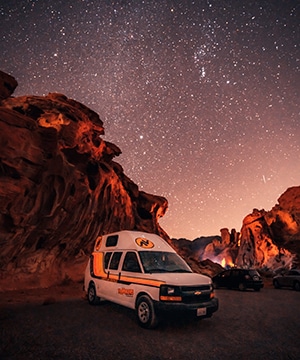
Travel outside of the bigger cities, put your phone down, and stargaze into the incredible nighttime sky.
- Arches National Park – Utah Bryce Canyon – Utah
- Death Valley National Park – California (make sure to go during the milder seasons)
- Joshua Tree National Park – California
- Rocky Mountain National Park – Colorado
- Sedona – Arizona (don’t plan to stargaze during the late summer months. Early July to late August is monsoon season.)
Watch the Sunset
Who doesn’t love a good sunset? Below are some of our favorite spots to take in some of the most magnificent sunsets in North America.
- Grand Canyon National Park in Arizona – The south rim, in particular, provides not only an exceptional sunset experience but a view of most of the canyon itself.
- California – Pick a place! Los Angeles, Santa Barbara, Big Sur, Joshua Tree National Park. California is full of beautiful sunsets locations.
- Montana/Wyoming – Glacier National Park , The Grand Tetons or Yellowstone National Park. The clean mountain air and the sun setting behind the mountains – you can’t go wrong.
- Santa Fe, New Mexico – Old Fort Marcy Park is an incredible experience for those willing to hike.
- Arches National Park, Utah – When the sun sets, it changes the colors in the sandstone arches making a spectacular visual experience and a prime opportunity for incredible photos.
You are all set for traveling around the USA in a campervan, now book your campervan at one of our three US RV rental locations !
Here are a few other guides you might enjoy.
Guide to the Best Campgrounds for Campervans in the USA
Guide to Free Camping in the USA
Visit all our Guides here
Considering traveling overseas? Check out our other Beginner’s Guides for New Zealand and Australia Campervan Trips.
About the Author
Bastian Graf
Bastian is the Sales & Marketing Manager here at Travellers Autobarn. He holds a Master of Commerce in Marketing and International Business Management, and 20+ years experience in campervan hire, road trips and travel.
Sign up for deals and road trip itineraries.
Our travel guides, guide to the best campgrounds usa, beginner's guide to travelling around usa, find your nearest travellers autobarn location, road trips & travel tips, our campervans.

Tent Optional
Chairs Optional
Ice Box Optional
Ext. Table Opt.
Gas Cooker Opt.

Kuga Campervan
Seats 2-3 • sleeps 2-3.
Solar panel

Hi5 Campervan
Seats 4-5 • sleeps 4-5.

Hi-Top Campervan
Sign up for special deals and awesome road trip itineraries, data collection policy.
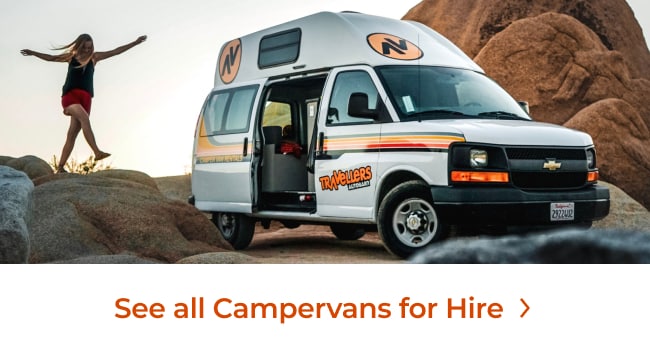
Destination:
Pros and Cons of RV Travel
Motorhome vs. Towing a Trailer
Where to Park an RV
Choosing the Right RV
RV Park Review Sites
Reserving a Parking Spot
Music Festivals
Disney World
National Parks
Best for Families
Dog-Friendly RV Parks
RVing With Alcohol
Driving on Icy Roads
Accident and Emergency Guide
Best Weather Apps
How to Find Cheap Rentals
RV vs. Motel: Where to Stay
Guide to RV Warranties
Budget-Friendly Parking
Best RVs to Buy
Maximizing Gas Mileage
Buying an RV
Towing a Car
Turning an RV
Cleaning an RV
Sleeping Tips
Propane Guide
Planning an RV Trip: The Complete Guide
Contributing $114 billion to the U.S. economy in 2019, RVing is one of the fastest-growing trends inspiring solo travelers, families, and couples to hit the road. RV travel allows you to visit areas you might not travel to otherwise. You can drive on your own time and stay at some of the most majestic places on earth.
Whether you’ve planned an RV trip before or it’s your first time, you’ll learn something from our complete planning guide.
Planning Your Trip
The great thing about planning an RV trip is the endless possibilities of destinations and the flexibility of the trip; you can rent an RV just about anywhere, meaning you can fly to a closer point, or you can leave right from your own home.
When choosing routes and destinations for a first-time trip, do your research and plan to stick to the proven routes; don’t venture off the path too much, especially if you’re not used to driving a motorhome or towing a trailer . Once you’ve tackled a few easier trips, you’ll be more comfortable going off the beaten path.
National and state parks will be expensive, and the most crowded during the summer months. Try to visit these popular spots on shoulder seasons for a more enjoyable experience. Book ahead to save the most money and make sure you can secure your entry when you plan to go.
Transportation
One of the first decisions to make: will you rent or buy an RV? Depending on how often you want to RV, buying one to call your own will be the more cost-efficient option. If you’re renting, you’ll want to rent early, off-season, and get the right size for your companions to get the best deal.
Renting an RV
Renting an RV can be done at rental agencies or dealers. If this is your first time hitting the road, we recommend renting from an agency, such as Cruise America , which will help you choose the right motorhome. Since it’s your first time, chances are you won’t have a towing vehicle or want to tow a trailer; you’re not used to towing, so going with a motorhome will be more comfortable and safer for you on the road.
Here are a few things to keep in mind about renting an RV:
- Prices will fluctuate based on availability and seasonality.
- Motorhomes will go between $175 to $275 per night on average for an older model (10 years and older), depending on the Class you rent. Newer RVs run between $150 to $450 per night on average .
- Trailers are often the cheapest option going between $50 to $125 per night on average.
- Fifth wheels go between $60 to $150 per night on average.
- For trailers and fifth wheels, you’ll need to have a vehicle capable of towing safely, or you’ll need to rent a vehicle to tow.
- RV websites like Outdoorsy , RVshare , and others allow you to rent RVs directly from owners. This could be a cheaper alternative depending on your plans.
Want to know more about renting a vehicle when planning your trip? Read our guide to renting an RV and make sure you’re getting the best possible deal for your trip.
Buying an RV is an investment, no matter the type you decide to get . If you’ve been planning an RV trip and know it’s going to be something you do in the future, purchasing an RV will save you money long-term.
If you’re ready to buy, there are lots of things to consider; read our guide to buying an RV to get started on your next adventure.
Where to Stay
There are three primary places to stay when RVing: RV parks, campgrounds, and boondocking locations. RV parks and campgrounds, including resorts, are the easiest places to book ahead of time for your motorhome or trailer. Book early to save money and ensure you have a place to park for the duration of your trip. The longer the stay, the more you’ll save, too. RV memberships are another great way to save money on parking, but if you aren’t going to RV much, or this is a one-off trip, the investment isn’t worth it.
Boondocking , the practice of camping without any kinds of hookups or other common amenities, is another option but can be a bit trickier. Essentially, this means that you want a place to park and sleep, but you can't just do that anywhere; you'll need to do some research about places that allow overnight parking. The pros of this practice are that it's free, and you are truly flexible without needing too many amenities or having to make reservations, but it can be a little nerve-wracking the first time you do it, and you want to make sure you're staying safe.
The possibilities of what to do when going on an RV trip are truly endless. If your destination is a large city, a National Park , or a specific attraction, that’s the primary thing you’ll plan your trip around, and from there, it’s about exploring what’s in the surrounding areas.
Many RV parks and campgrounds offer shuttles to help you visit nearby attractions. They’ll also host events and activities, especially on weekends, for you and your family to take part in. If you’re staying at an RV resort, you’ll often find golfing, spas, boating, and other activities included in your stay.
Don't focus all your planning on the destination—RVing truly is about the journey as well, allowing you to discover hidden attractions, restaurants, pit stops, and more that you can stumble upon spontaneously. Take the time to explore, venture off the path, and take in everything around you.
Keep in mind that your trailer, motorhome, or camper is also a place to do things—bring board games, watch movies, cook, and relax.
What to Bring
Like any other trip, bring what makes you comfortable. You’ll need the basics, like clothes and toiletries. If you plan on doing anything specific outdoors, you’ll need the appropriate gear to do so. Depending on the weather, you may want winter coats, rain jackets, waders, or hiking boots. What you bring will be dependent on what you plan to do on the road and at your final destination.
An RV gives you the freedom to bring things you wouldn’t for other kinds of trips, such as food and drinks and pillows, blankets, and sheets. While a hotel room will have most of what you need to spend a few nights, your RV is yours to stock and make comfortable for your needs on and off the road. Because most won’t come fully loaded with what you need, take inventory when you get it to make sure you have things like dishes, glasses, cutlery, pots and pans, toilet paper, and more—if those aren't included, plan to bring the things you'll need.
If your RV comes with a refrigerator, you’ll be able to fill it up with your favorite food to snack on and cook throughout the trip. But don’t over-buy food for the trip. You can always pick up more on the way.
Some emergency items you’ll want in your RV include:
- First aid kit
- Flashlights
If you forget something, you can always stop and pick it up.
Money-Saving Tips
Without proper planning, RVing can add up quickly. Here are some tips to keep your adventure on a budget:
- Rent your RV and book your parking spots well in advance, especially if traveling in summer months. The further out you book—and the longer—the more you’ll save. This goes for what you want to do when you arrive, too.
- If you can travel out of season, do it. You’ll often save up to half off the entirety of your trip by doing this.
- If you need to buy food, drinks, or things you left behind when you arrive at your destination, try and travel farther away from tourist traps to do so. Pit stops, gas stations, and tourist attractions will charge a lot more, especially for the “necessities.”
- Plan strategically for gas stops. Several apps exist to help you save on fuel along the way. Towing a trailer or driving a motorhome can be expensive; if your ride is fueled by diesel, this could break your budget.
- Don’t buy new things for your ride. Use what you have at home, including food and snacks. Also, plan how often you'll eat out during your trip.
Things to Consider
- Be flexible. Something will likely go wrong—you'll get lost or move at a slower pace than you thought. Embrace these unexpected obstacles, and enjoy the “adventure” it adds to your RV trip. You never know what you might discover on the road or about yourself dealing with it.
- RVing is not for everyone. Plan a small trip for a few days if it’s your first time hitting the road. If you’ve never shared a small space with family or friends, you may find out it's not for you. Better to take a few days to learn this than anything longer.
- Have backup plans. You don’t know what the weather may bring . If you’re traveling somewhere where the weather can change at the bat of an eye, make sure to have something to fill the time. Movies, board games, and books are a great way to kill time when the weather keeps you trapped inside.
Planning an RV trip is like planning any other travel adventure. Take the time to understand where you’re going, what you’ll do there, and then plan the rest of the trip around supporting your comfort and enjoyment of what you’ll do when you arrive.
RV Industry Association. " Annual Report 2019. " Page 22. 2019.
RV Share. " RV Rental Prices. "
Everything You Should Know Before Renting Your First RV
Your Guide to Class B+ Motorhomes
9 Tips for Maximizing RV Gas Mileage
3 Types of Places to Park Your RV
10 Cool Ways to Upgrade Your RV
State Regulations Regarding Travel Trailers and Driving Laws
The Best RV Rental Companies
How to Reserve an RV Site
Planning a Road Trip: The Complete Guide
RVing 101 Guide: Turning an RV or Trailer
How to Tow a Car Behind Your RV
10 Safety Tips for Planning an RV Trip
The Only Guide You Need to Buy an RV
Research RV Manufacturers Before You Buy
Everything You Need to Know for Your First Campervan Trip
11 Ways to Sleep Better in an RV

Ultimate RV Trip Planner: A Guide to Planning your RV Road Trip
Post Updated June 2021
This post contains affiliate links, if you click one of them we may receive a small commission at no cost to you. For more information please read our disclaimer on affiliate links .
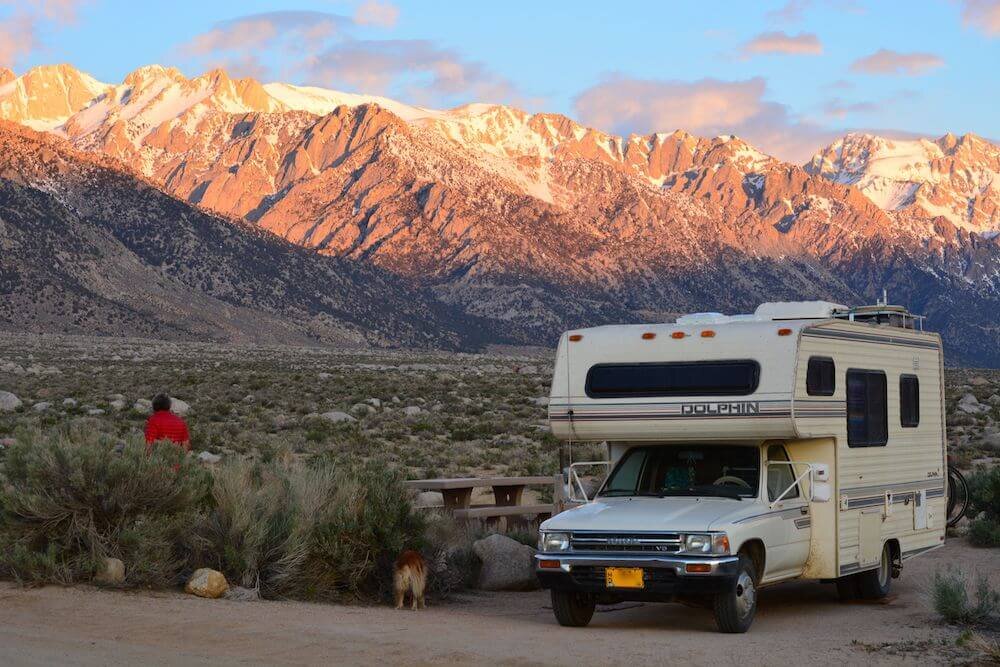
RV travel is one of the best ways to explore the United States! Planning an RV vacation can feel overwhelming, especially if you’re new to the RV life. Not to worry! Two years of full time RV living taught me how to easily plan an RV adventure, and in this ultimate RV trip planner you’ll find a complete guide to planning your RV road trip!
Best Time to RV Across America
The good news is that you can RV the USA any time of the year. If you want to RV across the whole country then a shoulder season like Fall/Spring is best. Alternatively, you can plan your trip based on my seasonal recommendations for the best RV destinations below!
The best time for your RV vacation will depend on the type of scenery you’re interested in seeing. Below I share the best areas of the country for each season.
If you’d like to include Canada in your RV adventure I highly recommend it. Read about the best Canada road trips !

Summer RV Trips
Summer in the Pacific Northwest is absolutely glorious, and not to be missed. If you want to experience gorgeous forest waterfalls, pristine coastal scenery, and crystal clear mountain lakes then summer in Oregon and Washington is your best bet.
Fall RV Trips
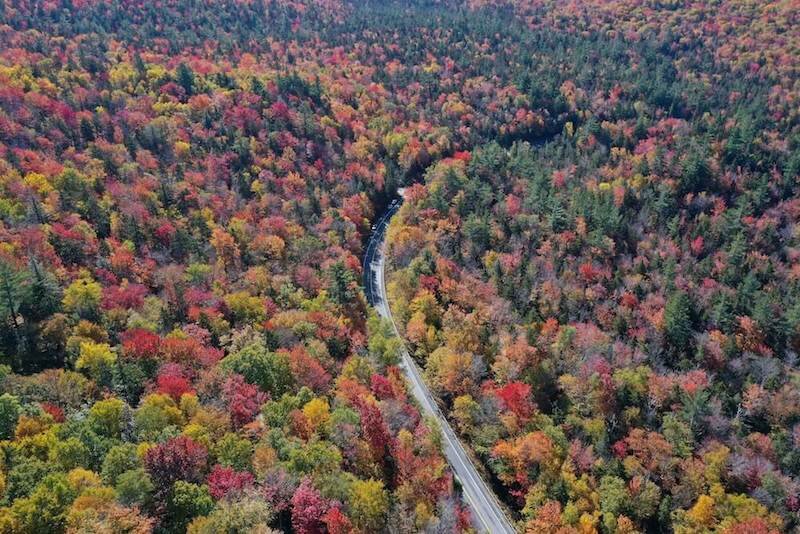
New England is known for it’s striking fall foliage, where the leaves turn brilliant shades of orange, red, and yellow. Fall also brings milder weather to the humid east coast, and it’s a great time to explore the Eastern United States.
Winter RV Trips
Snow and ice make RVing much more difficult so for the winter months I’d recommend heading to the southern USA where temperatures are mild and comfortable.
Southern Florida is a popular winter RV destination, but be prepared to pay high prices for campsites and activities.
If you prefer a more affordable, and, in my opinion, more beautiful option, consider RVing the Southwestern United States. In the Southwest free and cheap campsites are plentiful, the dry air makes outdoor activities easier, and some of the most beautiful desert national parks become more accessible.
Death Valley and Joshua Tree National Parks are two excellent options for a winter RV vacation.

Spring RV Trips
Spring is when the high desert really shines, and this is a perfect time to explore all of the beautiful scenery in Northern Arizona and Utah.
If the Grand Canyon and Utah’s Zion National Park are on your bucket list then a springtime RV trip is the way to go!
Should you Rent an RV or Buy an RV for your RV Trip?
Whether you should rent or buy an RV for your USA RV travel is a very personal question. Here I’ll discuss some of the pros and cons of either choice!
How long is your trip?
If you’re only traveling for a week or two then renting an RV makes the most sense. While renting an RV is the more expensive option, it saves a lot of hassle, and is certainly more simple than purchasing an RV.
RV rentals provide you with the peace of mind that the RV is in good condition, and if you run into any mechanical issues the rental company will have you covered.
If you’re traveling for a month or more then you may want to consider purchasing an RV and re-selling it when you finish traveling. We met many travelers on the road who used this strategy for their RV journeys.
How Much Money can you Invest Upfront in your RV Trip?
The major advantage of purchasing a used RV then re-selling it is the fact that you can save the rental fees so that you will only be paying for travel costs (gas, campsites, etc), since you will recoup the cost of the RV at the end of your trip.
The downside to purchasing an RV rather than renting is that you will likely need more money upfront, and you will need to educate yourself on what to look for in a used RV. However, when you’re considering a savings of $7,000 or more (the amount you can expect to spend on a one month RV rental), it may be worth the extra hassle to buy and sell rather than rent.
Where to Rent an RV?
If you decide that RV rental is the best option for your trip then I recommend checking out the rentals on Outdoorsy.
Outdoorsy is a company that manages the rental of privately owned RVs when the owners are not using them.

Renting with Outdoorsy tends to be quite a bit cheaper than renting with a traditional RV rental company, and since you’re renting privately owned RVs you will have lots of different makes and models to choose from.
For more information check out this complete guide to RV rental in the USA!
Best RVs for Families, Singles, or Couples
Whether you’ve decided to rent an RV or purchase an RV for your RVing adventure, you’ll want to consider the type of RV that best meets your needs. RVs come in many shapes and sizes, and the RV you choose will directly impact the cost of your vacation, as well as the types of campsites you can visit on your travels.
Best RV for Family of 4
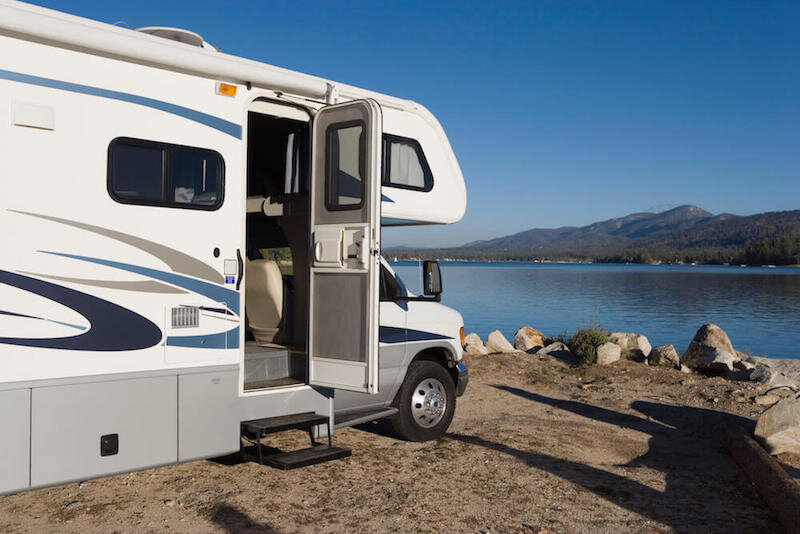
For families with children, a traditional motorhome makes the most sense, because they tend to provide the most space and the most sleeping options.
Class C motorhomes are an excellent option for families because they feature an over-cab bed that really makes the most of the space in the RV (plus kids love to sleep in these fun, lofted beds).
There are plenty of decent Class C motorhomes on the market, and if you’re purchasing an RV you should be able to find one for less than $20,000. Lazy Daze, Gulf Stream, and Jamboree are all brands to keep an eye out for when you’re searching for your class C RV.
Best RV for Couples

If you’re planning to travel as a couple, and you’re going to purchase an RV, then I am definitely partial to Toyota motorhomes for roadtripping the USA. Toyota motorhomes are micro-RVs, which means they are about the same size as a campervan but thanks to an over-cab bed they feel much more spacious than a campervan.
Read about why we chose a Toyota Motorhome for our RV travels here!
Toyota motorhomes are the best small RV, and they also hold their value well, making them easy to re-sell quickly. The downside to Toyota motorhomes is their age, as the last ones were built in 1993. This means that you need to VERY thoroughly inspect a Toyota motorhome before purchasing it.
If you’d prefer to purchase (or rent) something newer, a campervan is the best RV choice for a couple. Campervans have exploded in popularity lately, and for good reason! Campervans are smaller than traditional RVs, which means they are easier to drive, easier to park, and they get better gas milage than a motorhome.

Campervans are also cheaper than a motorhome, so you can easily find one for less than $15,000 if you’re planning to purchase an RV for your trip. Trusted campervan brands in that price range include Road Trek, Dodge Pleasure Way, and Horizon.
If you’re planning to rent an RV, Outdoorsy features LOTS of campervans, and they are cheaper to rent than a motorhome!
Best RV for Singles
If you’re planning to take a solo RV trip then your options are endless because the smallest RV options will work for you.
Campervans, converted mini-vans, SUVs with rooftop tents, and truck campers are all excellent choices for solo travelers since you won’t need as much space as a couple or family would. You can easily find an RV in this category for around $10,000.
If you’re renting an RV, you will be able to find most of these options on Outdoorsy, especially campervans!
For detailed information on all of the different types of campers, tips for purchasing a camper, and the very best tips and tricks for long term RV travel check out my Ebook- Nomads in Campers: A Step by Step Guide to Living Your Nomadic Adventure.
RV Trip Planner Apps
There are a few apps that make RV trip planning a breeze, and that we use CONSTANTLY on our RV road trips. If you’re the RV road trip planner for your family, then you need these four apps!

Google Maps
This is an app that most people already have on their phone, and if you don’t it’s free to download.
Click here to download Google Maps for Android , and click here to download Google Maps for Apple IOS .
After trying several different mapping apps that claimed to be “the best”, we always found ourselves using Google Maps as our primary mapping app. Google Maps has the most data of any mapping app, and that really makes a difference when you’re in remote areas of the US.
A sweet hack for Google Maps is to check when you’re going to lose cell phone coverage (use the next app in our list for this), and before you reach that point have Google Maps start the directions to your destination. Once you lose coverage Google Maps will still pick up your GPS signal, and it will complete the directions even though you no longer have cell service!
Maps.Me is a great secondary app for when you will be outside cellular coverage for long periods of time. It allows you to download maps to access when you’re offline.
Occasionally we will spend several days in an area with no cellular coverage, and in those cases Maps.Me is great as long as we remembered to download a map of the area before we lost coverage!
Coverage is a free and simple app that allows you to check where you will or will not have cell phone coverage. You can filter the maps by cellular carrier and signal type (LTE, 4G, etc), making it easy to figure out how good your cellular coverage will be in any location.
Trail Wallet
Trail Wallet ROCKS for budgeting your RV trip! This vacation budgeting app was designed by travel bloggers for travelers. It allows you to set a daily budget, or a budget for your entire trip, and it alerts you when you’re overspending.
You can select the categories and currency you want to use for your budget, and it’s free to download!
Best RV Camping Apps
There are two camping apps that will cover all of your RV trip planning needs. These are the only two apps we ever needed while RVing the United States (we certainly tried plenty of other apps, but these two were the BEST).

AllStays is not free, but it is WELL worth the cost. Allstays lists nearly every single official campground and RV park in the USA, both private and public. This app allows you to filter by all kinds of parameters including cost, facilities, campground type (BLM, KOA, etc.), and much more.
AllStays will help you find the best RV parks on your route, and it also lists free overnight parkings spots like Walmart, Cabelas, and casinos.
The app will use your GPS signal to locate all of the nearby campgrounds in seconds, and the provided campground reviews make it easy to choose a place to park for the night!
Unfortunately, this app is only available on Apple IOS at this time ( download it here ), but you CAN use the Allstays website on your Android phone to locate the same information.
iOverlander
iOverlander is the best RV app for finding free campsites. This app is free to download, and crowd sources its information. This means that real RV travelers contribute the GPS coordinates for places they camped, and you can contribute to the app as well!
iOverlander features reviews and photos of campsites, and it also lists services that are useful to RVers such as truck stops, mechanics, and dump stations.
We used iOverlander constantly to find good boondocking sites in both the United States and Mexico.
Best RV Campgrounds
In our experience the best RV campgrounds are not RV parks (in fact, we wrote a whole article about why we avoid RV parks ). Instead, we prefer state and federally run campgrounds which tend to be quiet, affordable, and beautiful!
With that said, sometimes you will have to bite the bullet and stay in an RV park. When this happens be sure to read the reviews beforehand, and don’t forget to ask about discounts! Tom often received a discount at RV parks for being a retired firefighter.
The AllStays app lists BLM, USFS, and state park campgrounds when you search for a campsite, and that’s the easiest way to find publicly owned campgrounds.
Check out this guide for all the information you need to find beautiful, affordable RV campsites!
Best RV Road Trip Routes

The most fun part of planning an RV road trip is choosing where you’ll go! There are so many incredible road trips in the USA it can be tough to choose one!
Here I’ll list our favorite US RV road trips by region. If you have a few months you may be able to do all of these in one trip!
Best RV Route in the Eastern United States- Gettysburg and the Blue Ridge Parkway
Gettysburg, Pennsylvania is one of the famous historical sites in the United States. Here you can learn all about the history of the American Civil War, and walk the fields of Gettysburg, where one of the most infamous Civil War battles took place.
There are tons of RV parks around Gettysburg, so you shouldn’t have any trouble finding a campsite, though the camping in this area is quite expensive.
After Gettysburg make your way south to Shenandoah National Park where you can hop on the gorgeous Blue Ridge Parkway, America’s longest scenic highway!
The Blue Ridge Parkway stretches for 469 miles, and I recommend taking 7 days for this road trip so you can really enjoy all the beautiful sights. The best time for this drive is in the fall when the trees will turn bright red and orange all along the parkway.
Best RV Route in the Southwestern United States- Joshua Tree National Park to Lake Tahoe via Highway 395

Highway 395 is my favorite US road trip for RVers! This spectacular drive begins in Joshua Tree National Park, then takes you north to Death Valley National Park, and along the mind blowingly beautiful Eastern Sierras to Lake Tahoe in California.
I can’t think of any other US road trip as jam-packed with beautiful scenery, while also offering plenty of uncrowded, quiet stops.
This route also features tons of gorgeous, affordable campsites, making it a great option if you’re RVing on a budget!
Be sure to stop in the Alabama Hills, just north of Bishop, CA. There you’ll find several BLM campgrounds that cost just $5 per night, and feature the most beautiful mountain views I’ve seen in ANY United States campground. (Just check out the view from our RV window in the picture below!)
I recommend giving yourself two weeks for this RV trip so you can spend a few days in each national park and still have plenty of time to visit the many sites along the highway (Bishop, the Alabama Hills, Mono Lake, and Lake Tahoe are all must-see stops)!
This drive is best done in the late spring because it will be cool enough to enjoy Joshua Tree and Death Valley, but still warm enough to avoid snowfall in the mountains!
Best RV Route in the Western United States- Highway 101 from Olympic National Park, WA to Prairie Creek Redwoods State Park, CA

Highway 101 runs along the Pacific Ocean from Washington all the way to southern California.
Most RVers only ever drive the southern portion of Highway 101 in California, and that is a huge mistake! Highway 101 is actually at its best along the Oregon coast, where the lack of mansions lining the coast means that you’ll actually get to ride along the ocean for most of the drive.
Also, Washington and Oregon both feature well-managed state park systems with beautiful, clean, and affordable RV campsites all along this route. While I do recommend you head all the way to Prairie Creek Redwoods State Park in California (the redwoods are AMAZING), prepare to be disappointed by the campgrounds there.
I recommend taking at least two weeks to complete this epic RV trip so you can spend time hiking, swimming, and really enjoying all of the scenery you encounter! This trip is best done in late spring, summer, or early fall, as the rest of the year will be cold and rainy in this area of the country.
Best RV Route in the Northern United States- Yellowstone and Glacier National Park
Yellowstone and Glacier are two of the most beautiful national parks in the United States, and you can visit them both in one epic RV vacation !
Begin this 962 mile journey in Yellowstone National Park, then make your way through Southwest Montana and up to Missoula. From Missoula you’ll make your way to Glacier National Park, and then loop back to Yellowstone.
Expect to encounter epic scenery, incredible wildlife, and plenty of delicious local food and drink options on this trip. There are many campgrounds along the route, but if you want to stay in the national parks reserve in advance- they fill up fast!
I recommend at least three weeks for this trip, and it should be done in the summer when you won’t have to worry about snow and ice.
Essential RV Road Trip Accessories

There are a few items that you must have with you for a successful RV road trip (no, a cute dog is not required, just highly recommended)!
These are especially important if you plan to spend any nights in remote, wilderness camping areas (BLM land, for example). In our experience, wilderness campsites are the most beautiful and peaceful campsites in America, so you’ll want to be able to enjoy them!
RV Leveling Blocks
You NEED leveling blocks for any RV road trip. These are an absolute essential item. Leveling blocks slip under the wheels of your RV to make sure that it’s completely level.
Keeping your RV level is really important because RV refrigerators don’t work like a normal, in-home refrigerator. RV refrigerators use an internal chemical reaction to cool them down, and the chemicals won’t combine properly unless your RV is level.
If you try to run your refrigerator when your RV is not level it will break, and RV refrigerators are one of the most expensive items in the entire RV. A new RV refrigerator costs at least $1000 so be smart and keep your RV level!
Click here to check prices on leveling blocks!

Suitcase Style Portable Solar Panel
Solar power gives you so much more freedom in your RV adventures!
Why? Well, when you have solar power you don’t need to search out campsites with electrical hookups or run a loud, stinky generator to meet your basic power needs!
A 100 watt folding suitcase-style solar panel is plenty to run your RV’s basic necessities like your lights and your water pump. This panel easily clips on to your coach battery, so there’s no technical know-how required to use this free, clean power source!
Since this solar panel folds up and has a handle, it’s easy to transport. Another huge perk to a portable panel like this is that you can park in the shade, and then set the panel in the sun!
Click here to check prices on a suitcase style 100 watt solar panel!
Quality Camping Chairs
Camping chairs are SO important when you’re traveling by RV! Sure, a lot of campsites will have a picnic table, but that won’t allow you to sit around the fire, or turn your chair in the direction of the sunset, or take a nap outdoors…you get the idea.
Having a comfortable camp chair is an absolute must on an RV vacation. Once you’re parked in camp you don’t want to have to sit inside your RV all day!
There are two camp chairs that we always travel with, and that we highly recommend:
Zero Gravity Camp Chair

This is the most comfortable camp chair we’ve come across, and we always travel with at least one of these (sometimes two, because we end up fighting over the one)!
This chair reclines back far enough to allow you to take a nap, which means it’s also awesome for reading, sunbathing, and any other relaxing activity.
On a warm night you could easily put a pillow and blankets in this chair and sleep under the stars!
Click here to check prices on zero gravity camp chairs!
Director’s Camp Chair

This camp chair provides the best back support of any camp chair we’ve tried, so if you tend to run into back pain this is the chair for you!
This chair is sturdy, and the seat and backrest stay firmly in position, unlike most camp chairs which tend to buckle a bit under weight. This chair also has a side table with a cup holder, which is really convenient for morning coffee, afternoon beers, evening beers…
Click here to check prices on director’s style camp chairs!

Now you’re armed with plenty of information to prepare you for your first big RV trip!
For much more in depth information on camper travel around North America, check out our Ebook, Nomads in Campers , where we share all of our very best tips and tricks, and tons of other useful information to make your RV travels a success!
For information on taking your RV off the grid, check out my complete guide to RV dry camping and boondocking !
We traveled North America full time for two years in a Toyota Dolphin micro-RV! Read about our favorite RV destination, Baja California, Mexico !
We don’t just travel by RV! Last winter we spent 6 months traveling Southeast Asia with only carry on backpacks! Read all about that adventure here .
Every summer we return to the western United States for our favorite festivals, including Burning Man !
Did you enjoy this post? Pin it to Pinterest!

About The Author
7 thoughts on “Ultimate RV Trip Planner: A Guide to Planning your RV Road Trip”
What a treasure trove of the most interesting and useful information. I plan on using all the apps. Wife and I starting soon with our new tiny camper. It will be ready next month. Maybe we will upgrade to a class c in the future. Thanks for people like who inspire all of use to venture out.
Jake and Cynthia
Thank you so much for the tips, just bought a Dolphin, here we go!
Yay!! Dolphins are the best 🙂 Always happy to hear from fellow Toyota Motorhome owners!
Thanks so much for the comment Jake! And congratulations on your new camper! Camper travel really is the best 🙂
Hola! I’ve been following your blog for a while now and finally got the bravery to go ahead and give you a shout out from Lubbock Texas! Just wanted to mention keep up the fantastic work!
This article was really helpful! We’re planning a 2 month road trip in our class C Winnebago from GA to….somewhere! We haven’t decided where to go yet but this gave me a few ideas. Also THANK YOU for the solar panel link! We don’t have solar and haven’t wanted to install it yet so we may buy this before we hit the road!
Hi Brianna! Glad this was helpful. We LOVE our solar panel, it’s so awesome getting free, clean power! 🙂
Leave a Comment
Your email address will not be published. Required fields are marked *
Drive Across America in an RV: The Best RV Routes, Maps, and Tools
Is there anything that compares to the exhilaration of an RV adventure? To drive across America from coast to beautiful coast?
Of course, it helps if you have an inkling where you’re going and how you’ll get there. That’s where RV route planning tools, maps, and guides come in handy.
With that in mind, let’s take a look at some of the best resources available for exploration of the United States from sea to shining sea.
Shopping for your Newmar? Let us help.
We’re here to help you find the perfect coach for you.

The Best RV Route Planning Tools, Maps, and Guides
The best road trips start with a safe route that guides you from point A to point B. Most navigation apps, like Waze and Google Maps, were designed for standard cars, though.
If you’ve been driving an RV for any length of time, you know such routes aren’t always compatible with your vehicle. In some cases, a road perfectly fine for a small automobile poses a serious risk for RV navigation.
Of course, finding an excellent RV route planning tool can prove easier said than done. Did you know that Apple has more than two million apps available at the App Store? As you can imagine, cutting through the hype and finding the best RV route planning tool is far from easy. Fortunately, we’ve done the hard work for you. Here are three apps that’ll get you where you want to go in a safe, enjoyable way.
Newmar’s RV Resorts Guide
When you’re in the midst of a road trip, you want to play it by ear. You don’t want to feel rushed to get to a RV-friendly campground because you don’t know where else to go.
Worse yet, you don’t want to make the mistake of relying on an app that gives you bad or outdated information. Especially when it comes to whether or not RVs are accepted at a destination. Or which hookups are available.
That’s where Newmar’s incredible 2024 RV Resorts Guide comes into play.
This year’s guide boasts over 50 resorts across the United States. Plus, you’ll find a collection of getaway locations in Canada—new to the 2024 edition. Created based on suggestions from RV travelers, it’s got all of the tools you need to ensure the perfect accommodations every time.
Here’s what you’ll get inside:
- Highlights, contact info, and must-know information for each location
- Full-color photos and testimonials submitted by honest-to-goodness RVers
- Profiles of more than 50 resorts across the U.S. and Canada, organized by region
It comes in a mobile-friendly format that you can access from anywhere. So, stop stressing about where you’ll stay and start enjoying the romance of the road.
Mix it Up with Roadtrippers App
RV travel is about so much more than getting to a destination quickly. It’s about savoring the journey and finding many hidden gems and off-the-beaten-path spots along the way. To get the most out of memory-making, give the app Roadtrippers a whirl.
So many websites or travel apps lead their users to the same unimaginative tourist traps. But what’s the fun in that? Roadtrippers unlocks millions of the world’s most unexpected and fascinating places to its intrepid travelers.
Your road trips will never be the same. And isn’t that a good thing?
How does it work? Just download the app on your smartphone. Then, plug in your point of origin and destination. Before you know it, you’ll have eclectic, funky trip ideas, no matter your route of choice.
What’s more, you’ll be able to:
- Set guidelines for the distance you’re willing to travel off route
- Book your stay on the app
- Calculate estimated fuel cost instantly
- Search for unique destinations using general categories and subcategories
If you’re looking to bring more creativity into your itineraries, Roadtrippers’ RV maps and RV routes are the easiest way to spice things up.
Get Practical with RV LIFE TRIP WIZARD
RV Life Trip Wizard offers excellent all-around RV trip planning tools. They put painstaking research into planning and finding the best RV-friendly driving directions. But their practical tools don’t stop there. They also help out with finding the ideal campground in a pinch.
The Wizard allows you to calculate all your costs along the way, including food, fuel, and recreation. And you can map out your entire route ahead of time.
But is it easy to use?
Once you’ve downloaded the app, you can browse all the RV sites at your destination. That includes sites not affiliated with the app. What’s more, the app’s drag-and-drop interface makes it easier than ever to visualize and plan your intended route.
The advantages of the Wizard don’t stop there. It works on all devices, including smartphones, tablets, and computers.
The app also:
- Allows you to tailor your preferences such as prioritizing campgrounds where you have a membership
- Download your trip onto your GPS
- Print a summary of your trip
- Access useful information like complimentary overnight parking or recreational opportunities
What’s more, the app’s intuitive and easy to use. So, you won’t spend countless frustrated hours attempting to figure out how the app works.
Drive Across America
With the resources above, you’ll never have to worry about where to stay, play, or how much you’re spending. Get ready for the ultimate adventure while you drive across America with these fantastic apps.
No matter where you want to travel or what type of recreational vehicle you have, there are excellent free resources to help you fully embrace the “good life.”
From guides to magazine articles, we’ve got everything you need to make your next vacation an epic adventure. Ready to get started? Check out our complimentary resources , designed to help you live the RV lifestyle to the fullest.
Mise en Place
The Last New York Winter It’s the Montes’ first...
His physical condition hasn’t impeded his personality....
Campsite Safety Tips for the Family RVer
RV Driving Safety Everyone has seen it: an RV speeding...
3 Tools to Find Safe and Open RV Boondocking Sites
What is Boondocking? Loosely defined, boondocking is...
Dog-Friendly Hiking Tips
Camping and Hiking with Dogs In an RV, you and your...
Cool Hiking Gear For The RV Enthusiast
Garmin vivoactive® 4 Hiking is a great way to shake...
I took my camper van across 48 US states. These are my 10 favorites
Apr 14, 2024 • 8 min read
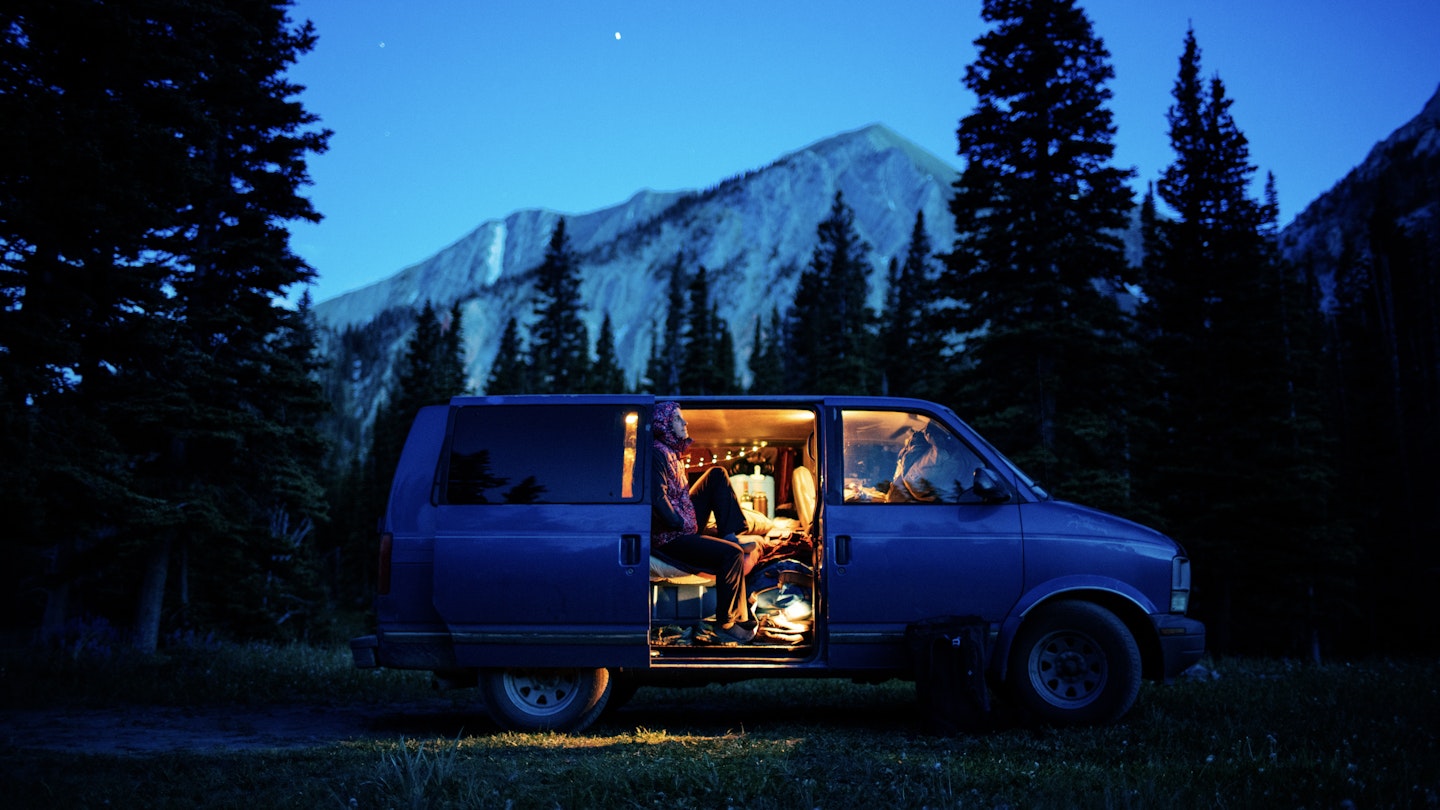
Setting off on the road in a camper van gives you maximum flexibility as you discover the USA © epicurean / Getty Images
Hitting the road in a camper van is one of the most intimate – and exciting – ways to experience the USA .
Which is why I set off on a two-year road trip with my husband and dog in 2017. We camped in 48 states, hiked countless national parks , ate in local towns and drove from coast to coast in our 1996 retro camper van.
As our trip unfolded, we learned that certain states suited us van campers better than others. The states of the Southwest , for example, contain a wide diversity of landscapes within their free public lands. The East Coast amazed us with stunning fall colors and historic towns we had previously only seen in books.
While every state added something unique to our adventure, a few really stood out. Having now crossed the entire continental United States, we’re delighted to share the 10 best US states that are perfect for your next camper or RV trip.
Where to find the best US national parks for RV campers this summer
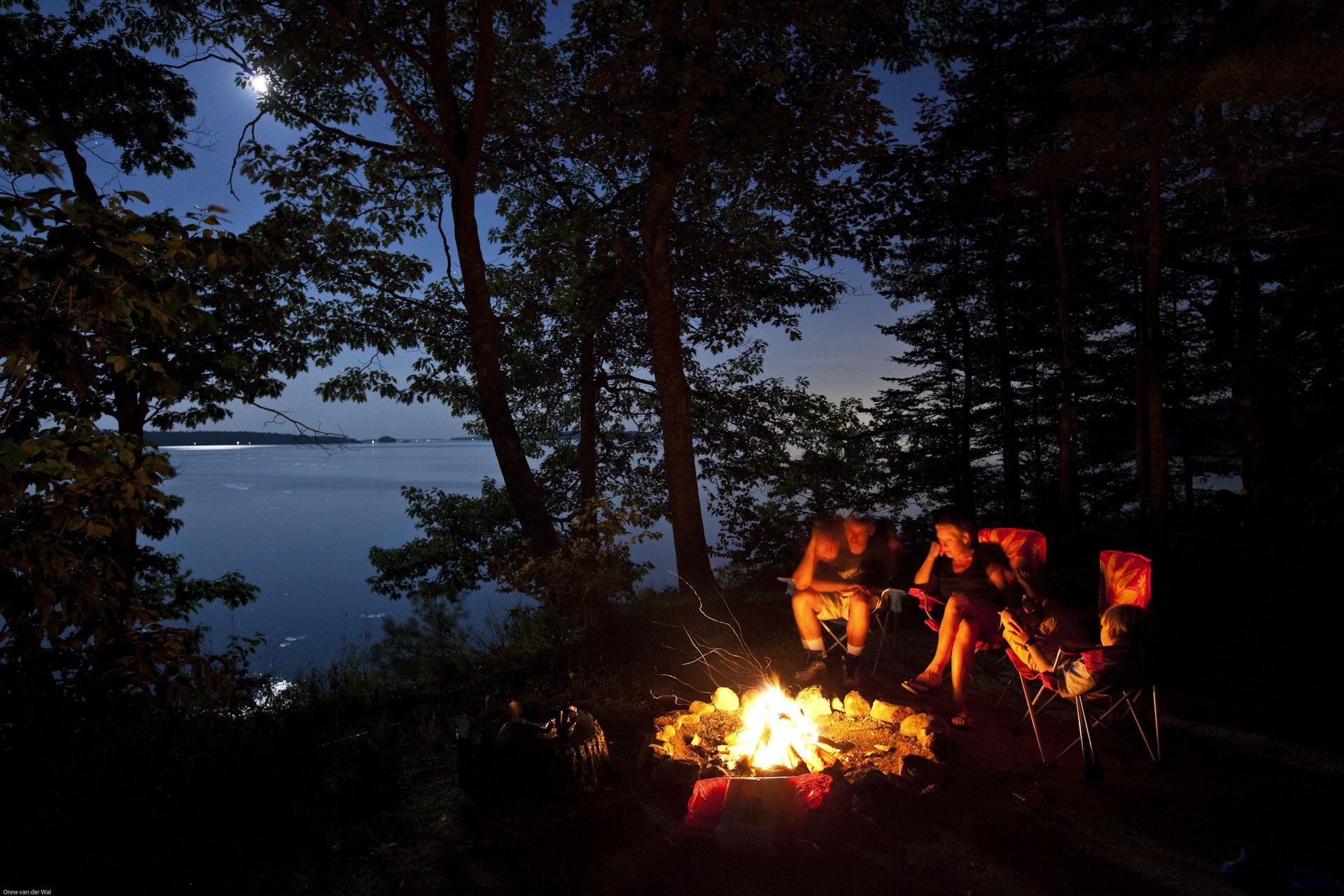
Pine forests and craggy coasts
Driving into Maine from its northwest side brings tall pine trees, skinny roads and no cell phone service for miles. This was the stuff of a novel by famous Mainer Stephen King – and to us West Coast folks, it was the unfamiliar territory that made the trip that much more exciting. In northern Maine, the entire landscape smells like Christmas trees. (We learned from a fellow camper that balsam fir collected from Maine provides the largest supply of Christmas wreaths in the country.) Heading toward the coast, we reached Acadia National Park , where the mountains meet the ocean. We were happy to find that this is one of the most dog-friendly parks in the USA, which meant we got to bring our travel companion along many of the trails.
The 10 best parks in Maine to hike, snowshoe or swim
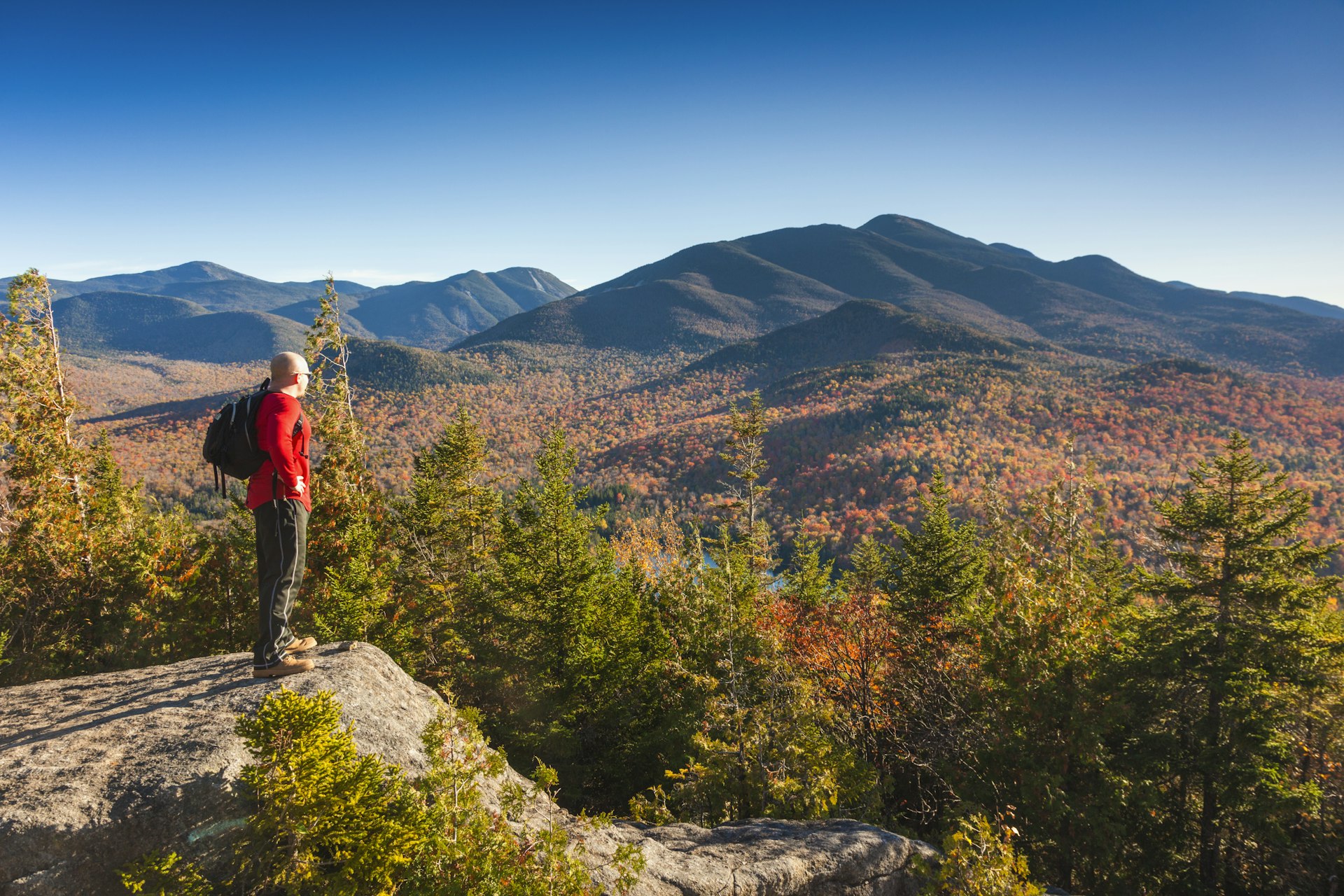
2. New York
Forget the city, and head upstate
Putting New York State on our top-10 list was a tough call, since it shares so many things we loved about Vermont and New Hampshire as well, like incredible fall foliage. Yet New York makes the cut thanks to its surprising (to us) range of geography. From Eternal Flame Falls in the state’s far west to wineries in the Finger Lakes and watchtower hikes high in the the Adirondacks , we barely had enough time to check off everything on our must-visit list. And that’s not to mention the more well-known Lake Placid Olympic sites, Niagara Falls and Letchworth State Park . What’s more the hiking trails all over the state really impressed us. Now that we’ve sampled a bit of all the state has to offer, it’s at the top of our itinerary for future road trips.
6 Hudson Valley road trips for every type of traveler
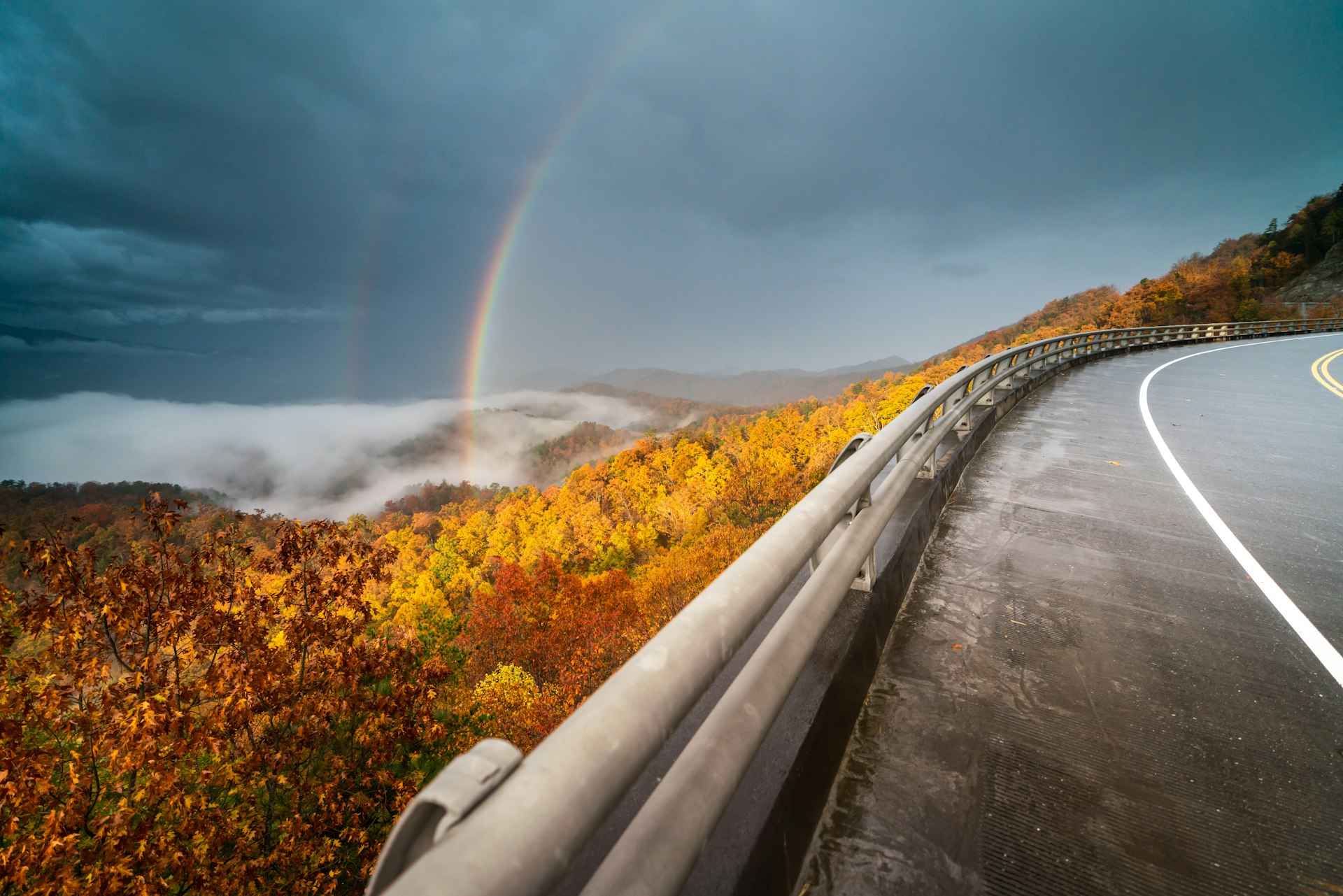
3. Tennessee
The Great Smoky Mountains are especially beautiful in fall
Great Smoky Mountains National Park is the most visited one in the whole country – and for good reason. As we visited the park and drove through Tennessee in the fall, we took in the rolling mountains and waterfalls that dot the landscape, finding countless surprises around each corner of the twisty back roads.
Traveling in a camper van, we’re always on the lookout for affordable things to do. The mountain town of Gatlinburg is the perfect gateway for enjoying free trails in and around the national park. We spent the majority of our visit hiking through the colorful forests and climbing fire towers to get the best viewpoint.
Where to celebrate Dolly Parton in Tennessee

4. California
Experience a little bit of everything
If we had to pick one state to experience a little bit of everything, it would be California . Its ecosystems are so varied that you don’t need to drive too far to witness something new; in fact, the place is so large and diverse that it shouldn’t even count as a single state. Despite the state’s famous popularity, the vast size of its public lands made finding campsites easy. Within the space of a few days, we spent evenings under the famous redwood trees, had picnics by the ocean and wandered aimlessly among the cacti of Death Valley National Park . Oh, and rock climbed in Joshua Tree National Park , took a dip in Lake Tahoe and hiked among the rocks of Lassen Volcanic National Park .
Here’s what you need to know before your trip to California

5. Pennsylvania
A cradle of American history
Pennsylvania turned out to be one of the most memorable states we visited, thanks to its role in the USA’s story. We spent an entire day taking an auto tour around the Gettysburg National Military Park , and seeing the battlefields in person brought to life the history we had read in school. Eastern State Penitentiary and Valley Forge National Historic Park were other stops we hadn’t considered before rolling into Pennsylvania. While federal public land is sparse here, Pennsylvania has numerous state parks that offer free, easily accessible camping.
The 5 best road trips in the Poconos
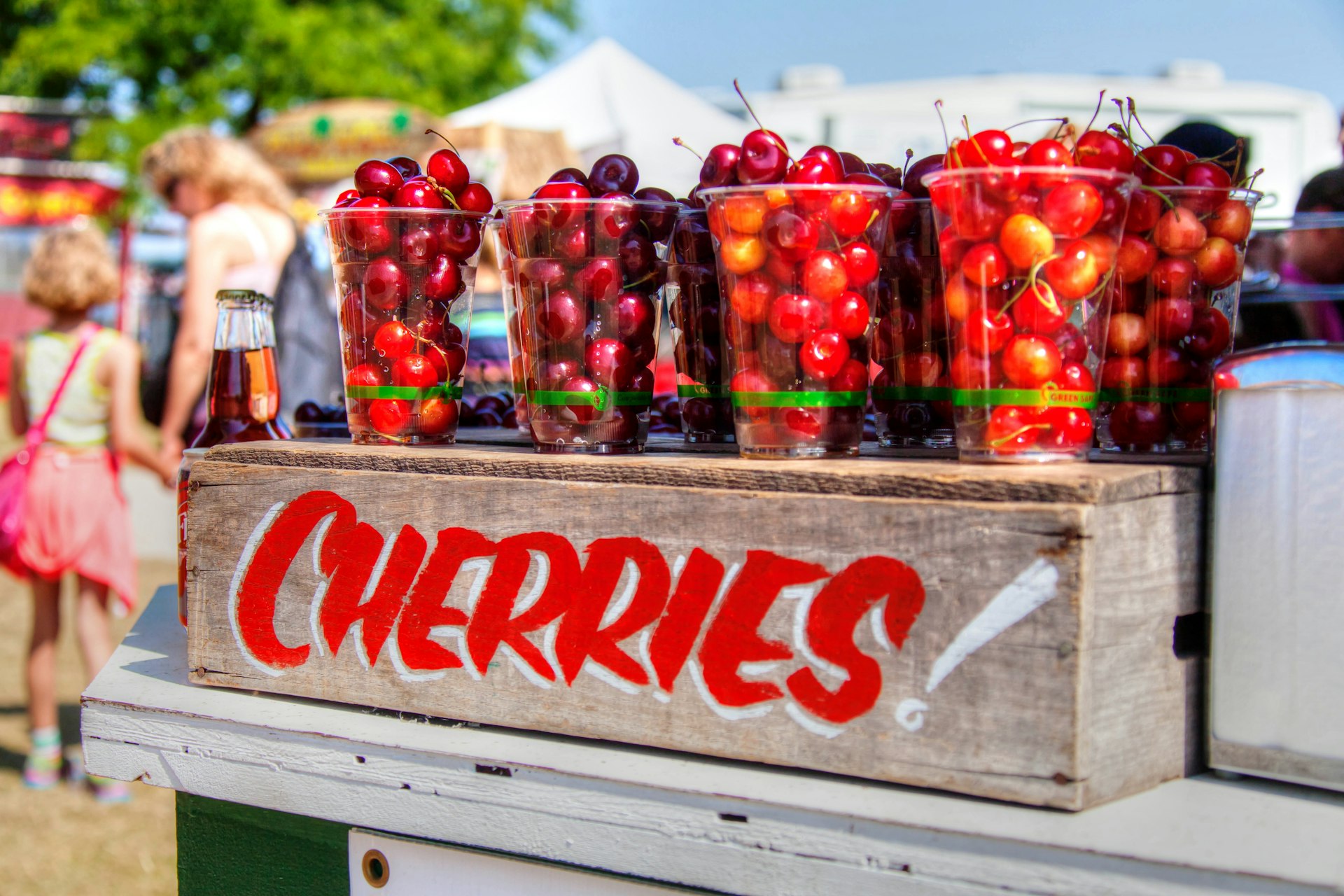
6. Michigan
Great Lakes and pristine beaches
From its southern stretches to the Upper Peninsula , Michigan has a surprising number of pristine beaches that are not packed with tourists like the ones we visited in California. One of my favorite memories is camping on the shore of Lake Superior, having dinner on a pebble beach after several days of visiting Great Lakes lighthouses.
We were able to find camping spots all the way north to the UP, feasting on whitefish and pasties (meat pies) along the way. In the summer months, bushes brim with fresh berries to pick, and farmers markets abound with fresh produce.
11 of the best places to visit in Michigan
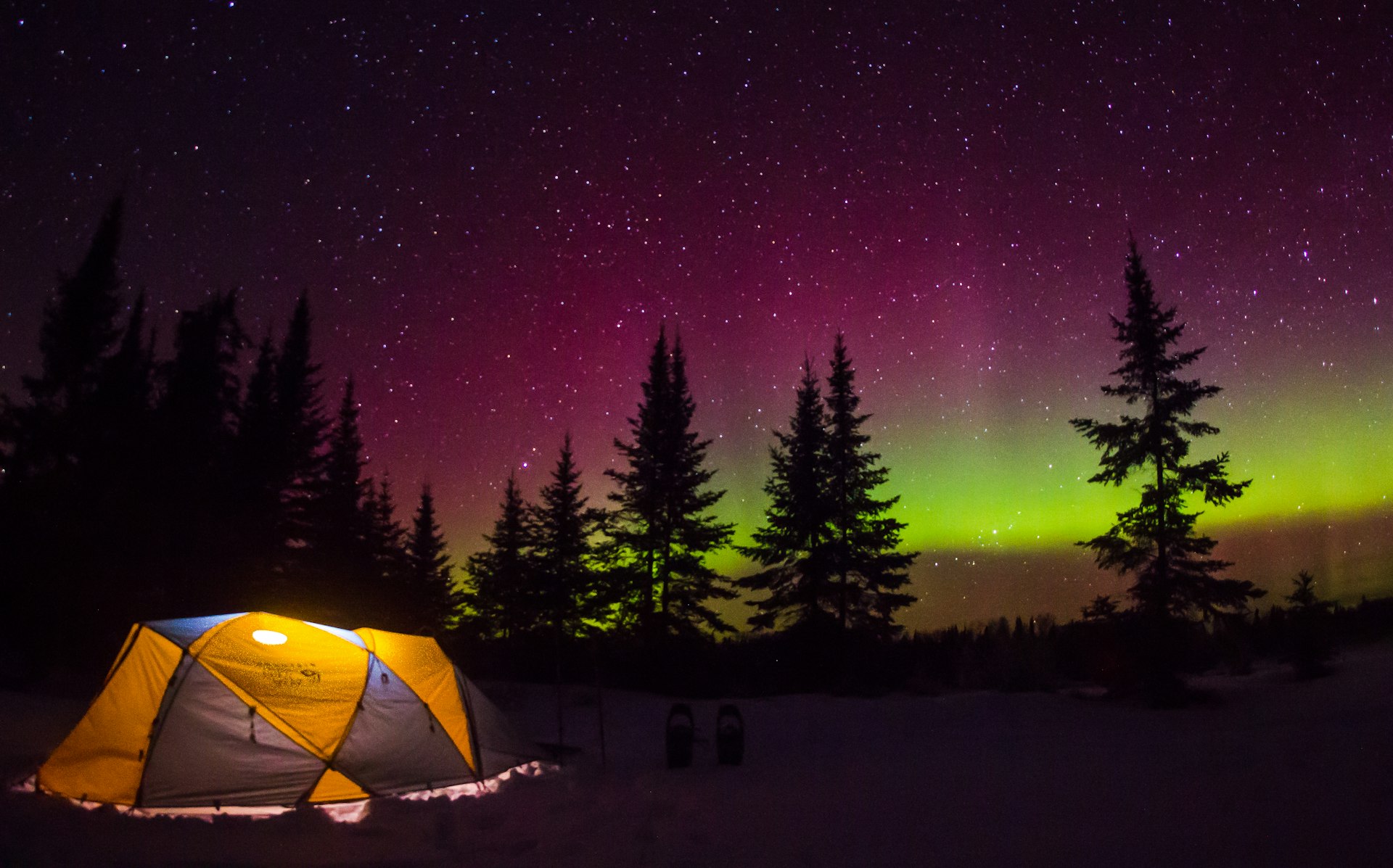
7. Minnesota
See the northern lights on a fall night
We just loved Minnesota , which rarely makes the list of top road-trip spots in the USA. Known as the state of 10,000 lakes, Minnesota had no shortage of fishing holes and quiet campsites by the water. We were able to travel all the way north to the border of Canada and take a canoe trip in the Boundary Waters . While Minnesota winters are exceptionally cold, fall is lovely here. And the chances are high that you can see the northern lights on a cloudless night.
Minnesota’s best – and most underrated – state parks

Natural wonders for everyone; off-grid travelers most welcome
For outdoor enthusiasts who love mountain biking, rock climbing and stunning hikes , Arizona is a gem. While most people (rightly) associate the state with the Grand Canyon , all of it is ripe for adventure. Free campsites are scattered in the forests surrounding Sedona , Flagstaff and southern Arizona, which makes it one of the most budget-friendly places to visit year-round.
We loved Arizona’s warmth and hospitality toward explorers from elsewhere. Indeed, the state is a magnet for anyone interested in off-grid living. Each February, the town of Quartzsite swells to accommodate nearly 2 million travelers, who visit in camper vans, RVs and converted school buses. Workshops and community events held on the outskirts of town teach travelers about van life, provide help with solar-panel installations and bring people together to share tips on future road trips. All these services for nomads provide a sense of community – which, together with the fair weather, make Arizona the perfect launchpad for an epic road trip.
Introducing Arizona’s national parks and monuments

9. New Mexico
Do you prefer red or green chile?
Starry nights. Predictable (even if chilly) temperatures. Few flying bugs. What’s not to love about camping in the desert? And when it comes to spectacular desert vistas, New Mexico is in a class of its own. Endless trails lead through spire-like hoodoo rock formations, while a lack of trees in the north allows for excellent landscape visibility, and some of the most magnificent sunsets we’ve ever seen. It’s also home to our favorite cave system, Carlsbad Caverns National Park , on the state’s southern border.
New Mexico’s camping logistics are appealing, too. Large swaths of Bureau of Land Management (BLM)–managed areas allow free camping, and the state generally flies under the radar, which makes it less crowded even in the most scenic areas. And we ate vibrant cuisine at affordable prices all over the state, an underrated food haven. Red or green chile? We’ll take both.
How to take a perfect spring-break road trip through New Mexico

Come for the national parks. All five of them
Home to five national parks , Utah might be the most picturesque state we visited. Our goal? Getting to all of the Mighty 5: Capitol Reef National Park , Canyonlands National Park , Arches National Park , Bryce Canyon National Park and Zion National Park . An essential tip we picked up along the way: get to the national parks early . By following this advice, we were able to beat the crowds; it often felt like we had the park to ourselves. Climbing Angels Landing in Zion had always been a goal of mine – but the trail can be overly packed by 10am. Arriving early made all the difference; here was a fantastic way to take advantage of the mobility a camper van affords you.
15 unique activities to add to your Utah bucket list
This article was first published Jun 19, 2020 and updated Apr 14, 2024.
Explore related stories

Destination Practicalities
May 12, 2024 • 9 min read
Check out these tips for visiting Arches National Park in Utah, including the top things to do, the best time to visit and where to stay.

May 11, 2024 • 9 min read
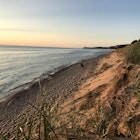
May 9, 2024 • 9 min read
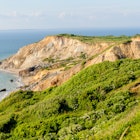
May 9, 2024 • 6 min read
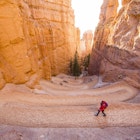
May 8, 2024 • 7 min read
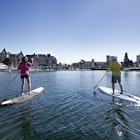
May 8, 2024 • 11 min read

May 7, 2024 • 8 min read
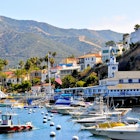
May 7, 2024 • 7 min read
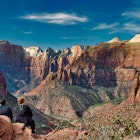
May 6, 2024 • 12 min read

How Much Does it Cost to Travel America in An RV?
This post may contain affiliate links. See our affiliate disclaimer here .
Driving around the country in an RV is one of the most American things you can possibly do. But how much does it actually cost to travel across America in an RV?

We faced a broken refrigerator, leaking roof, being struck by lightning, and even breaking down in middle-of-nowhere, Arizona. We had so many reasons to bail on our goal of visiting all fifty states, but somehow we managed to keep going. Above all, I’m probably most proud of the fact that we somehow managed to fund our entire seven-month honeymoon without going broke.
Finding a way to make money on the road wasn’t easy. We aren’t rich and contrary to all the comments on news articles about us , neither of our parents wrote a big check before we left on this trip. We had to pull together, get creative, and have a little faith when it came to making the moolah.
However, this post isn’t about how we made money.
This post is about how much we spent while on the road so that you can have an idea of how much it might cost to RV across the country.
Table of Contents
So how much does it cost to travel America in an RV?

The cost of RVing or driving cross country will be different for everyone. It all depends on your spending habits and how much comfort you need to get by. Are you willing to boondock your RV and cook a lot of meals, or do you need to eat out at all of the local restaurants when visiting a new town? There is no right answer, it just depends on your own preferences.
For us, we didn’t have much money to spend. Our goal was to enjoy as much travel as possible for as little spent as possible. Sometimes this meant passing on experiences we would have loved to go on, but it was the tradeoff for being able to continue traveling full-time. So without further ado…
Here are our final travel costs from RVing across 48 states in 2014:

All costs are for two people, just my wife and I.
- Gas: $6,593.57
- Lodging : $2,710.84 (We’re able to keep this so low mostly because of using membership clubs like Passport America )
- Groceries : $2,053.05
- Country-wide Gym Membership (Planet Fitness): $344.84
- Phone Bill: $1,311.22
- Eating Out: $512.88
- Giving: $210
- Maintenance: $1,955.72
- Miscellaneous & Entertainment: $3,432.60
Total Cost to Visit 48 States: $19,124.72
We did work on our trip as well, it wasn’t all fun and games (though it was fun). The majority of our income came through a sponsor we were able to get before hitting the road for our Hourly America documentary . Below is a rough breakdown of our income while on the road during our first year of travels.
Related Post: How Much Does It Cost to Live in an RV Full-time?
(A Little) Income

- Sponsorship (check out our course on how to create partnerships with brands) : $8,171.35
- GoFundMe campaign (asked our family to donate to our wedding vs. give gifts): $4,175
- Consulting: $2,400
- Guest Blogging/Freelance Writing: $775.37
Total Income: $15,521.72
Update: We’ve since started multiple businesses while traveling full-time. Listen to our RV Entrepreneur Podcast for more on how to build a business while traveling.
Fun facts from our 48 state road trip:
Our out-of-pocket expenses for seven months of travel was $3,603.28.
Our average nightly cost was $13.55 . (When we weren’t staying in driveways or on farms , we used Passport America to get 50% off at campgrounds. They have a $44 yearly membership that pays for itself within the first couple of times you use it. You can sign up here. )
Our average daily food cost for both of us was $12.82
All in all, the trip covered 18, 280 miles, and cost us approximately $1.03/mile .

What is it really like to RV full-time?
In our latest book, we share what it’s like RVing across America—breakdowns, bear encounters, stunning hikes, beachfront camping and all.
Order your copy on Amazon Today
Other costs associated with our travel not included here:.
Update: The only cost not calculated into this mix was the cost of the RV we bought for the actual road trip. A few comments below asked for more details about the RV so I wanted to include that here.
The cost of our RV was $11,500. It was a 1994 Leprechaun Coachmen that we renovated and eventually named Franklin. At the end of 2015, we actually sold our 94′ motorhome for $9,700 and upgraded to a 2016 Winnebago Brave .

What to do with this newfound information?
I hope you hit the road!
Since you were interested in the cost of RVing across the country, I presume you’re interested in taking a truly epic road trip. That being said, I put together a free seven-day email course to outline everything we learned in our first year of full-time RVing. You can download that course below!
Plus, when you sign up I’ll add you to a private Facebook group of full-time travelers and we can all hang out and be best friends!
If you liked this post, here are a few more blog posts that I think you’d enjoy. Safe travels!
- 21 Questions Everyone Asks Us About Living in an RV
- 50 Businesses You Can Start from Your RV
- 7 Ways to Build Remote Income While Traveling
- What RV Should I Buy?
- How do you get mail on the road?
- About Author
- Latest Posts
Love startups, traveling with our two kiddos, and RV life. Cofounded CampgroundBooking.com and sold it to Camping World. For six years Alyssa and I traveled all over the US full-time in our RV before settling in southwest Colorado.
Latest posts from Heath
- Road Trip Europe with This 30-Day Itinerary - May 3, 2024
- Our Honest Experience with Boundless Life (Boundless Life Review) - February 20, 2024
- Should You Rent an RV in Japan? What to Know Before You Go - February 7, 2024
Similar Posts

The Happiness of Pursuing an Unconventional Life: RVs, Hourly Jobs, and Seeing the World

RVE 0030: Paul and Nina from WheelingIt on Investing, Blogging, and Traveling Cheap

So, the Heater in our RV Blew Up (No Big Deal)

What RV is Right for You?

2015 Year in Review

Our Experience Renting from Cruise America (FL Keys Road Trip Day 2!)

Why I Don’t Keep a Travel Blog

A List of All of Our Favorite Campsites in New Zealand
49 responses.
[…] any debt while going on our 48 state RV honeymoon. If you didn’t get a chance to read it, I shared some details about the fact that we actually only spent $3,000 on our entire trip. The rest of our trip was completely funded by our sponsor, through our writing, and my consulting […]
[…] I hope this post was helpful, and please ask me any questions you might have in regards to sponsorships or my experience. Lastly, if you were wondering, YES it costs more than $1k/month to travel the country. We had additional streams of income that I’ve written about here. […]
Why did you choose a Motorhome over towing a camper or 5th wheel with a full-size pick up truck?
Hey Patrick!
We chose a motorhome over a camper or 5th wheel for a couple reasons. The way someone described it to us when we first started was like this: if you’re going to be in a place for over a month, then a fifth wheel might be a good option. If you’re going to travel constantly or be moving more than once a month, you might want to get a motorhome.
Overall, it’s really a preference. Some people really like fifth wheels, you can get a lot more room in them for cheaper than a motorhome. Personally, I like the all inclusive nature of a motorhome. We constantly pull over to the side of the road to make a meal and I love being able to do that. Also, when we were looking at RV’s we didn’t have a truck. If we would have bought a big fifth wheel then we would have also had to buy a truck.
Plus, I like the idea of towing our little Honda CR-V better than I like the idea of towing a big fifth wheel. That being said… at the end of the day it’s just preference. If you like having a truck and driving a fifth wheel around, then you should go with that.
Hope that helps man!
Thanks Heath. You make some valid points that I hadn’t considered. I have no experience with either RV type but plan to someday soon!
Thanks Patrick!
[…] Heath’s article on the cost of RV living […]
My wife and I have been full time RVing for all of 2015. I think you leave too many holes in your information to allow someone toying with the idea of traveling across the country in an RV to make an informed decision. I can appreciate your view for going with a class c over a 5th wheel or travel trailer. We have a 35 foot 5th wheel and quad cab 2500 Chevy and I disagree with what was explained to you about not using one if you move around a lot. We typically spend 5-7 days at each campground and have no issue hooking up or disconnecting the truck. After the first couple times, you become very proficient at it. Backing it in is the same way, you may have a few tight spots, but for the most part it becomes second nature.
I too have a Passport America membership and while it has more than paid for itself, I still feel it is mostly useless due to the number of restrictions many parks are implementing on the PA use. I really would like to know how you only spent $13.55 a night on average for your lodging cost? Again, referencing PA, most of what we saw was $18-20, occasionally $12, a night and those campgrounds were only allowing two nights max of discount. I agree there are some that give the full discount year round and are cheaper than what I listed above, but they are becoming too few and far between to be cost effective. How many nights did you actually stay in each location? Did you stay in any places that didn’t charge, like rest stops or Walmart parking lots?
Were you just traveling and not seeing many of the sights? People may get the wrong impression that you can see what the country has to offer on such a low cost. We are doing this on a budget and pick and choose what we do because we know we can’t do everything. But if you are going to travel you really need to see the sites and I don’t feel you included that in your presentation. We are planning our stops based on certain events, like Savannah, GA for St Patrick’s Day, Portland, ME for the State Lobster Festival or Pigeon Forge, TN for Thanksgiving at Dollywood. Again, we’re not going crazy with our spending, but these things do cost money. Plus we’re saving a lot by using military campgrounds and military discounts at every location. This helps but in no way does it make it cheap. I also noticed you didn’t include laundry expenses in your budget. Does your class c have a washer & dryer or do you use campground laundry? That can become a huge expense monthly, even using the cheapest of places, if you can find one.
I can appreciate you putting the information out there to help people in making a decision, but too many questions are left unanswered that someone who has never RV’d or long term traveled may not know to ask.
First of all, I’d like to say thank you for sharing some constructive criticism. I’m by no means an expert on the RV lifestyle and costs and I’m glad that you poked some holes in my argument. I’m curious if you’d be interested in allowing me to interview you via email so I could share some of your insights on RV traveling and potentially some of your travel costs + tips so I could share them in a post here on my blog?
Would love to share a different perspective. I think that would be very valuable. Would you send me an email to [email protected] ?
This Is a great review Heath!! My husband and I have talked about RV’ing but you never know where to start!! We enjoyed your article and the fact that you left a broad scope of how much it would actually cost based on preferences. We would be comperable with you guys’ spending as we aren’t drinkers and wouldn’t eat out or be trying to attend big festivals or events where everything’s more expensive on average. Loved the review and will stay in touch if we decide to pull the trigger on RV’ing full time!! 🙂
Deb Clinton
Awe that’s awesome Deb! Would love to have you join our Facebook group. There is a lot of great resources from people who are currently making the transition into full-time RV life :). Here is a link https://www.facebook.com/groups/makemoneyrving/.
This is some good info. My wife and I are planning to leave around May 1st to begin our 48 state trip. Were in the process now of buying a RV, or we have been leaning a bit more to class B RV (van type). We plan to tow my harley on a 5×8 super light trailer.
As we battle between a Class C and Class B, i have been trying to figure out the best way to go at it. I myself am a medical retired swrvice memeber and our income is a bit fixed. Im thinking and planning to survive off 1500 a month during our trip. Including gas and food. Our trip is mapped and we will be doing 15K miles total from start to finish. Thats in the RV. As we camp for place to place will use the bike to see the sights.
We plan to make the trip in about 4 months. So the accomplishment is more about making the journey and not as much about camping in places for any extended amount of time.
Couple questions,
What type of RV did you use? Did you utilize free camping on BLM land, as well Walmart lots, rest stops, etc? Any words of wisdom?
Im very intrested in this topic as none of my friends have done this before and we will be the first in our clan..
Thanks, Lonnie
Hey Lonnie,
Taking your questions into considering, I decided to edit this blog and add our RV cost and description above. That being said, we bought a 1994 coachmen (class c) motorhome. It ended up being a great choice for both of us. We didn’t do a lot of free camping at Walmarts, but we stayed with a lot of extended family and friends across the country.
Also, I would heavily suggest you check out this free resource I put together on how to travel on $2k/month or less. It’s basically everything I learned on our 48 state road trip on how to make it happen super cheap. I believe there would be a lot of great resources in there for you guys. Here is a link –> https://app.convertkit.com/landing_pages/1291
Thanks again, Heath.
I added myself to the link as well will search and hope to join your FB page. Were super excited about this journey and have been searching RV’s as I write. We narrowed it down to about 6, all are 22ft and below. Mostly 80’s RV’s. I have some mechanical skills, plus pretty handy with most other things so we are going a bit cheaper then you did on the RV. We actually found a few within the $3500 range.
I dod notice you had started a gofundme page to help with cost. I put some consideration into this, but we haven’t decided to take that step quite yet. I think we’re going to try this on our own. However, thats a great idea.
As we contiune to put things together for our departure date, May 1st 2016. I hope to keep in contact and possibly see you guys on the road. I have started my own jurnals as well have a wix page for blogging and articles. Perhaps will swap emails and links at some point and we can follow each other.
Cheers, Lonnie “The Wanderer”
Hey Lonnie, yes, the GoFundMe page was actually just for wedding guests of ours to donate instead of give us gifts (since we left right before our wedding). We didn’t actually try to use that to pay for our trip. And I added you to the Facebook group, excited to chat with you inside and help you guys get started on the road!
I’m in the planning stages of RVing for a long period. My question is what do you do for internet and phone connection ? Did you just go with the company that has the most coverage like Verizon. Question two when do you decide where you will be parking for the night? it is before you leave in the morning or when it starts getting late in the day
Hey Dan, we use a Verizon Jetpack. I did an interview last week on my podcast where we covered all the different ways to stay connected on the road (you can listen here: http://www.heathpadgett.com/rve-009-technomadia-mobile-internet-self-driving-rvs-nomadic-career/).
As far as parking for the night, we typically google “RV parks near (city we are visiting” before going to each location and then cross check with review sites like Campendium and RVparkreviews.
Hope that helps!
Hi! My husband and I would love to get a travel trailer and do a year on the road with our 3 kids……we probably won’t be able to until the littlest is out of diapers, but do you think it could be done on 1500 a month? (Husbands current disability income). We will have to finance the trailer which is 23,000….but the towing vehicle is paid off.
Hi Melissa! I’ve met people who have traveled on less than $1,500/month. But if I had to finance the trailer and had 3 kids, I personally don’t think I could do it … nor would I try. I’m a super optimistic person, but that is certainly cutting it close. While it can be done on $2k/month, you don’t want to be cutting it so close that you aren’t able to have fun on the road. Hope that helps and isn’t discouraging. That $1,500 gives you guys a TON of flexibility to build up some more income on the road however. I would recommend checking out workamping opportunities, where you can have your housing and things like that covered. If you were to workamp in different locations, you would probably be able to make that amount work. Thanks for reading! 🙂
Hey Heath, my wife and I will be heading out on an adventure this coming June. Our attempt is to hit all 48 states (we have already seen all of the east coast) and see as many of the national parks while on the road. I have only seen one map out there for such travels. Any suggestions on routes or must stop places would be greatly appreciated. We have about 6 to 7 weeks to see as much as we can. Thanks Ricky
My wife has posted a lot more about specific places we’ve visited on her blog at http://alyssapadgett.com/ , would definitely recommend checking out some of those places. My top list of national parks are Glacier National Park, Teton National Park, and then Yellowstone. The pacific coast highway in our RV was unforgettable (an absolute must). There are way too many things to list here in one comment :). Come over to our Facebook group and ask there! I’m sure people will be able to give a lot of awesome recommendation! https://www.facebook.com/groups/makemoneyrving/ Thanks for reading!
Hi Heath! My husband and I are planning on RVing the country as of January 1, 2017 with our son – who will be 18 months by that time…and of course, our cat! I was wondering what you did, if anything, about having some kind of health care coverage while traveling. We just want something for emergencies/hospitalization only (God forbid). Do you know if there are any health insurance companies that offer statewide coverage? Thanks so much – your website is great – so inspiring and informative!
So, we do have coverage that will take care of us on the road. I would recommend talking with the folks over at the RVers Insurance Exchange. That’s who took care of us :).
[…] How Much Does it Cost to Travel America in An RV? […]
[…] and we spent around $6,000 total on gas throughout 7 months. You can read more of those financials here on this post I […]
Hey ! We are 2 friends that want to trevel in america for 2 months with a rv. We are coming from Israel and we would for some more info, costs, young trip (we’re 22 y o ) thanks!!!!
Hey Dan! That’s awesome. Why don’t you check out this blog by my wife? http://alyssapadgett.com/cost-to-live-in-rv/
Hopefully that will answer some of your questions! I would recommend looking into a company like Cruise America, RV Share, or El Monte for renting an RV for 2 months (unless you choose to buy and re-sell one!)
The adventure of a lifetime for us (wife, dog, & 2 kids) is in phase 1. I am in software sales, burnt out, and want to get back to what’s most important to me…family (which is tattooed horizontally across my left bicept). I am new to your site, just downloaded podcast #1, and are plotting our course. Lots of questions, hopefully most will be answered by folks like you. looking at what I can do for income. I enjoy woodworking, film school grad (video work maybe), and lifetime salesman. I want to start a video blog/website…any suggestions?
Thanks Mike
Hey Michael!
Great to hear from you man. I can relate to a couple of those things (burnt out sales guy and film experience). That being said, advice for starting a video blog? Advice other than just start?
My advice would be to check out the niche of woodworking and study some of those guys on youtube that are earning an income doing their woodworking skills and accruing lots of views. The next step would be studying them and then starting a channel of your own. The biggest thing to realize would be that it could (and most likely will) take years to monetize and build something profitable (depending on your personality, skills, consistency, etc).
It’s possible to make an income doing video blogs via sponsorships and whatnot. But like with any unique lifestyle, it takes a lot of time.
Hope that helps,
I’m sure this is a really obvious question, but… the costs you’ve listed, are they for the two of you, or per person?
Also, me and my boyfriend both live in the UK and are looking at packing it all in, in just over a years time, to spend 6-8 months on the road in the US. We’re looking at doing it all in an RV (hence finding your site) and I wondered if you had any tips or advice on where to buy an RV from? Should we try and track one down online before we come over, or will it be fairly easy to find one when we get to the States? We’ll be on a tight budget for the RV – $3,000-$4,000 – and will most likely be looking for a Class B – nothing too long and with the bed above the cab so we don’t have to make it every day. Any advice is hugely appreciated!
Many thanks,
Hey, if you manage this, I live in NJ, near the Jersey Shore… Would love to have you come and Visit! lol South Jersey has some great beaches – from May to September. I also will be listed on AirBNB, in case you want to try a room for the night, and a lot cheaper than the motels. OR we have a lot of campgrounds in this area, offshore. Just in case. Wish you the best in your RV Search. I’m considering buying one, and living in it permanently. Not sure how THAT will work out, but I’ll have to seriously look at this for my future. Juliana
Hi Kayleigh,
I’m Matt and I just had a year long sabbatical approved, and had similar thoughts to you.
How is this all going? 🙂
I like the information that you have mentioned in your blog. Keep sharing good stuff with us. Thanks
School trips
Thanks, Ria! We try to help 🙂
[…] to all 50 states and spent $6,000 in gas alone (see rest of our expenses from that road trip here). Being able to financially cover the lifestyle removes a ton of burden and allows you to enjoy […]
[…] How Much Does it Cost to Travel America in an RV? […]
Hi I like to go the new place for visit and I also try it with fexible cost. I know I found the best information from here and I make it smoothly in here. Thanks for travel service information in here.
My girlfriend and I have been considering doing this for the last six months or so.
She hates her job and I work on whatever I can find online as a content writer and PHP/MySQL programmer/IT consultant after quitting my very stressful job as a manager of programmers and IT support persons at a large pharmaceutical company.
Money isn’t super consistent but I know I can always at least pull in 3000 per month writing random content for blogs and businesses and she is learning Photoshop so we can start creating sites and blogs for others from design to deployment on our own.
We’ve set my birthday (July 11th) as our departure date and we have so much to do before we leave. This is the first article of yours that I’ve read but I intend to scour the rest of your site for information.
We intend to create a large social media presence for our adventures across FB, blogging, Instagram, Snapchat, etc… so I get the feeling I’ll be asking you for help along the way
Safe travels and thank you for the excellent post!
That’s awesome Charles!!! Congrats dude. Y’all are in for an adventure! We’ve been fulltiming it for three years and we absolutely love it!
… [Trackback]
[…] Read More here: heathandalyssa.com/cost-to-travel-america-in-an-rv/ […]
Thank you for sharing your experiences! So inspiring! We’re a family of four, from Brazil and we love to travel. In the last 6 years we’ve been coming to USA to drive around, with no stablished routes, but an initial point and a last one, then, returning to Brazil. Today we (me, my wife and my daughter – our son stayed in Brazil for his school’s last exams) are in Akron, Ohio, resting for our next step, spending a couple of days in Chicago. Where after there? Don’t know yet. But incredbly I’ve talking with my wife about taking a year or two and buy a RV and travel around the contiguous states. And I found you. Once more, than you for sharing your experiences. And I already started dreaming about this trip. God bless you!
Hey Bob! Wow that sounds awesome!! I would definitely recommend it. The more we see of America, the more beautiful we realize it is!
how much did y’all pay for the RV?
We bought it for $11,500 and sold it 18 months and 20K miles later for $9,750.
[…] we put into the interior and the maintenance costs during our 50 state road trip (you can see those in this blog post). But hey, $1,800 to live and travel in an RV for 18 months isn’t […]
[…] and there are many other examples of full time RV budgets that weren’t as high as ours, like Heath and Alyssa who lived for under $30,00 in 1 full year (although they lived SUPER frugally), or this couple who […]
[…] How Much Does it Cost to Travel America in An RV? – · Driving around America in an RV is one of the most American things you can possibly do. But how much does it actually cost to travel America in an RV? I never in a million years would have thought I’d spend my entire honeymoon RVing around the country, but that’s exactly what happened. […]
[…] How Much Does it Cost to Travel America in An RV? – Driving around America in an RV is one of the most American things you can possibly do. But how much does it actually cost to travel America in an RV? I never in a million years would have thought I’d spend my entire honeymoon RVing around the country, but that’s exactly what happened. […]
Comments are closed.
Username or Email Address
Remember Me
- START HERE!
- Work From Anywhere
- How to Start a Blog
- Heath’s Reading List
Privacy Overview

- Places to visit
- Motorhome & Caravan news
- Accessories
- Travel reports
- Tips for begginers
- Traffic regulations
USA in a camper van - a summary of the 11 best routes
Traveling in a camper across the USA warms the hearts of many caravanning fans. Start planning your dream vacation. With us, booking a camper is easy and safe.
Over the course of several months, we have published ready-made camper routes around the USA and Canada . Now we have collected them into a list of the best routes. By clicking on the photo, you will be taken to an article that describes this route in detail.

1. Attractions of the West
Southern California beaches, iconic national parks like Yosemite, Grand Canyon , Zion and Bryce, and 3 big cities - Los Angeles , San Francisco and Las Vegas. If you have time and don't know the West yet, you will discover its unique atmosphere on this route!
2. Classic Ontario road trip
From neon lights to the silence of nature: discover the diverse faces of Ontario. Before you are vibrant cities, breathtaking views, and iconic places such as Niagara Falls .
3. New York, New Jersey and Pennsylvania in an RV
Some of the most beautiful landscapes in America await you in rural New York, New Jersey and Pennsylvania. This route passes through cities such as Philadelphia, Washington, Niagara Falls , and New York City . There are some interesting surprises along the way. You can start this trip in New York, Philadelphia, Washington, Newark or even Toronto, where renting a camper can be several times cheaper than in the USA.
4. Northern California in an RV
Discover the best of California's natural beauty: this 14-day journey is your chance to discover the hidden treasures of the northern part of the state. A picturesque route through the Californian wilderness leads through beautiful redwoods, the impressive Yosemite Park and the crystal clear waters of Lake Tahoe . At the same time, you can taste world-famous wines in Sonoma County and visit Sacramento, where the gold rush began.
5. Southern California in a camper
Rent a camper in San Francisco, Los Angeles or San Diego - a city located just a few minutes from Tijuana on the border with Mexico. California is a dream come true for many people. There is literally everything here: beaches, forests, national parks. Everyone will find something for themselves here, so we invite you on a camper tour!
6. Three states - California, Nevada, Arizona
California, Nevada, Arizona - during this trip you will see man-made masterpieces and natural wonders. This is America! The distance to be covered is not long - less than 1,500 miles. You will certainly want to stay longer in some places. You can start your trip in Los Angeles, Las Vegas or Phoenix. You can also visit all the cities along the route. There are many possibilities.
7. Western Canada – the best places
Western Canada is a wonderful place to breathe deeply in nature. During this RV trip you can admire wildlife and find yourself in the heart of the Rocky Mountains. There is a lot to see and plenty of attractions: we suggest visiting Vancouver, nature reserves and relaxing in hot springs! There will also be an opportunity to admire snow-covered mountain peaks and crystal-clear, turquoise lakes. There is something for everyone on this route, regardless of age and experience.
8. Iconic places and national parks in the western USA
America is a vast expanse, but what could be better than exploring the quiet, wide roads of the Wild West aboard a camper? Explore wonderful national parks, natural monuments and monuments as you follow in the footsteps of characters such as Wild Bill Hickock, Calamity Jane and Buffalo Bill. This is the REAL America.
9. Route 66 and Highway 1
We invite you for an exciting journey along the legendary Route 66 , also known as the Mother Road! Route 66 was the main route west. Millions of Americans have traveled this trail, visiting small towns and learning about different cultures along the way. People who did business along the route made fortunes thanks to the trail's popularity, and it soon became one of the most famous roads in America! During this trip, you will also get to know another famous road - Highway 1, and at the same time you will be able to admire the beautiful landscape of the Californian coast.
10. Quebec classic – Canada in a camper
Rent a camper in Canada and take a unique route from Montreal to Quebec and on to the national parks of this region. During this journey through Quebec, you will see unique corners of Montreal and Quebec, hundreds of years of history tinged with Gallic charm, and with a bit of luck, you will also catch one of the many festivals that take place here at any time of the year. Here are interesting places, beautiful landscapes, wild nature and lots of unforgettable experiences. Each of the proposed regions offers a different experience and is certainly worth remembering.
11. Five National Parks in Utah and more
On this route we discover five beautiful, iconic national parks in Utah - Arches, Bryce Canyon, Canyonlands, Capitol Reef and Zion. In each of them you can admire surreal landscapes and experience an unforgettable adventure. However, this unique journey is not limited to one state. By the way, we will reach the Grand Canyon of the Colorado, visit the huge, impressive Lake Powell, see the monoliths in the Monument Valley and the settlement in the rocks of Mesa Verde. Along the way, there are not only hiking trips, but also rafting, biking, boat trips, picnics, walks, mule riding, stargazing and discovering what is not obvious.
12. Grand Canyon and Las Vegas
This is a short trip for those who don't have much time but would like to see the Grand Canyon during a trip to Las Vegas - not from a bird's eye view, but up close! You can, of course, extend your trip and stay here longer to visit other national parks, such as Zion or Bryce.
13. Start with Disney
From Orlando to Florida Mr. Handle and back. This time the route does not lead from north to south of Florida, but west. This is an opportunity to visit slightly less populated beaches and admire the beauty of Florida that not everyone knows. This route goes right to the Alabama state line. At the same time, you can visit the capital, Tallahassee, and finally reach the Walt Disney World.
14. Texas and Louisiana
This time we invite you to an adventure in which history is combined with a pinch of mystery, and the whole thing is complemented by a huge dose of local hospitality and unique food. After all, Louisiana is famous for good fun and even better music! The next point on the agenda is Texas - the Lone Star State. Apparently it's a state unlike any other, so it's worth taking the opportunity to visit local towns, walk on vast beaches where the wind dances, try fresh seafood and relax under the warm Texas sky. Can you imagine a better rest?
15. Death Valley and Lake Havasu
We propose this small loop as an addition to the main route, e.g. to 5 National Parks in Utah . It starts and ends in Las Vegas, but can also be chosen from an RV rental in Los Angeles or any other Cruise America rental on the West Coast. Death Valley is the lowest-lying area in North America and one of the national parks worth seeing.
Do you want to rent a camper in the USA?
Start by reading the article: Camper through the USA: A guide for beginners and more . You will find all the important information you need to plan a camper trip around the USA.
Check rental prices for various types of campers in various locations and dates in our price search engine at: www.usakamperem.pl . Remember that we guarantee lower prices than when booking directly with Cruise America RV Rental. You can check rental prices at a total of 45 locations in the US and 5 locations in Canada. We know the booking prices 1.5 years in advance.
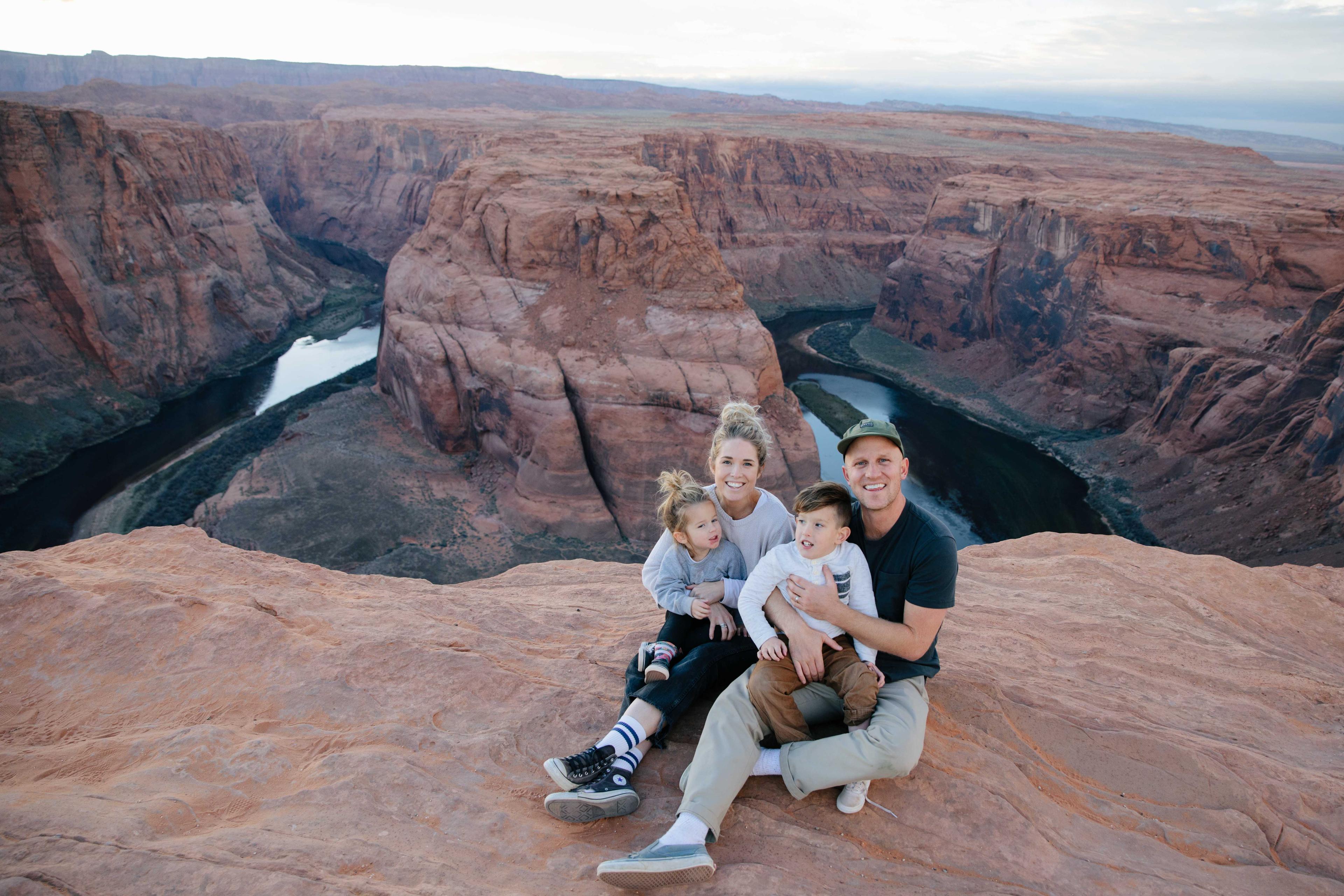
We are the only official representative of Cruise America and Cruise Canada in Poland. From 2020, you can easily and safely book a motorhome in the USA or Canada. We know when and where it is best to rent a motorhome. We will answer all your questions and doubts by e-mail or telephone.
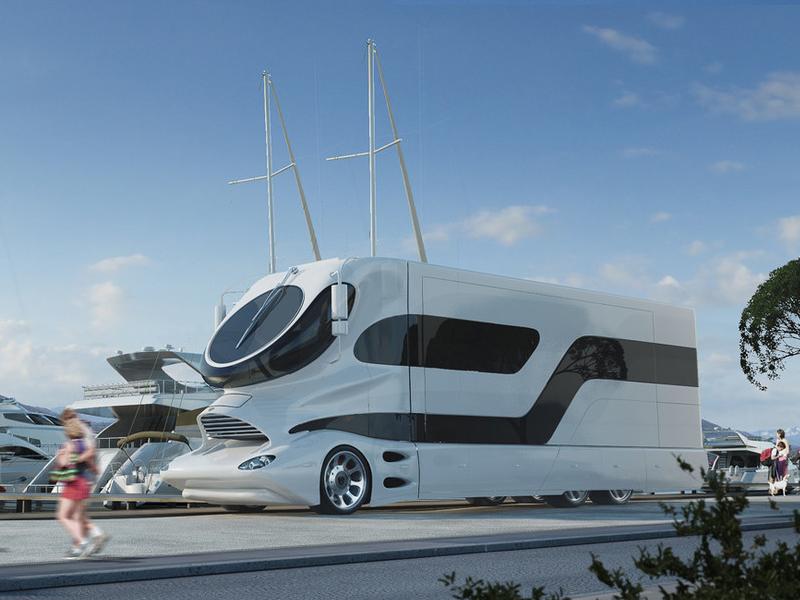

How One Couple Uses An RV To See The World Full-Time
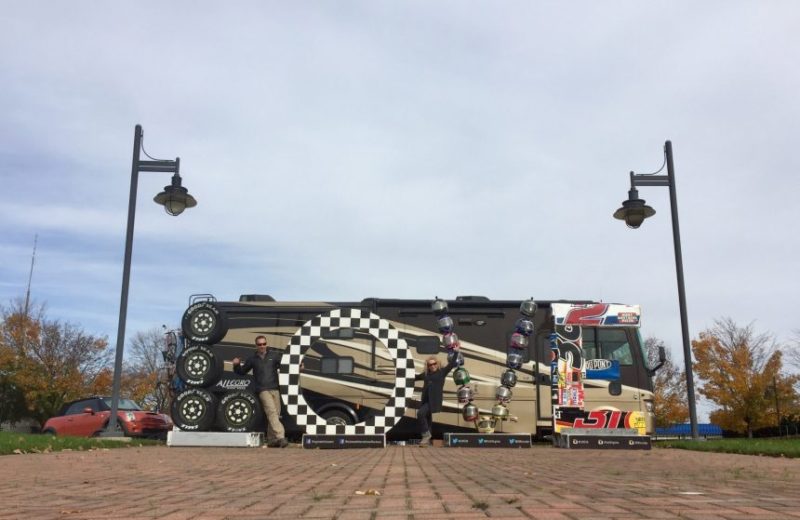
By Michele Herrmann, Jessie on a Journey Contributor
Could you imagine downsizing your life, packing up your belongings and traveling full-time by RV?
That’s exactly what Marc and Julie Bennett did, documenting their journey on their blog RVLove , as well as their entertaining and informative YouTube channel . Since 2014 the Bennetts have traveled to all of the lower 48 states plus Hawaii — with Alaska on the horizon — driven over 50,000 miles and visited more than half of the 59 national parks.
And it’s not only US travel by RV, either. They’ve walked across the border into Mexico and explored Australia. Next up: Europe in 2017.
Jessie on a Journey spoke with the couple about RVing, particularly how they ensure a safe and smooth ride. Read on to get inspired. Note: Answers are jointly shared by Marc and Julie.
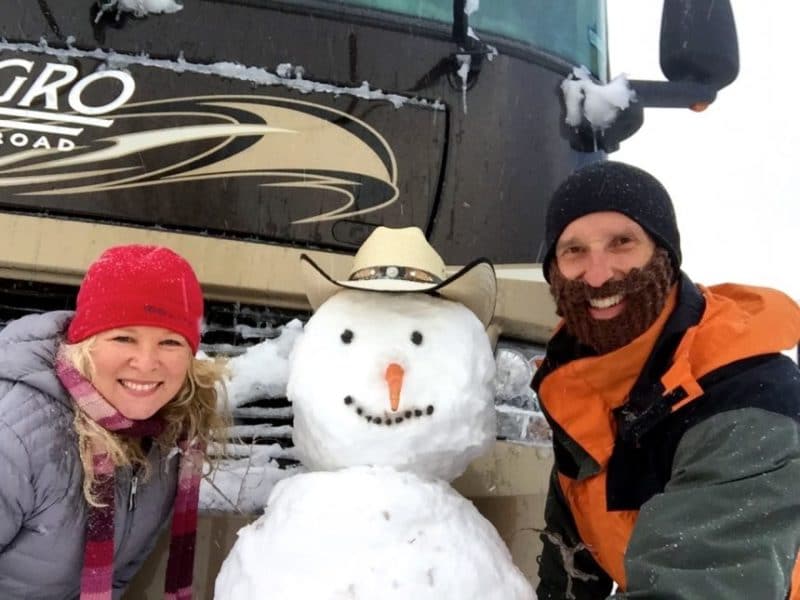
Table of Contents
1. What made you choose to RV as a lifestyle?
Each year, we make a point of sitting down and taking the time to focus on what we want to create for our lives in the years ahead. Then we start putting steps in place to make our dreams and goals happen.
When discussing what was most important to us, it became very clear that travel was dominating the conversation. We both had a deep desire to travel more, but we had our eight-year-old labradoodle, Coda, to consider — we don’t have kids, so she was our baby. While overseas travel appealed to us, we knew it wasn’t practical with a dog, so we decided to focus on U.S. travel instead.
In October 2013, we started talking seriously about buying and moving into an RV, traveling the country while we worked.
2. While traveling by RV is known in the USA, do you find it overseas as well?
The RVing community is huge in the USA; probably much bigger than most folks would ever imagine. It was certainly an eye-opener for us. We have excellent roads here and so many incredible places to see with national parks and state parks galore. There are also thousands of campgrounds and many remote dry camping locations where you can park your RV and stay for free.
While we haven’t done RVing in New Zealand , Australia, or Europe yet, RVing — caravanning/camping as it’s called down under — is also popular, though not on the scale as it is here in the States.
Roads are much narrower in Australia, New Zealand, and Europe too — which limits the size and options for RVs. We are very lucky here for sure, as the American RVing community is very well catered to in terms of RVs, roads, and campgrounds.
We do eventually plan to expand our RV life internationally and look forward to sharing more about that experience when we do.
3. How did you choose an RV?
We remembered having an inspiring encounter with a Floridian full-time RV couple in the summer of 2011. From there, the idea of living in an RV quickly transpired into an ideal solution for us to combine work, travel and quality time together.
We chose a used 2012 Class A motorhome — like a bus. It’s 36 feet long and has four slide outs, which makes it pretty roomy inside when we are parked. Almost three years later, our choice of RV continues to be ideal for our needs.
Tip from the editor: When choosing your RV, also consider what you’ll put into it and create a list of RV must haves .
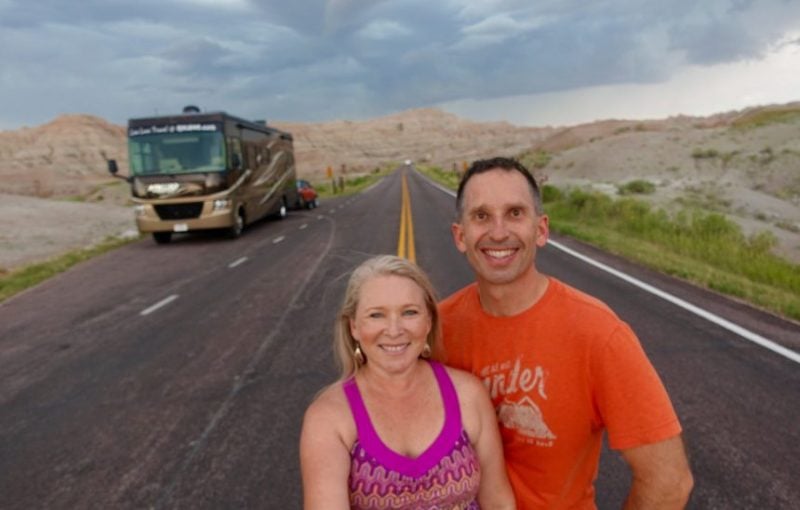
4. How does traveling by and living in an RV shape your travels?
Because RVs aren’t insulated at the same level as a stick and brick house, our travels are almost always determined by the weather. Like most RVers, we head north in the summer and south in the winter. We also like visiting places at their optimal time of year weather-wise, and prefer to visit popular places during off-season when crowds are fewer and campground fees are often lower. The beauty is we have wheels, so we can go where we like, whenever we like!
Part of all life – not just traveling by RV life – is about finding ways to deal with challenges and obstacles. As an RVer you have to learn pretty quickly to be flexible and go with the flow. Stuff is going to happen so you may as well embrace it as part of the adventure.
Instead on focusing on the problem, we try to find a solution. Having a positive, optimistic, troubleshooting attitude is a great advantage. When you live in a small space like in an RV with a partner, you’re only going to succeed by being a team. You really have to pull together to work through challenges.
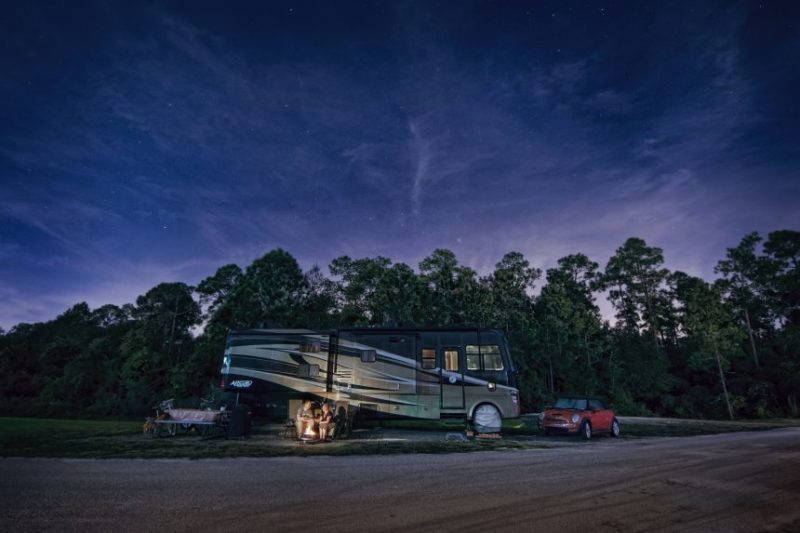
5. Do you ever feel the need to stay put in a certain area?
We try to stay in one location for two-to-three weeks at a time. This way we can properly explore the area while also having downtime for ourselves.
That being said, sometimes we move at a faster pace and stay only a few days or a week. While this can be fun and you see a lot, it also gets pretty tiring, especially as we’re still working full-time. In 2016, we only had a couple of three-week stints in one location, and we loved being able to stay still for a while and catch our breath.
During winter, we will stay in an area for longer periods. For example, we spent last winter in Florida, and this winter we’re in the desert southwest — mainly Arizona and southern California; but, we do move from place to place every couple of weeks in the general area.
6. Do you ever take breaks from traveling by RV?
In 2016, we had taken a few breaks from the road. In March, we flew to Australia for a month. We also took a “forced break” when our RV went in for repair for five days. During this time we flew to Colorado to visit family over Thanksgiving.
In December we flew to Maui, Hawaii — our 49th state visited — for nine days for an actual vacation. We stayed in hotels and rented a car to explore the island. It was great to really get away and have a very different experience. But by its end, we were also glad to get back to our RV life, our own beds and comforts of home. We love that we can truly have the best of both worlds whenever we choose.
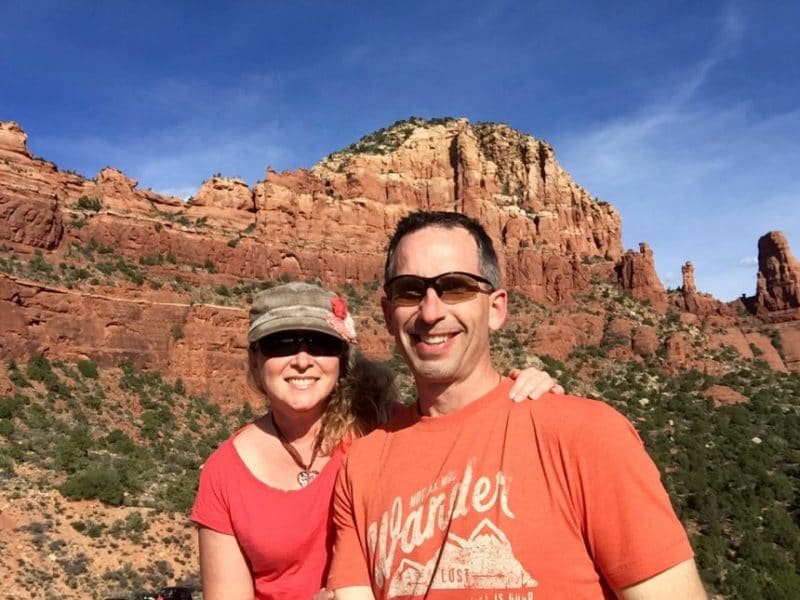
7. What misconceptions do you find the public has about traveling by RV?
I think many people don’t realize just how homey, modern and spacious many RVs really are! I’m sure many people imagine we are roughing it – crammed into a box on wheels – when we actually have a really lovely, livable home. Most people are surprised when they walk inside our RV. The first comment is usually “Oh, it’s so spacious!” They soon realize how livable it really is.
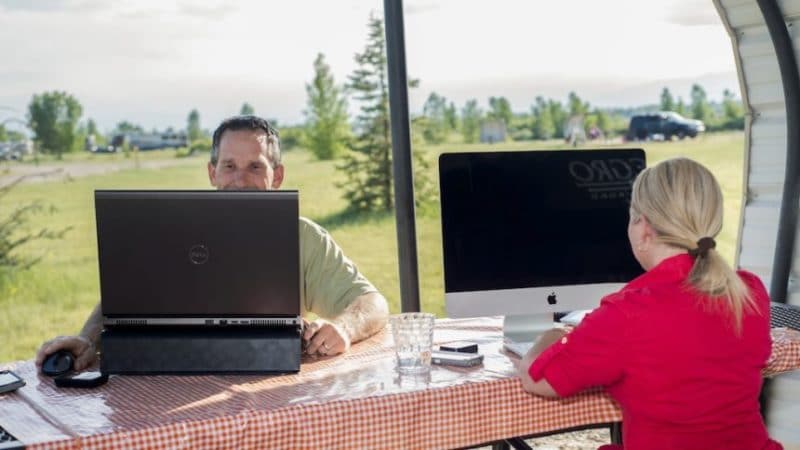
8. How are you able to maintain an income while traveling by RV?
Marc is unusual in that he has a full-time, 40-hour-per-week job for a company based out of Texas. More than half of their employees work remotely, so it was an easy transition for Marc, who gets a regular salary, benefits, and paid vacation time.
Julie is self-employed so her schedule is more flexible. She produces all of the written, photographic and video content for our RVLove website and YouTube channel. Additionally she’s working on a book and does lifestyle coaching for a handful of clients.
All of this combined brings us a few smaller streams of income, which we hope to see grow over the coming years.

9. How do you handle issues that come up when traveling by RV?
With a combination of flexibility, patience and planning! Some things we can plan for – like grocery shopping, laundry and refueling the RV. It’s easy enough to find local supermarkets and supplies, plus we use Amazon a lot. Their two-day Amazon Prime service is a must for RVers, and we can receive deliveries at most campgrounds. We do laundry every couple of weeks in the campground laundry and can usually do three-four loads at a time, which is really efficient. We aim to fill our RV mostly at truck stops which are better equipped to handle larger, taller vehicles. You definitely have to think and plan ahead, that’s for sure!
We’ve never had an issue with safety or felt at risk, but we are mindful and use common sense. Plus Marc is a former police officer, so he’s got a real sense for any potentially unsafe or dubious situations. Breakdowns are something we can’t usually plan for, but that’s where we just need to get resourceful and stay focused on problem-solving. We have roadside assistance as well, which is a must. The few times we’ve needed to leave the coach in a shop for repair for more than a day, we will usually stay in a hotel or with friends/family if there are any nearby.
10. What’s your best piece of advice for someone wanting to get into RVing?
Take the time to do your homework and research at least six months — though ideally a year — in advance. There is so much to consider, learn and do in preparation of traveling by RV. There’s no rush and if you plan properly and “get it right” early on, you can save yourself a lot of headaches and money. Start online, read plenty of blogs and watch YouTube videos to see what does (and doesn’t) work from other RVers out there doing it.
There are countless ways to thrive in the RV lifestyle; but you’ll get off to a stronger start with more confidence if you have a plan. You’ll want to have budgeted and mapped out the key elements in advance. That frees up time, energy and money so you can kick back and really enjoy the journey and, of course, start heading to those amazing destinations!
Have you ever tried traveling by RV?
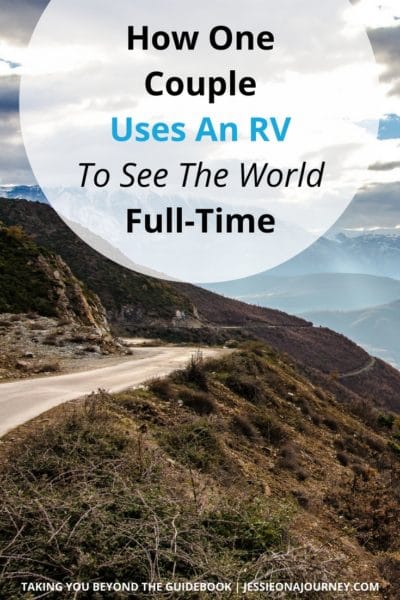
Related posts:

Hi, I’m Jessie on a journey!
I'm a conscious solo traveler on a mission to take you beyond the guidebook to inspire you to live your best life through travel. Come join me!
Want to live your best life through travel?
Subscribe for FREE access to my library of fun blogging worksheets and learn how to get paid to travel more!

Turn Your Travel Blog Into A Profitable Business
Subscribe to my email list to snag instant access to my library of workbooks, checklists, tutorials and other resources to help you earn more money -- and have more fun -- blogging. Oh, and it's totally FREE! :) // Privacy Policy .
Check your inbox for your welcome email + resource library password!
This is so exciting and inspiring! My wife and I are in the middle of planning this lifestyle now. We’re using a travel trailer and we’ll be traveling with our 6 month old and two dogs. A lot of people think we’re crazy, though most are excited for us. Thanks for the inspiration RVLove!
Sounds amazing! Good luck 🙂
Thanks for the great article!
Leave a Comment Cancel Reply
RVing with Rex
Living his dream, Rex Vogel is a Snowbird with a passion for RVing, photography, hiking, and birding.
The Ultimate RV Travel Bucket List: 51 Best Places to Visit in North America
Your road map to hidden gems, cherished natural wonders, and iconic monuments across North America

Are you looking for travel bucket list ideas for your next RV trip? Running out of ideas or looking for fresh ones? From epic classics to exciting newcomers, we have selected the 51 most amazing places to visit or things to do in the U.S. and Canada. Of course, there are many more than 51 places worth visiting.
We have traveled by RV in 47 states and four Canadian provinces but barely made a dent (and our list continues to grow longer and longer).
It’s time to pack the RV and discover beautiful and awe-inspiring places across North America. Following are many of our favorite destinations in the US and Canada to satisfy your wanderlust.

Badlands National Park : South Dakota
With ochre-tinted buttes, graceful spires, and fossil-rich landscapes, Badlands National Park, in southwest South Dakota, entrances visitors with its ethereal vistas.
Great Smoky Mountains National Park : North Carolina and Tennessee
Great Smoky Mountains National Park attracts outdoorsy types with its sublime mountain scenery and beautiful old-growth forests.

Banff National Park: Alberta
Nestled in the heart of the Canadian Rockies, Banff is Canada’s first (and arguably most beautiful) National Park.
Charleston : South Carolina
With its Spanish moss, historic architecture, coastal scenery and graceful antebellum mansions, Charleston oozes Southern charm.

Bryce Canyon National Park : Utah
Otherworldly rust-colored hoodoo rock formations are on full display at this popular national park.
Blue Ridge Parkway : North Carolina and Virginia
The nearly 500 miles of blacktop twisting through the Great Smoky Mountains and Shenandoah national parks was built for travelers seeking Appalachian overlooks.
Sedona : Arizona
Sedona attracts nature lovers with its desert landscapes, surreal red rocks, and enchanting vortexes, places where the earth’s energy is reportedly amplified.

Joshua Tree National Park : California
With jaw-dropping desert scenery, prickly Joshua trees, and distinct boulder rock formations, Joshua Tree mesmerizes visitors with its eye-catching landscapes.
Zion National Park : Utah
If your perfect bucket-list includes hitting scenic hiking trails, it’s hard to rival the otherworldly landscapes in Utah’s Zion National Park.

Wells Gray Country : British Columbia
Wells Gray has something to offer every outdoor interest: lush alpine meadows, birding and wildlife viewing, hiking, boating, canoeing, kayaking, and 41 breathtaking waterfalls.
Boston Freedom Trail : Massachusetts
Walk this 2.5-mile path (just follow the red-brick line) that passes 16 historical landmarks from Paul Revere’s house and the Old North Church to Bunker Hill and Old Ironside.

Scenic Byway 12 : Utah
The red rock majesty of Utah is on triumphant display on Scenic Byway 12 winding between Capitol Reef and Bryce Canyon national parks.
Green Mountain Byway: Vermont’s Route 100
The billboard-free Route 100 winds through some of Vermont’s most quintessentially Vermonty villages, with all the cider donuts and country stores that go with them.
Dead Horse Point State Park : Utah
Towering 2,000 feet above the Colorado River, Dead Horse Point is an iconic peninsula of rock sitting on top of incredible vertical sandstone cliffs.
Tombstone: Arizona
Arguably America’s most infamous Old West town, Tombstone, is the perfect place to see what life was like during the days of the Wild West.

Jekyll Island Club Resort : Georgia
Follow in the footsteps of visitors like J.P. Morgan and the Pulitzer family as you golf, bike, boat, swim, or trot along on a horse-drawn carriage.
Santa Fe : New Mexico
A city that embraces its natural environment, Santa Fe is a city whose beautiful adobe architecture blends with the high desert landscape.
Remember the Alamo : San Antonio, Texas
Home of the famous 1836 battle, the beautiful 300-year-old former Spanish mission turned fortress is the heart of San Antonio and Texas’ most visited historic landmark.

Okefenokee National Wildlife Refuge : Georgia
Hop aboard a flat-bottomed boat and keep your eyes peeled for alligators, egrets, and hawks during a tour of the Okefenokee National Wildlife Refuge.
Canyon de Chelly National Monument : Arizona
Canyon de Chelly has sandstone walls rising up to 1,000 feet, scenic overlooks, well-preserved Anasazi ruins, and an insight into the present-day life of the Navajo.
Mesa Verde National Park : Colorado
A great concentration of ancestral Pueblo Indian dwellings, built from the 6th to the 12th century, can be found on the Mesa Verde plateau in southwestern Colorado.

Red Rocks State Park : Sedona, Arizona
Red Rock State Park is a 286-acre nature preserve and environmental education center with stunning scenery.
Monument Valley : Arizona and Utah
The iconic landscape of Monument Valley symbolizes the American West worldwide with its towering buttes and sweeping skies.
My Old Kentucky Home State Park : Kentucky
My Old Kentucky Home State Park honors the home that was the symbol of Stephen Foster’s endearing song, the stately mansion on the Rowan Estate known as Federal Hill.

Mitchell Corn Palace : South Dakota
The World’s Only Corn Palace is a quirky but cool multi-purpose arena in Mitchell.
Mount St. Helens National Volcanic Monument : Washington
The eruption of Mount St. Helens caused a huge landslide to sweep through the Toutle River Valley and remove 1,306 feet from the top of the volcano.

Shiner : Texas
Shiner, Texas is home to 2,069 people, Friday’s Fried Chicken, and—most famously—the Spoetzal Brewery where every drop of Shiner beer is brewed.
Gulf State Park: Alabama
Gulf State Park’s two miles of beaches greet you with plenty of white sand, surging surf, seagulls, and sea shells, but there is more than sand and surf to sink your toes into.

Icefields Parkway: Alberta
The Icefield Parkway is a 144-mile highway winding along the Continental Divide through soaring rocky mountain peaks, icefields, and vast sweeping valleys.
Cherohala Skyway : North Carolina and Tennessee
Travel the Cherohala Skyway and enjoy panoramic vistas as you wind through the Southern Appalachian high country.
Catalina Highway : Arizona
With a nearly 7,000-foot elevation change in a mere 24 miles, the Catalina Highway is a brilliant ascent with countless curves, numerous vistas, and three major switchbacks.
Myakka River State Park : Florida
Seven miles of paved road wind through shady hammocks, along grassy marshes, and the shore of the Upper Myakka Lake. See wildlife up-close on a 45-minute boat tour.

Natural Bridges National Monument : Utah
These three majestic natural bridges were formed by the power of water in a landscape usually defined by its absence. View them from an overlook or hit the trails.
Organ Pipe Cactus National Monument : Arizona
Organ Pipe Cactus is the only place in the U.S. where the organ pipe cactus grows wild.
San Antonio Missions : Texas
The San Antonio Missions are a group of five frontier mission complexes situated along a 7.7-mile stretch of the San Antonio River.

Incline Railway : Chattanooga, Tennessee
Take the incline railway up a 72.7-percent grade on Lookout Mountain in Chattanooga. It’s like driving up an insanely pretty wall.
Lassen Volcanic National Park: California
See all four types of volcanoes—cinder cone, composite, shield, and plug dome. Plenty of hydro- and geothermal activity is still found in Lassen Volcanic National Park today.

Okanagan Wine Region : British Columbia
Okanagan wine region is possibly the most scenic wine region in North America and a place where RVers and other normal people can afford to taste wine.
Cedar Breaks National Monument : Utah
At an elevation of over 10,000 feet, Cedar Breaks looks down into a majestic geologic amphitheater, a three-mile long cirque of eroding limestone, shale, and sandstone.

Writing-on-Stone Provincial Park : Alberta
A wide green valley, steep sandstone cliffs, strange rock formations called hoodoos, and rock art—all of these things make Writing-on-Stone a special place.
Lake Powell : Utah and Arizona
Spend a week on Lake Powell boating through slot canyons, anchoring on deserted beaches, and camping under the stars.
Creole Nature Trail : Louisiana
Louisiana’s prairies, marshes and shores teem with wildlife, and a drive along the Creole Nature Trail gives visitors a chance to experience nature’s bounty up close.
Grand Canyon National Park : Arizona
“Grand” doesn’t do this canyon justice. Measuring approximately 277 river miles in length, up to 18 miles in width and a mile deep, this massive chasm is a natural wonder.

Jasper National Park: Alberta
The largest national park in the Canadian Rockies, Jasper is the wildest of the mountain parks and contains the world famous Columbia Icefields.
Congaree National Park : South Carolina
Congaree National Park showcases the largest tract of old-growth floodplain forest remaining on the continent.
Black Hills : South Dakota
Driving through this corner of South Dakota takes you through some of the most rugged, distinctive, and beautiful land in America.

Blue Bell Ice Cream : Brenham, Texas
Stop by for a scoop of ice cream at the Ice Cream Parlor, view how Blue Bell is made, shop in the Country Store, and learn more Blue Bell Creameries in the Visitor Center.
Colonial Williamsburg : Virginia
A living history museum and two art museums offer something for everyone, from hands-on activities to original 18th-century buildings to a folk-art collection.
Kentucky Bourbon Trail
Awaken your senses and explore the birthplace of Bourbon as you embark on a self-guided journey to discover the story behind Kentucky’s Bourbon Culture.

Ohio Amish Country : Holmes County
Ever wish you could turn the clock back to a time when life was simpler and the wheels turned a little more slowly? Now you can.
Arches National Park : Utah More than 2,000 sandstone arches dot the 47,000-acre landscape of this national park.
Worth Pondering…
“My favorite thing is to go where I have never been,” wrote photographer Diane Arbus, and so it is with us.

- Create an account / Login
RV road trips
Usa by motorhome.
Discover the richness of the American Southwest on this memorable trip. Experience the freedom to explore these varied lands, where breathtaking landscapes reveal themselves at every turn.
On the Road
Discover the great national parks of the Southwest with a motorhome as your nomad base, and experience adventure in complete freedom, between arid deserts, tranquil lakes and snow-capped peaks.
Heading South
Large sandy beaches, turquoise waters and majestic palm trees are the focus of this dream road trip in South Florida.
Best of the West
Unique rock formations, natural arches, deep canyons, rocky ridges: this is the recipe for a road trip in the heart of spectacular natural landscapes.
Cowboy Route
In the comfort of your motorhome, soak up the spirit of the Wild West on this short trip through the mythical desert landscapes of the American Southwest.
Unspoiled Nature
Wake up in the heart of the great outdoors, with nature as far as the eye can see. Discover some of the most spectacular and iconic landscapes in the American West.
Hit the Road
Cross breathtaking landscapes from vast plains to majestic rocky mountains on this road trip. Camp under a starry sky that seems to stretch on forever.
Florida by RV
From the Atlantic Ocean to the Gulf of Mexico, via lively theme parks, Florida is sure to enchant you and make you feel like a child again.
California Escapade
Between the scenic drive along the Pacific coast, the iconic waterfalls and the majestic giant redwoods, you'll have plenty to see on this short stay in California.
California Dreamin'
This dream California getaway promises a harmonious blend of nature, culture and adventure, creating memories that will last a lifetime.
5 good reasons to rent a campervan for your USA road trip
The best 2-week usa self-drive holiday, 7-day florida tour: map + itinerary, the best 3-week usa road trip holidays, the best california family tour, 10 stops along route 66 between kingman and los angeles, the ultimate california rv road trip, the best 2-week road trip in the american west, the best 10-day california road trip itinerary, the ultimate louisiana road trip, the ultimate california road trip, the ultimate family road trip in the american west, guide to route 66: las vegas to the grand canyon, the ultimate florida road trip, the ultimate rv road trip in the american west, faq on road trips in the usa, when should i visit the u.s..
It is possible to enjoy a USA road trip all year round, depending on the region you are travelling to.
For a Western USA road trip for example, peak season is from mid-July to mid-August . That is also when there are the most travellers on the road and prices are at their highest. It is also possible to travel in winter ( mid-December to mid-March ), but it is important to note that some destinations, such as the Grand Canyon and Bryce Canyon, may even see snow.
Travel in Florida is enjoyable all year round but be aware that hurricane season is from August to October.
Visit our " When should I visit? " section to learn more.
Driving in the U.S.
It's a good idea to learn about the American highway code before setting out on your USA road trip .
And our blog article " Driving in the U.S ." contains useful information, driving tips and some things you'll need to watch out for when driving in the land of Uncle Sam.
When should I book my trip to the U.S.?
For your road trip to California or elsewhere in the U.S., it is best to book at least 6 months in advance .
To be sure of availability, or to at least make sure that the top attractions are not sold out, you need to book early. For some destinations, such as the American West , many travellers book up to 1 year in advance .
Availability isn't the only reason to book in advance. The earlier you book, the more you save.
So there is really no good reason to wait until the last minute to book your trip to the U.S.!
Visit our " When should I book my trip? " section to find out more.
How do I choose between a road trip by car or by RV?
Should you take to the American roads in a rental car or RV ? There is no wrong answer.
Contrary to popular belief, it's not necessarily cheaper to travel by RV.
Check out our " Car vs RV " section to help you make an informed choice!
See all FAQ about U.S. road trips
Consult our complete list of FAQ about road trips in the U.S. or our " Practical Information " section to help in planning your trip to the land of Uncle Sam.
Customize your canadian road trip on the Authentik Canada trip planner .
40+ Helpful Tips For Planning An RV Trip
We have been living, working and traveling full time in an RV for the last 8 years with 4 kids. Below we share what we have learned as full time RVers to help you with planning an RV trip! Use our post as an RV trip planner to have the ultimate RV vacation!
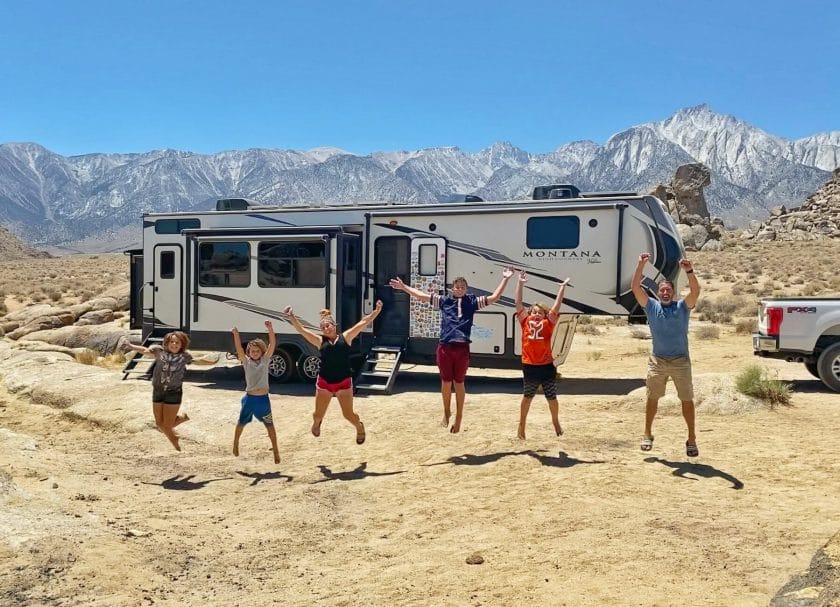
Table of Contents
Renting The RV
The first thing you may need to do is rent an RV . If you already have one skip down to the next section.
Here are some tips for helping you figure out which one is best for your trip.
Average cost
This can really range depending on what type of RV you want to get.
The best way to figure out the costs is to visit RVShare or Outdoorsy and search for what you want.
Class A – these are the bigger, bus-looking, motorhomes where you drive them. They are great for travel days, but don’t offer as much living space as a trailer or 5th Wheel.
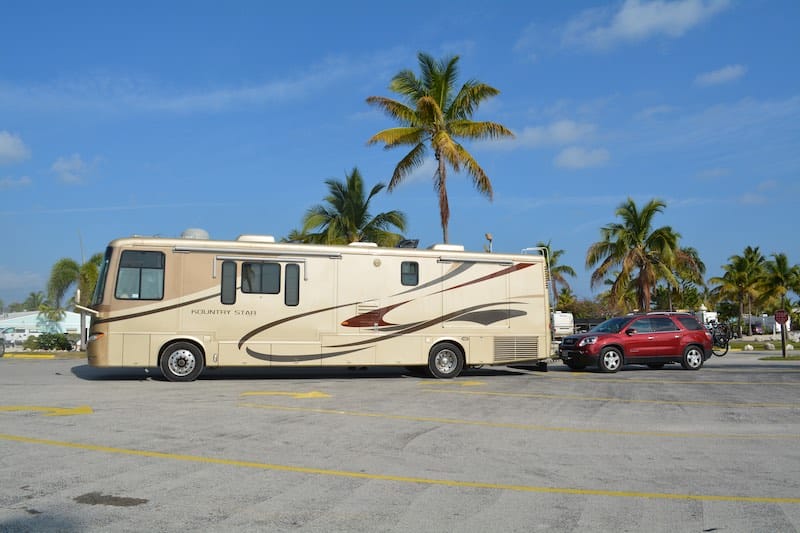
Check out Class A RV’s for rent.
Class B – these are basically a step up from a van. Great for getting around if you are planning to travel with a couple or just 1 younger kid.
Check out Class B RV’s for rent.
Class C – bigger than the Class B but normally smaller than a class A. Gives a lot of sleeping options in a smaller space and tend to be easier to drive since it is on a truck frame.

Check out Class C RV’s for rent.
5th Wheel – similar to a trailer, but a step up and the most like an apartment on wheels. This is also where you will find most toy haulers which are like garages at the back of the 5th wheel for motorcycles or a golf cart (you can sometimes find these in trailers and Class A’s, but it is more common in a 5th wheel). You would need a truck and the setup to tow it.
Check out 5th Wheels for rent.
Truck Camper – similar to the Class B – could work really well if you just have a couple people or a small family/young kids.
Check out Truck Campers for rent.
Travel Trailer – Usually the cheapest option. Offers a good amount of space with plenty of beds for larger families. You would need a vehicle and the setup to tow it.
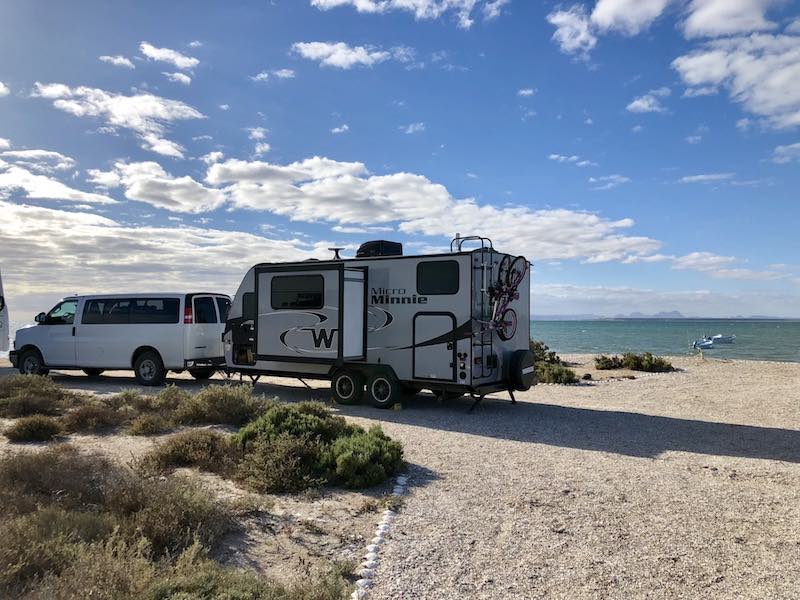
Check out Travel Trailers for rent.
Camper Van – Craig and I always talk about how we want to get a van to travel the country in when our kids are grown and out on their own! It would be fun to travel in since you can get in anywhere with it!
Check out Camper Vans for rent.
Our recommendation is to always go as small as you can. We have found it makes it so much easier for traveling, getting gas and getting in and out of places. This can mean it is tight squeeze if you have rainy days or want to spend time inside as a family – so we would recommend thinking through how you see your trip going.
Will you spend a lot of time in the RV? Or spend a lot of time outside? Will everyone have a bed in the RV or will you have to make the beds each night (by putting the table down – in the RV to convert it to a bed)?
If your thoughts are that you are using the RV as a way to travel, a place to cook meals and a place to sleep at night then going smaller will be better. For a motorhome, class C or B, trailer or fifth wheel will depend on what you feel comfortable driving.
If you want to spend a lot of time inside the RV, then you may want to look for something bigger. But just know this can make the traveling part more stressful – unless you have experience driving a big rig or towing a large trailer or 5th wheel.
Another thing to keep in mind is that when you are at a location you will probably want to go out and explore. So you will want a car to do this with. When you have a really small drivable RV you can usually take it most places and find parking spots but this would be small like 23 feet or less.
Or else, you will want to find out about towing a car or doing a fifth wheel or trailer that you tow with a truck. If you plan to just get to a campground and stay there this won’t be as much of an issue.
Plan Your Trip

Where do you want to go?! There are so many great places to go on an RV road trip and lots of great RV trip planning tools and RV apps.
If you have an RVer in your life these make great Gifts for RV Owners.
Here is a post on our Top 15 RV Campsites You Will Want To Stay At.
Length of trip
We highly recommend at least 2 weeks to get yourself into the swing of RV travel and to allow you to cover a lot of ground yet still have down time to enjoy being in the RV.
There are a few different travel styles you could pick from – or do a combination of them:
Relaxing Trip
This means you find one campground and just go and stay there. I know for a lot of families this is exactly what they are looking for.
If this is what you want to do be sure to find a place that has a lake or pool along with basketball courts, bikes to rent, games to play, etc.
This is usually going to be more of your resort type of campgrounds. But be prepared, they can be VERY busy in the summer months. As in you won’t even want to go in the pool since there are so many people in it.
You could opt to do this trip at a State Park where you look to do more nature things like playing in the river, going to the lake, hiking, etc. It will be a little more roughing it then an RV resort, but if you accept that it can be very relaxing!
Exploring Trip
This is where you plan to move a lot and see and do a lot of different things. It could mean moving every day or two. Or spreading it out and moving about every 3 – 4 days.
We recommend moving every 3 – 4 days. It will give you enough time to settle in and explore an area without feeling super rushed.
You could jump from RV resort to RV resort doing this. Or you could look for more state park and national park campgrounds or campgrounds by national parks or other historic sites and landmarks you want to explore.
Boondocking Trip
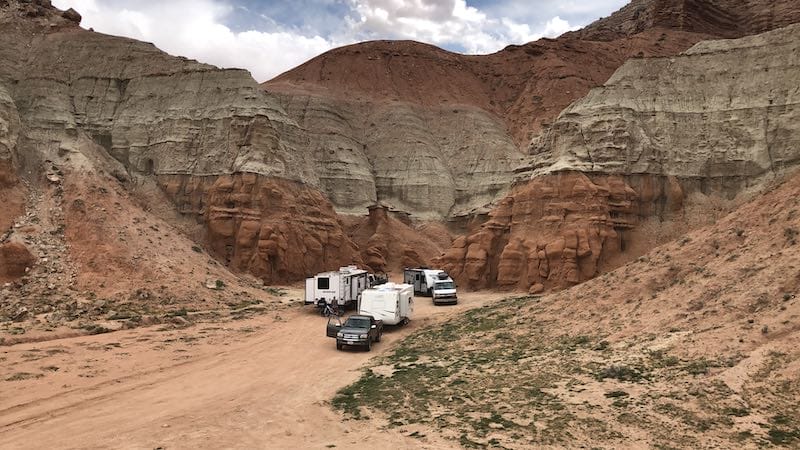
You would need to have the right rig and setup for this one. While boondocking, you wouldn’t have any hookups – so you would need power (preferably solar), larger holding tanks – so you can go longer between dumping, and a way to get potable water into your rig .
Then you go out and find BLM/free land to camp on! Part of this experience is enjoying just being out in the middle of nowhere. Or you can look for land to stay at around locations you want to go and explore.
You could easily pick one of the above or do a combination of 1 or 2 or all 3! But try to think about which kind of trip you want to have before you start deciding on what rig to rent and where to go.
For more information on boondocking, click here!
Recommended RV Trips In North America

National Park Road Trip – Pick one of these routes to get out and explore our beautiful National Parks!
Glacier National Park – Our favorite National Park in the US! So much beauty and amazing hiking!
Yellowstone And Beyond – Spend a few days in Yellowstone National Park and the exploring the surrounding area north of it in Montana.
Yellowstone National Park – You can spend a month here and not see and do everything! A huge and amazing National Park. Be sure to visit the Grand Prismatic, Grand Canyon of Yellowstone, Mammoth Hot Springs and all the cool things to do here.

Olympic National Park – There are a lot of great stops to make as you travel around the Olympic National Park in Washington.
Florida Road Trip – Travel around the whole state of Florida to visit beaches, national parks and more!
Southern California – There is so much to do in California! These are amazing stops to make in the southern part of the state.
Northern California – Northern California brings you to some amazing National Parks and a beautiful yet rugged coastline.
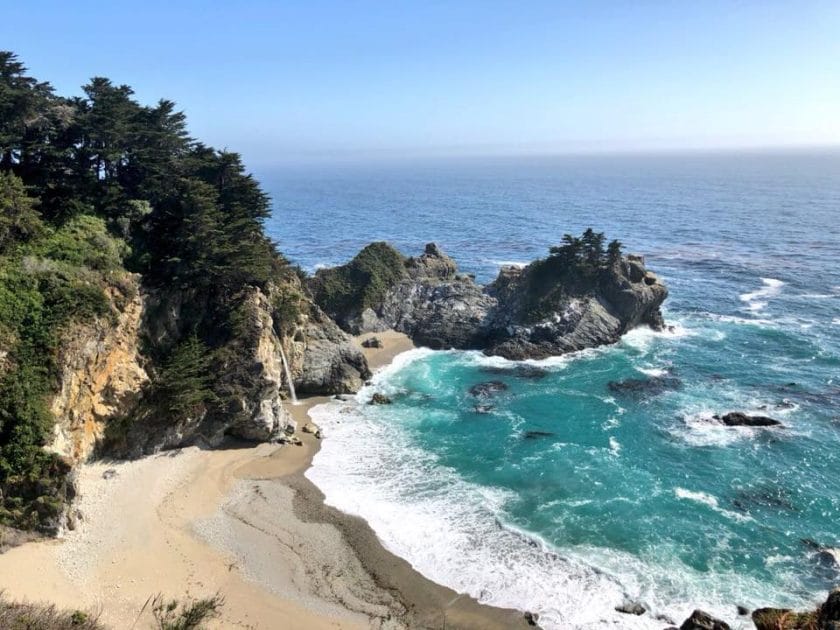
Oregon Camping – Campground hop in Oregon!
Oregon Coast Road Trip – Oregon is a beautiful state! Check out these great stops along the coast.

Camping In Wisconsin – Head up north to explore Wisconsin and stay at 1 or multiple campgrounds.
Tennessee Family Road Trip – Checkout Tennessee from Nashville to Chattanooga to Smoky Mountain National Park.
Pick Your Campgrounds

Now that you know where you want to go you have to figure out where you want to stay and find campgrounds.
Things you will want to consider when looking for campgrounds:
Hook ups – does that campground have FHU (Full Hook Ups) – meaning you have sewer, water and electric at your site. Some sites will only have electric or only have water and electric. The easiest route to go is Full Hook Ups so everything you have in your RV works.
30amp or 50amp – Make sure you know what kind of electric your RV needs. If it needs 50amp, you can make it work on 30amp but will need a specific adapter to step down your 50amp cord to the 30amp plug. This will mean that you will not have enough power to use everything in the rig. For example if you have 2 AC units then you would need 50amp for both of them to work. On 30amp only 1 would work.
Pull through or back-in – A pull through site means you can pull right into the spot and then pull right out. Nice and easy – usually!
A back-in means you have to reverse into the site. This can be very challenging if you have never done it before, especially with a trailer type RV. But usually back-in sites cost less. . . and usually the campground will help you if you are having troubles getting into the spot.
Pet Friendly – If you will be traveling with pets you will want to verify that the campground is #1 – OK with pets and #2 OK with the size and/or breed of dog you have. We had 2 labs for a long time on the road with us and we only ran into a handful of times where pets weren’t allowed at a campground.
If you do plan to take your pet with you check out the post on RVing with dogs.
I know this sounds like a lot – but you got this!! Here are a few different kind of campgrounds you can look into:
Resort Campgrounds
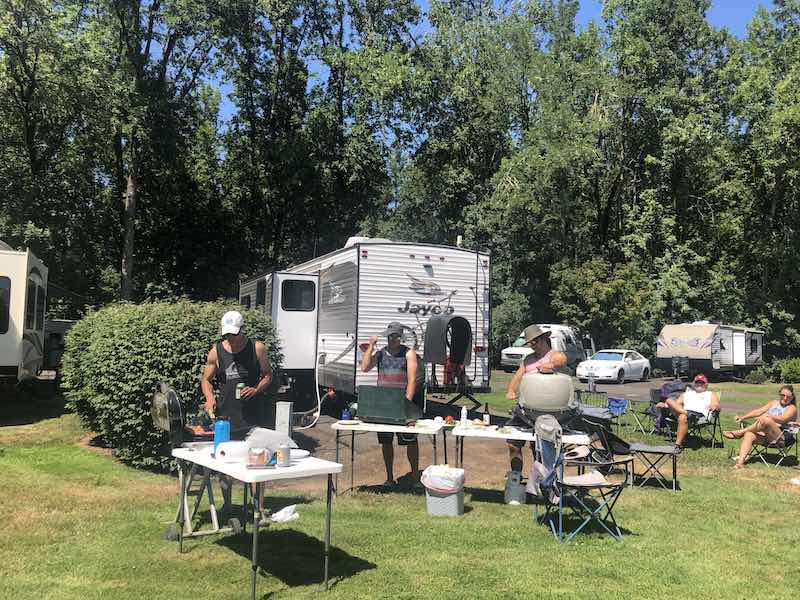
If you are looking for simplicity and some luxury then a KOA campgrounds or similar campground is the way to go. Full hookups (meaning there is a hookup for sewer, water and electric – so assuming you have the right amp hookup for your RV everything in the rig will work.
Note some RV’s have 30amp hookups and some have 50amp. Usually the larger rigs have 50amp and if you are going somewhere hot where you will want to run both AC’s in the rig you will want the 50amp), nice concrete pad sites, pull throughs, nice bathrooms, amenities, definitely more a hotel feel then normal campgrounds.
State Park Campgrounds
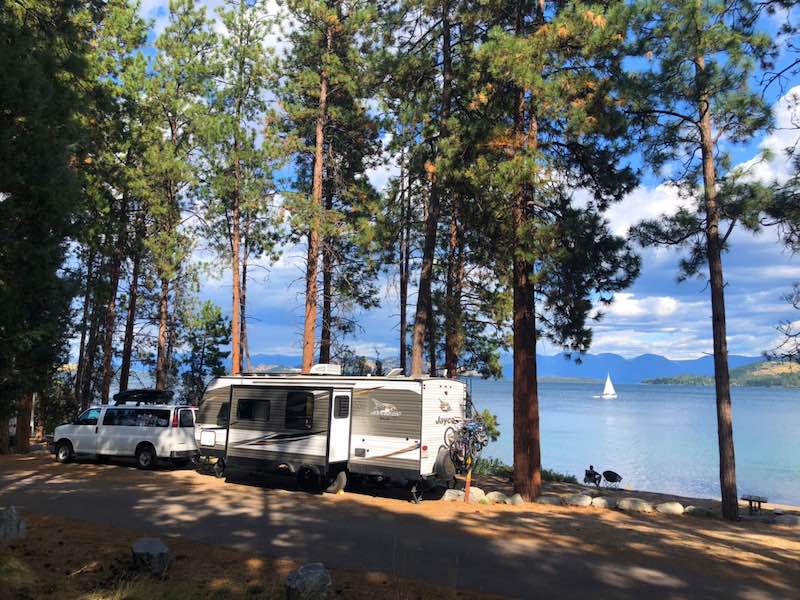
Looking for more of a nature trip? Then a state park is a great option. But be prepared that these campgrounds don’t always have full hookups. Which means you have to watch your tanks and potentially pull out of your site to dump – depending on how long you stay.
National Park Campgrounds

If you are planning to visit the National Parks, try to stay in the National Park campground if at all possible! It takes the whole experience of visiting the National Park to another level when you can stay IN the park!
But like the state park, be prepared as there may be no hookups at all or just electric. This is all doable. You just have to prepare and fill up with water when you get there (they all have water fill stations) and then be careful with water and tank usage – or else you will have to move to dump and they all offer dump stations.
Harvest Host Stays
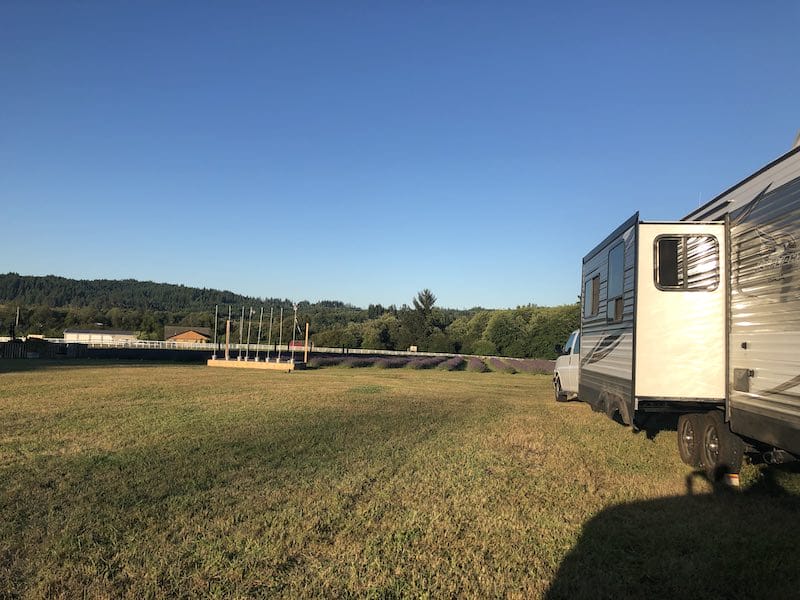
You have to join Harvest Host. Then once you do you can stay at wineries, farms, breweries and golf courses around the country for free! Most of them don’t have any hook-ups so you are boondocking and there can be size limitations so you need to call ahead to make sure you can fit and they have availability.
It is a fun way to travel! You normally can only stay for 1 – 2 nights so we use it a lot when we are traveling from destination to destination, but it is too long to get there in 1 day of driving.
Boondocking
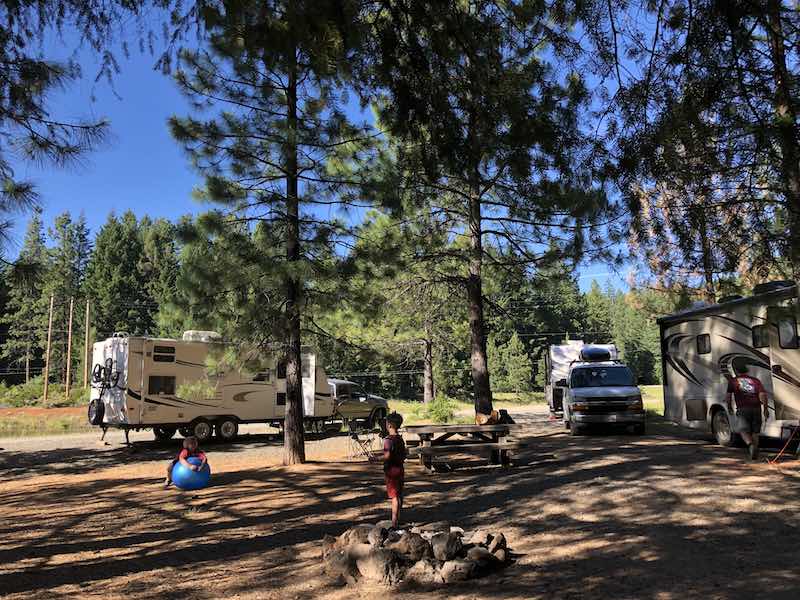
Feeling really adventurous? Then give Boondocking a try! This is where you stay for FREE on BLM land with no hookups. So no power, water or sewer hookups – you definitely need to be prepared for this.
You can also do this in National Forests and a few other places. There are a variety of Apps that help with finding these locations – Campendium, The Dyrt, Freecampsites.net.
If your rig has a generator onboard, you can use that – but ideally you would want a solar setup on your rig so you don’t need any power or to run a loud generator. You have to know where you can fill up with water before you get to your spot and where you can get water while you are there. And again watch your tanks really carefully.
Thousand Trails Campgrounds
This is a membership site that a lot of full-time traveling families use. So if you are looking to find other kids that live the RV life – maybe you are considering it for yourself. This is a great way to do that!
They have some nice campgrounds, but some not so nice campgrounds . . . and they tend to be in the middle of nowhere. So . . . unless you are interested in the RV Lifestyle I wouldn’t look to stay at one of these.
Picking Your Spot At The Campground
Once you have your campground picked out, it is time to pick your site!
If you are looking for a site that is really scenic you will most likely pay more. Which means pay attention to the prices of the sites based on their locations.
A lot of RV parks charge more for different kinds of sites. You will also want to pay attention to if they are Full Hook Up (has a hook up for water, electric, and sewer) or not. The easiest way to camp is with Full Hook Ups or FHU.
If that doesn’t matter then I would recommend deciding what you want to be closest too. The pool, the playground, a big field, the entrance, the clubhouse, the bathhouse or the lake?
If you plan to spend a lot of time at the amenities at the campground it would make sense to find a site close to them.
Prefer to be further away from people? Then you will want to look for sites that are larger and further away from the amenities and people.
If you can’t tell any of this from the campground map be sure to call and let the campground know what you are looking for so they can help you find the perfect site for your stay.
What You Need To Pack

Check out our post: The Ultimate RV Packing List To Make Your Trip A Success
Click here to sign up for your FREE RV Printables!!
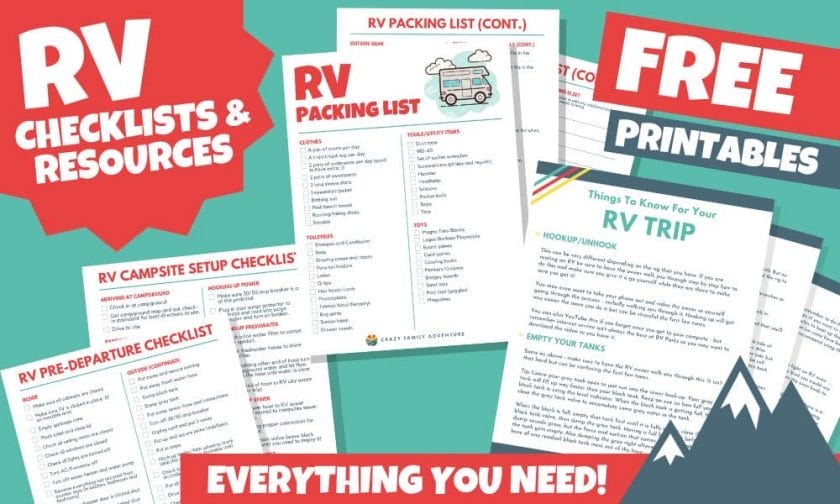
Most RV Parks have a laundromat so you will be able to do laundry. Keep that in mind while packing.
For the most part packing for an RV trip is just like packing for any other trip with a few things to keep in mind:
The clothes will get dirty since you and your kids will be outside more. Bring clothes that you don’t care if they get ruined. Then you won’t be stressing when the kids are running around and getting rips or dirty knees.
Bring layers – you will most likely want to sit out at the campfire at night and it may get chilly, so bring pants and a sweatshirt. Also bugs can get bad around dusk so having pants and long sleeves on is really helpful.
Bring bathing suits and towels.
Bring running shoes for hiking or exploring. 1 pair of running shoes and 1 pair of sandals per kid should be fine. Unless you are thinking of going anywhere fancy where you want everyone dressed up.
Tools/Utility Items
If you are renting an RV they may have a few basic tools in the rig already – this would also be a good question to ask the person you are renting from. If not you should have your basic tool bag with you:
- Set of socket wrenches
- Screw drivers (Phillips and regular)
- First Aid Kit
- Flashlights
- Pocket Knife
RV safe – if you are bringing any important documents or a lot of cash with you – you may want to get an RV safe. Ideally one that is water and fireproof.
You don’t have to go crazy with toys, but I would recommend bringing a few things. If your kids are younger bring a few of their floor toys from home – MagnaTiles, blocks, etc. Or a little older – Legos, Barbies, Playmobile.
Things they can do on the floor in the RV or out on the picnic table.
Board games and card games.
Coloring book and markers.
If you have paddle boards or kayaks that you can fit somewhere, then bring them if you are planning to go anywhere with water. A lot of places also offer rentals so if you can’t fit it you can probably find a rental place somewhere.
Boogie boards if you are heading to the beach as well as sand toys.
Pool toys – diving rings, goggles, etc.
Depending on where you are going you may want to bring your bikes with – if you can fit them into your setup. Or maybe scooters for the kids.
In an RV you have pretty much a full kitchen, so you will want to decide how much you plan to cook and also the size of the RV fridge (they can be pretty small).
We have a skillet and a large pot and then a pizza pan and baking dish and that is about it for cooking items.
We do have a coffee maker, toaster and a blender that we bring with as well.
If you are planning a longer trip and don’t want to have to buy bottled water you may want to consider buying a Berkey – we love our Berkey !
1 plate per person, 1 cup per person, 1 set of silverware per person. Coffee cups and wine glasses if you want those too!
Also if you rent an RV, they may have all of this stocked in the RV for you.
More on meal planning below!
RV Meal Planning
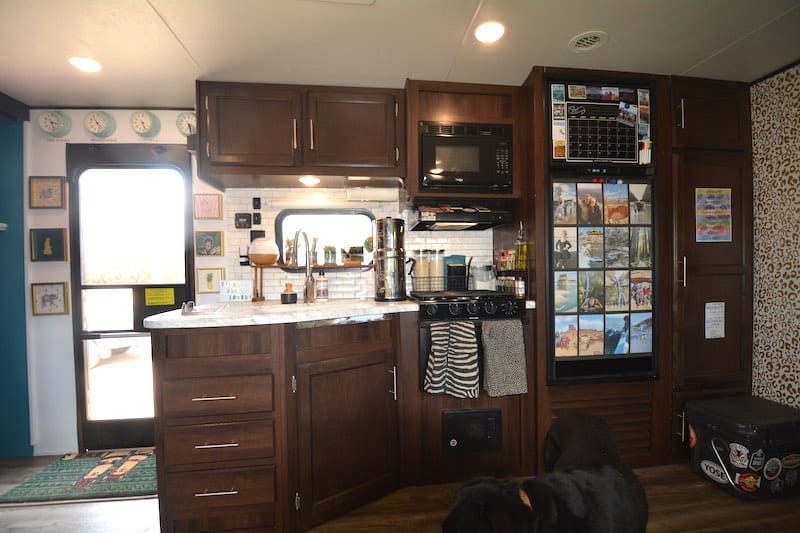
When you stay in an RV you have the option to cook similar to what you would do at home since you have a stove, microwave, etc. Or you have an option to do more campfire cooking. Living in our RV full time we don’t do a lot of campfire camping, but instead use our RV kitchen a lot but focus on keeping the meals simplified since it is a small kitchen area.
Another thing to remember is you will probably be out exploring for a lot of the day so the last thing you will want to do is come back and spend a lot of time in the kitchen. Another reason to focus on easy meals!
Easy RV Meals:
Cereal Pancakes Cinnamon Rolls Eggs, bacon and hash browns
Grilled Cheese (check to make sure your RV has a skillet or bring one from home) Buttered noodles and Parmesan Cheese Peanut Butter and Jelly Salads Hummus and Veggies Tortellini Mac and Cheese
Tacos Frozen Pizza Spaghetti Burgers Nachos
With a propane stove you can cook things in there, but if you run the stove a long time it heats up the whole rig and if you aren’t used to a propane oven, it does cook differently than a regular oven.
The above is basically our go to meals in our RV. Nice and simple with just a few ingredients!
Of course if you want, you can go all out with food, but I would just remember you will probably be out exploring and potentially going out to eat (there are lots of cool restaurants and breweries (most are family friendly!) around the country!) a lot so no reason to make food the focus.
An RV Road Trip is different than a camping weekend since you will be going with the intention to visit really cool places and not just to hang out – though hopefully you will have some of that time fit into your schedule too!
Here is a list of our top apps to help you on your RV Trip:
The Best Trip Planner Apps
Trip planning along with stopping points on your travels for gas or a break to stretch your legs. You can check out our post on 21 RV Apps That Are Super Helpful For Your RV Trip for more details. Below is a high-level list of RV trip planner apps, campground reviews and more.
- The Dyrt – a great way to find campground reviews.
- RV Parky – a great way to put your whole trip together.
- Hipcamp – unique and interesting RV stays that are usually off the beaten path.
- Harvest Hosts – stay in a winery, brewery, farm, etc overnight!
- Campendium – great for finding places to boondock.
- Google Maps
- RV Trip Wizard – great as an RV road trip planner tool.
- Mountain Directory – helpful when you are going to be driving through mountains.
- Passport America – a way to find discounted stays.
- Roadtrippers – great for adding roadside attractions to your trip plan.
Weather Apps for Planning Travels
- Accuweather
- The Weather Channel
Apps for Finding Activities
- Road Trippers
- National Parks Trail Guide
Perfect Apps to Use While Driving
- Sanidumps RV Dump Station Locator
- RV Dump Stations
- FreeZone Wifi
Great Apps for in the Campground
What you need to know how to do, hookup/unhook.
This can be very different depending on the rig that you have. If you are renting an RV be sure to have the owner walk you through step by step how to do this and make sure you give it a go yourself while they are there to make sure you got it!
You may even want to take your phone out and video the owner or yourself going through the process – verbally walking you through it. Hooking up will get way easier the more you do it but can be stressful the first few times.
You can also YouTube this if you forget once you get to your campsite – but remember internet service isn’t always the best at RV Parks so you may want to download the video so you have it.
Empty Your Tanks
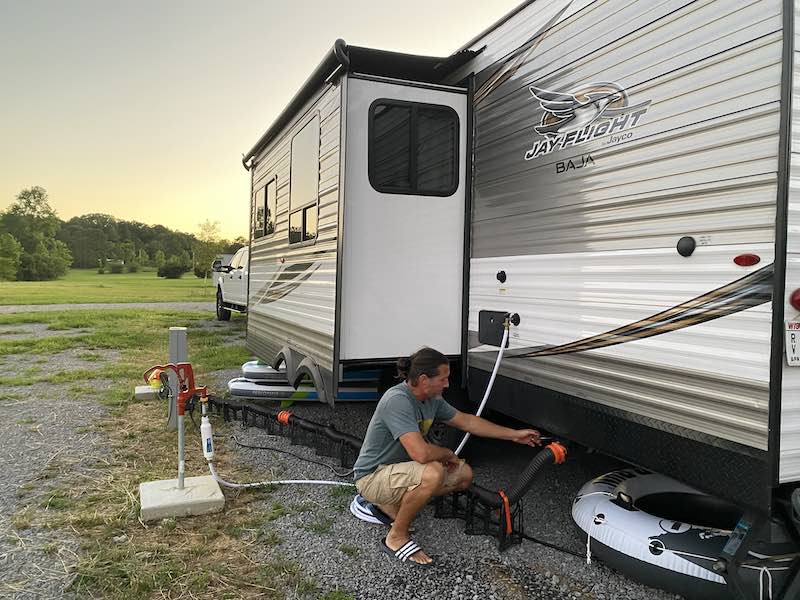
Same as above – make sure to have the RV owner walk you through this. It isn’t that hard but can be confusing the first few times.
Tip: Leave your gray tank open to just run into the sewer hook-up. Your gray tank will fill up way faster then your black tank. Keep an eye on how full your black tank is using the level indicator. When the black tank is getting full, then close the gray tank valve to accumulate some grey water in the tank.
When the black is full, empty that tank first until it is fully empty, close the black tank valve, then dump the gray tank. Having a full back tank before you dump sounds gross, but the force and suction that comes into play makes sure the tank gets empty. Also dumping the gray right afterwards will flush the sewer hose of any residual black tank mess out of the hose.
Parking The Rig
How to park the rig will depend on what type of rig you end up with. But no matter what, it is good to have someone get out and stand behind the rig to help you back in and make sure you don’t hit anything.
You want to check up top to make sure there are no low hanging branches or anything else that could puncture the roof or damage the a/c unit.
Then make sure the sides are clear and you have ample room to back in.
Then check toward the back to see what is at the back of the site and that you’ll fit properly in the site.
The person in the back walking should jump back and forth from each side of the rig as you are backing up to make sure it is all good on both sides. Also there is a chance that the person driving will be able to clearly see one side but not the other. So it is important to have walkie talkies – IF there won’t be cell service where you are. Or to call each other on your phones while you are back up.
The #1 tip is to take it slow! Take your time – check all around you multiple times – and just take it slow. You got this!
Level Your Rig
Once you are in the spot you will need to level the rig. Some rigs come with automatic levelers while others you do manually. If it all possible while you are backing in check how level you are – BEFORE unhooking. Sometimes if we just drive up a couple feet or move over a couple feet the rig is level and it makes it easier.
Other times we need to put levelers down to get it to be level.
Turn On Your Water Heater
This seems simple enough and it is! You just have to remember to do it. If you don’t turn the water heater on you won’t have hot water. If you want to take a shower and it hasn’t been on it will take a good 15 minutes to heat up the water. Some RV’s have either a gas option or an electric option (or some have both) to heat water. If you are plugged in to the campground, I recommend using the electric option so you’ll save on propane.
Light Your Oven
I am surprised they have not figured out an easier way to light an RV oven . . . but it is what it is. You will need a long lighter for this (the kind you would use to light a grill). What you need to do is bend down and turn the oven knob to the pilot setting and hold it down.
Then you stick the lighter in the oven under the rack toward the back there is a little pilot spot that primes the gas line for the oven. Light this while continuing to hold the knob down for about 20-30 seconds. After that, turn the knob to the temperature you want the oven set at. You will know it lights since the whole line where the propane comes out lights up.
Let it preheat for a bit and you are good to go! Remember though most RV ovens are small and you can fit a 9″ x 13″ pan in them IF the pan doesn’t have any handles on the side or very small ones.
You can fit a frozen pizza in it, but would be better if you have a round pizza pan to cook it on. The RV oven can take a few tries to cook things the way you want to. So be ready for that.
Turn On Your Generator
If there is an onboard generator, this should be easy enough. Just ask the owner when you pick up the RV how to do this. Most have a button in the RV near the control panel you hold down until the generator fires up. Once on, your RV will have power to the 120v system.
RV Toilets . . . a love hate relationship. So great to have, but definitely not a house toilet! This means you have to be careful with how much toilet paper goes down the toilet and you have to make sure to only use septic safe toilet paper. It’s also very important to have enough water in the bowl before flushing solids. RV toilets don’t have a tank like household toilets do, so you have to hold the foot pedal down a few seconds to let water fill in the toilet.
Scotts brand septic safe is sold at Walmarts and most grocery stores. If you can’t find septic safe you will want to bring a garbage can to throw all used toilet paper into – you WON’T want to put non septic down the toilet – trust us!
RV awnings are amazing to have and you will want to use it. BUT you can’t just open it and leave it out. Wind can damage awnings faster than you can imagine.
If you plan to sit out under the awning put it out! But if you leave or go inside to hang out then put it in every single time.
For whatever reason internet and campgrounds just don’t mix . . . either the signal doesn’t work there or they have wifi – that would work for like 10 people, but not 100 people . . .
For this reason either count on it not working or bring your own hotspot from home. You may also want to check with the campground when you book to find out if your cell/internet provider works at the campground.
If you stay at a fancy RV park they will come around and pick up your garbage. The rest of the places you will need to walk it to the dumpster yourself. Just like with tent camping, don’t leave garbage bags outside or the animals will get into it.
Packing Up To Leave
When it is time to go home or move on to your next location be sure you clear off the counters – the sink works great as a place to put things that are on the counter. Make sure there isn’t anything else sitting out that will fall. You’ll be traveling down the road and hitting all the bumps along the way so things have a tendency to fall.
Do a double check to make sure all ceiling vents are closed, windows are closed, the stove is closed, cupboards closed, toilet seat closed, and fridge is closed (and clicked shut).
Driving Tips
If you have never drive, a big vehicle you are going to want to be prepared. Write down the height of the RV and put it on a sticky note near the steering wheel. That way when you approach a bridge you will know you are all good!
Before going you can check the route via an app like RV Trip Wizard (a great RV route planner tool). You can even mark off where you will stop for gas. If you have a larger rig this will be more important.
Google Maps is not the best option if you have a larger rig . . . we once followed Google maps which gave us the shortest route BUT it was also on a winding road with a bridge that couldn’t hold the weight of our rig . . . the shorter way isn’t always the best way!
Research the route and stick to main roads as much as possible. You can also look into getting an RV GPS for your tow vehicle or rig (we used the Good Sam one for a while).
Getting Gas
If you have a smaller trailer (30 feet or less) or class B or class C you should be fine going to regular gas stations. With a fifth wheel or motorhome you may want to stop at truck stops.
Tolls will cost more if you have more axles. You will just stop at the pay station to pay and they will let you know how much.
Check out our post: RV Checklist To Make Your Trip A Success
Estimated Costs For Your Trip
Like with everything this can vary so much based on what you are going to do.
If you plan to visit National Parks you will want to get the National Park Pass – which will save you a ton of money! The pass also gets you into the National Seashore, National Forest, National Monuments, all of the things that fall under the National Parks umbrella.
If you are in a state where you will be visiting a lot of state parks you may want to look into their state park pass.
Campground fees can vary based on where you stay anywhere from $25 a night to over $100 a night. Based on your budget you can figure out what type of campgrounds you want to stay at.
The campgrounds in the National Park/State Parks are usually pretty inexpensive but they don’t always have full hookups. . .
Places like KOA tend to be more expensive, but are also nice with cement pads, full hookups, nice bathrooms and laundry rooms. So if you are looking for the RVing part to be easy and cost doesn’t matter KOA’s would be a smart choice.
You can buy a KOA discount card that will get you 10% off each of your stays.
When you visit a National Park they do offer excursions you can do. We normally don’t pay for these but instead just do all the free things – like hiking and the visitor centers. But if you want to add more to your trip you can look into all of these excursions – things like horseback riding, rafting trips, wildlife tours, etc.
Whenever we have done these they have been really cool! So if your budget allows then go for it!
Eating costs will all depend on how much you want to eat out. If you are looking to save money not eating out is the easiest way to do it when you are in an RV – since you have a full kitchen.
If you are looking for this to be more like a typical vacation you will probably go out to eat a lot, visit attractions, etc. So it could cost very similar to what a “normal” vacation costs. If you are looking to have a less expensive vacation you can make it that way you just have to be intentional about it.
More RV Content
9 Best Campfire Starter Kits
How To Tour Europe In A Motorhome
RV Living – 68 Things You Will Want To Know [Free eBook]
Keystone Montana – 7 Owners Share What They Love About It
Why Having An RV Surge Protector Is An Absolute Must!
Why A Slide Topper Is An Amazing Accessory For Your RV
2 Week Complete RV Remodel For Under $2000 [Video Included]
The Best Trailer Hitch On The Market – ProPride 3P
Best RV Wheel Chocks
Pin This Post For Later:

- Recent Posts
- 15 Amazing Things To Do In Stanley, Idaho - May 11, 2024
- 40+ Helpful Tips For Planning An RV Trip - May 10, 2024
- 18 Amazing Things To Do In Milwaukee With Kids - May 9, 2024
DISCLOSURE : This post may contain affiliate links, meaning I get a commission if you decide to make a purchase through my links, at no cost to you. Please read my disclosure for more info.
2 thoughts on “40+ Helpful Tips For Planning An RV Trip”
- Pingback: 37 Stops For The Best Cross Country Road Trip [Map Included]
- Pingback: 11 Awe Inspiring Things To Do In Southern California
Leave a Comment Cancel reply
You must be logged in to post a comment.
This site uses Akismet to reduce spam. Learn how your comment data is processed .
RVing Route 66: A Journey Through America’s Iconic Highway
Embarking on an RV journey along Route 66 is like stepping back in time and immersing yourself in the heart of American history and culture. This legendary highway, stretching over 2,400 miles from Chicago, Illinois, to Santa Monica, California, has captivated the imaginations of adventurers, artists, and wanderers for decades. Known as the “Main Street of America” and the “Mother Road,” Route 66 offers an unforgettable road trip experience filled with scenic landscapes, charming towns, iconic roadside attractions, and a sense of nostalgia that harkens back to the golden age of American travel.
Route 66 holds a special place in the hearts of travelers worldwide, as it represents the epitome of the great American road trip. With its origins dating back to the 1920s, the highway played a vital role in connecting the eastern and western parts of the United States, serving as a lifeline for small towns and businesses along its path. While the route has undergone changes over the years, and modern interstate highways have replaced some sections, the spirit of Route 66 remains alive and continues to beckon adventurers seeking to explore its historic significance and scenic wonders.
In this comprehensive guide, we will delve into the enchanting world of RVing Route 66, providing you with a wealth of information to help plan your unforgettable journey. From the history and significance of Route 66 to practical tips for a successful RV adventure, we will cover everything you need to know to make the most of your time on this iconic highway. We’ll also highlight must-see attractions, hidden gems, local experiences, and festivals along the route, ensuring that you don’t miss out on the true essence of Route 66.
Whether you’re a history buff, a photography enthusiast, a food lover, or simply seeking the freedom of the open road, Route 66 offers something for everyone. It’s a road trip filled with awe-inspiring landscapes, diverse cultures, and the opportunity to create lasting memories. So, buckle up, hit the open road, and let the magic of Route 66 guide you on an unforgettable adventure that will leave you with a deeper appreciation for the rich tapestry of America’s past and the timeless allure of the open highway.
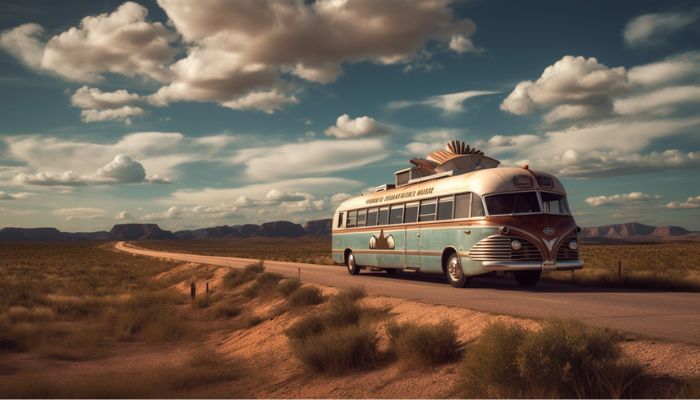
Table of Contents
- 1 History and Significance of Route 66
- 2 Planning Your RV Adventure
- 3 Must-See Attractions Along Route 66
- 4 Hidden Gems and Local Experiences
- 5 Practical Tips for a Successful RV Journey
- 6 Best Dining Experiences Along Route 66
- 7 Route 66 Museums and Historic Sites
- 8 Roadside Attractions and Photo Opportunities
- 9 Route 66 Festivals and Events
- 10 Sustainability and Responsible RVing
- 11 Capturing the Journey – Route 66 Photography Tips
- 12 Frequently Asked Questions
- 13 Final Thoughts
History and Significance of Route 66
Route 66 holds a special place in the heart of American history and has become an enduring symbol of exploration, adventure, and the pursuit of the American Dream. Its creation and subsequent popularity played a pivotal role in the development of the United States’ highway system and left an indelible mark on the cultural fabric of the country.
Creation and Early Years : Route 66 was established on November 11, 1926, as one of the original U.S. highways, connecting the Midwest to the West Coast. The vision for Route 66 originated from a desire to create a direct and efficient transportation route linking the rural communities of the Midwest to the bustling urban centers of the West, promoting commerce and growth along the way.
Economic Boom : During the 1930s and 1940s, Route 66 became the main artery for travelers journeying westward, particularly during the Great Depression and the Dust Bowl era. The highway offered hope to thousands of families seeking a better life in the fertile lands of California. It witnessed a massive influx of migrants, giving rise to the concept of the “Mother Road,” a term coined by John Steinbeck in his novel “The Grapes of Wrath.” The road’s popularity sparked an economic boom along its path, with motels, gas stations, diners, and tourist attractions springing up to serve the growing number of travelers.
Post-War Transformation : Following World War II, Route 66 experienced a surge in popularity as returning soldiers and their families took to the road for leisure and exploration. The highway became synonymous with freedom, adventure, and the open road, embodying the spirit of a nation eager to move forward after the war. The proliferation of automobiles, the expansion of the middle class, and the rise of car culture further contributed to the road’s significance.
Decline and Decommissioning : The construction of the Interstate Highway System in the 1950s and 1960s eventually led to the decline of Route 66. As faster and more efficient interstate highways bypassed many of the small towns along the original route, businesses struggled to survive. In 1985, Route 66 was officially decommissioned as a U.S. highway, signaling the end of an era. However, the road’s legacy and iconic status remained intact, as enthusiasts, preservationists, and local communities worked tirelessly to preserve its memory.
Revival and Preservation : In recent decades, there has been a renewed interest in Route 66, driven by nostalgia, a yearning for simpler times, and a fascination with the road’s history and cultural significance. Many sections of the original route have been preserved and designated as historic byways, offering travelers the opportunity to experience the essence of the road as it once was. Efforts to restore classic motels, diners, and roadside attractions have breathed new life into the towns along Route 66, creating a sense of living history.
Route 66 holds an iconic status in American history, serving as a symbol of adventure, opportunity, and the pioneering spirit that shaped the nation. Its creation and subsequent decline parallel the changing landscape of America, reflecting the evolution of transportation and the cultural shifts of the 20th century. Today, RVing along Route 66 provides a unique opportunity to step back in time, relive the glory days of the open road, and connect with the past while forging new memories along this legendary highway.
Planning Your RV Adventure
Embarking on an RV journey along Route 66 requires careful planning and preparation to ensure a smooth and enjoyable trip . From selecting the right RV to crafting an itinerary that encompasses all the must-see attractions, here are some essential tips to help you plan your RV adventure along this iconic highway:
Choosing the Right RV : Selecting the appropriate RV for your trip is crucial to ensure comfort and convenience. Consider factors such as the size of your travel party, desired amenities, and your budget. Options include motorhomes, travel trailers , camper vans, and more. Research different RV types and models, and consider renting or purchasing one that suits your specific needs.
Timing and Weather : Deciding when to embark on your Route 66 adventure is essential. While the highway can be traveled year-round, spring and fall offer milder temperatures, making for more comfortable camping and sightseeing experiences. Summers can be hot, particularly in desert regions, so plan accordingly and be prepared for warmer weather.
Route 66 Itinerary : Crafting a well-thought-out itinerary is key to making the most of your journey along Route 66. Research the attractions, landmarks, and towns along the way to determine the stops that interest you the most. Calculate the driving distances between each stop to ensure a well-paced trip, allowing for both exploration and relaxation. Be open to flexibility and spontaneous detours, as some of the best experiences can come from unexpected discoveries.
Must-See Attractions and Points of Interest : Route 66 is brimming with fascinating attractions and points of interest. Here are some must-see stops along the way:
- Chicago, Illinois : Start your adventure in the Windy City, exploring iconic landmarks such as Millennium Park and Navy Pier.
- St. Louis, Missouri : Visit the Gateway Arch, symbolizing westward expansion, and immerse yourself in the city’s rich history and culture.
- Oklahoma City, Oklahoma : Discover the National Cowboy & Western Heritage Museum and embrace the blend of cowboy culture and urban amenities.
- Albuquerque, New Mexico : Experience the vibrant Southwest culture, visit historic Old Town, and witness the enchanting Albuquerque International Balloon Fiesta if your timing aligns.
- Grand Canyon National Park , Arizona : Take a detour to witness the awe-inspiring beauty of one of the world’s most famous natural wonders.
- Santa Monica, California : Conclude your journey at the Santa Monica Pier, where Route 66 officially ends, and enjoy the sunny beaches and vibrant atmosphere.
Hidden Gems and Local Experiences
- While the main attractions along Route 66 are undoubtedly captivating, don’t overlook the hidden gems and local experiences that add a touch of uniqueness to your journey. Consider the following :
- Cadillac Ranch in Amarillo, Texas : Marvel at the unusual art installation featuring a row of partially buried Cadillacs.
- Wigwam Motel in Holbrook, Arizona : Spend a night in one of the iconic wigwam-shaped motel rooms for a truly memorable experience.
- Route 66 Museum in Oklahoma City, Oklahoma : Immerse yourself in the history and nostalgia of Route 66 through exhibits and artifacts.
- Seligman, Arizona : Step back in time in this preserved Route 66 town, filled with vintage shops, neon signs, and nostalgic charm.
Practical Considerations
- To ensure a successful RV adventure, keep these practical considerations in mind :
- RV Campgrounds : Research and book your campgrounds in advance, especially during peak travel seasons, to secure your spot. Many campgrounds along Route 66 offer RV hookups, amenities, and proximity to attractions.
- Roadside Assistance : Consider joining a reputable roadside assistance program to ensure help is readily available in case of emergencies or breakdowns.
- Budgeting : Plan your expenses and allocate a budget for fuel, campground fees, dining, attractions, and unexpected costs. It’s essential to have a financial plan to avoid any surprises during your journey.
- Safety and Maintenance : Regularly check your RV’s tire pressure , brakes, and fluids. Ensure you have a well-stocked first aid kit , emergency supplies, and a basic tool kit onboard . Familiarize yourself with RV driving techniques and safety guidelines to ensure a safe journey.
Planning an RV adventure along Route 66 requires thoughtful consideration and research. By choosing the right RV, crafting a well-paced itinerary, and being open to spontaneous detours, you’ll be well on your way to an unforgettable journey through history, culture, and breathtaking landscapes. Embrace the freedom of the open road and savor the unique experiences that await you along this iconic highway.
Must-See Attractions Along Route 66
Embarking on an RV adventure along Route 66 offers a plethora of exciting attractions and landmarks that showcase the diverse culture, history, and natural beauty of the United States. From iconic cities to breathtaking natural wonders, here are some must-see stops along Route 66 that will make your journey truly unforgettable:
Chicago, Illinois : Start your Route 66 adventure in the vibrant city of Chicago. Explore the iconic Millennium Park, where you can marvel at the famous Cloud Gate sculpture, fondly known as “The Bean.” Take a stroll along Navy Pier, offering breathtaking views of Lake Michigan and a variety of entertainment options. Immerse yourself in the city’s rich history by visiting the Art Institute of Chicago or exploring the Chicago History Museum.
St. Louis, Missouri : As you make your way through Missouri, don’t miss the opportunity to visit St. Louis. The Gateway Arch is a must-see attraction, symbolizing the westward expansion of the United States. Take a ride to the top for panoramic views of the city and the Mississippi River. Explore the historic Soulard neighborhood, known for its vibrant nightlife, live music venues, and delicious Cajun cuisine. Be sure to visit the City Museum, an interactive playground filled with architectural wonders and imaginative exhibits.
Oklahoma City, Oklahoma : Oklahoma City offers a fascinating blend of cowboy culture and urban amenities. Discover the National Cowboy & Western Heritage Museum, which showcases the rich history and traditions of the American West. Take a stroll along the Bricktown Canal, lined with restaurants, shops, and entertainment venues. Don’t miss the opportunity to visit the Oklahoma City National Memorial & Museum, a powerful tribute to the victims of the 1995 bombing.
Albuquerque, New Mexico : Albuquerque is a vibrant city known for its Southwestern charm and rich Native American heritage. Explore historic Old Town, where you’ll find adobe buildings, art galleries, and local shops. If your timing aligns, witness the spectacular Albuquerque International Balloon Fiesta, where hundreds of hot air balloons take to the sky in a mesmerizing display of color. Don’t forget to visit the Indian Pueblo Cultural Center to learn about the diverse Native American cultures of New Mexico.
Grand Canyon National Park, Arizona : Although it requires a detour from Route 66, a visit to the Grand Canyon National Park is an absolute must. Marvel at the awe-inspiring beauty of one of the world’s most famous natural wonders. Take a hike along the rim trails to soak in breathtaking panoramic views or venture into the canyon itself on a guided tour. Capture unforgettable moments as the changing light creates a mesmerizing spectacle of colors.
Santa Monica, California : As you approach the end of your Route 66 journey, make your way to Santa Monica, where the highway officially concludes at the Santa Monica Pier. Enjoy the vibrant beach atmosphere, stroll along the pier, and take a ride on the iconic Ferris wheel. Explore the lively Third Street Promenade, filled with shops, restaurants, and street performers. If you have time, relax on the sandy shores of Santa Monica Beach or catch a beautiful Pacific Ocean sunset.
The must-see attractions along Route 66 offer a diverse range of experiences, from iconic cities and cultural landmarks to breathtaking natural wonders. As you traverse this legendary highway in your RV, be sure to immerse yourself in the rich history, vibrant culture, and stunning landscapes that make Route 66 a truly unforgettable journey. Each stop along the way will leave you with lasting memories and a deeper appreciation for the beauty and diversity of the United States.
While the iconic attractions along Route 66 are undoubtedly captivating, it’s the hidden gems and local experiences that truly make your journey memorable. From quirky roadside attractions to preserved towns that harken back to the golden era of the Mother Road, here are some hidden gems and local experiences you won’t want to miss :
Cadillac Ranch – Amarillo, Texas : Located just west of Amarillo, Texas, the Cadillac Ranch is a unique art installation that features ten Cadillac cars buried nose-first in the ground. Created in 1974, this peculiar sight has become an iconic symbol of Route 66. Visitors are encouraged to bring their own spray paint cans and leave their mark on the cars, resulting in a continuously evolving artwork. Capture colorful photos and leave your own creative contribution on this one-of-a-kind roadside attraction.
Wigwam Motel – Holbrook, Arizona : For a truly unique accommodation experience, spend a night at the Wigwam Motel in Holbrook, Arizona. This historic motel, built in the 1950s, features individually themed rooms shaped like teepees or wigwams. Each wigwam is equipped with modern amenities, providing a comfortable and nostalgic stay. Embrace the vintage charm and step back in time as you immerse yourself in the retro ambiance of this iconic Route 66 lodging.
Route 66 Museum – Clinton, Oklahoma : Located in Clinton, Oklahoma, the Route 66 Museum offers a captivating journey through the history and nostalgia of the Mother Road. The museum showcases exhibits and artifacts that highlight the cultural significance and evolution of Route 66. Explore interactive displays, vintage memorabilia, and learn about the iconic motels, diners, and gas stations that once dotted the landscape of this legendary highway. Gain a deeper appreciation for the impact Route 66 had on American culture and transportation.
Seligman, Arizona : Step back in time as you visit Seligman, Arizona, a preserved Route 66 town filled with vintage shops, neon signs, and nostalgic charm. This small town played a significant role in the preservation and revitalization of Route 66. Explore the historic district, browse the souvenir shops, and dine at a classic roadside diner. Make sure to visit the famous Snow Cap Drive-In, known for its humorous signs, quirky décor, and delicious frozen treats.
Elmer’s Bottle Tree Ranch – Oro Grande, California : Located near Victorville, California, Elmer’s Bottle Tree Ranch is a whimsical and enchanting art installation that will capture your imagination. Elmer Long, the artist behind this unique creation, has crafted an extensive collection of bottle trees adorned with colorful glass bottles. Wander through the ranch and marvel at the dazzling display of light and color. This hidden gem is a testament to the creativity and eccentricity often associated with Route 66.
Munger Moss Motel – Lebanon, Missouri : For a quintessential Route 66 lodging experience, spend a night at the Munger Moss Motel in Lebanon, Missouri. This family-owned motel has been serving travelers since 1946 and embodies the charm and nostalgia of the Mother Road. The rooms are meticulously decorated with vintage furnishings, transporting you back to the golden age of Route 66. Take a moment to chat with the friendly owners, who are often more than happy to share stories and insights about Route 66 history.
While the main attractions along Route 66 are undeniably captivating, the hidden gems and local experiences along the way add an extra layer of charm and authenticity to your journey. From quirky art installations to preserved towns that capture the essence of a bygone era, these hidden gems allow you to connect with the spirit of Route 66 on a more personal level. Embrace these local treasures, engage with the communities, and create lasting memories that embody the true essence of the Mother Road.
Practical Tips for a Successful RV Journey
Embarking on an RV adventure along Route 66 requires careful planning and preparation to ensure a smooth and enjoyable trip. From selecting the right RV to ensuring safety and maintenance, here are some practical tips to make your journey along the Mother Road a success:
RV Selection : Choose the right RV that suits your needs and preferences. Consider factors such as the size of your travel party, desired amenities, and budget. Take the time to research different types of RVs, such as motorhomes, travel trailers, or camper vans, to find the one that best fits your requirements.
Route 66 Itinerary : Plan your Route 66 itinerary in advance to make the most of your journey. Research the attractions, landmarks, and towns along the way, and decide on the stops that interest you the most. Calculate the driving distances between each stop to ensure a well-paced trip, allowing for both exploration and relaxation. Remain flexible and open to spontaneous detours and unexpected discoveries.
RV Campgrounds : Book your campgrounds in advance, especially during peak travel seasons, to secure your spot. Route 66 offers a range of RV-friendly campgrounds and parks along its path. Look for campgrounds that offer amenities such as hookups, clean facilities, and proximity to attractions. Consider joining campground memberships or loyalty programs to take advantage of discounts and additional benefits.
Roadside Assistance : Consider joining a reputable roadside assistance program to ensure help is readily available in case of emergencies or breakdowns. These programs provide services such as towing, fuel delivery, and tire changes, giving you peace of mind during your journey. Research different programs, compare coverage and pricing, and choose one that suits your needs.
Budgeting : Plan your budget carefully to ensure you have enough funds for the duration of your RV adventure. Consider expenses such as fuel, campground fees, dining, attractions, and unexpected costs. Research average fuel prices along the route and calculate the estimated mileage of your RV to determine fuel costs. Allocate funds for dining out, but also consider cooking meals in your RV to save money.
Safety and Maintenance : Prioritize safety and maintenance throughout your RV journey. Perform regular checks on your RV’s tires, brakes, fluid levels, and lights. Familiarize yourself with RV driving techniques, especially if you’re new to RVing. Be mindful of low clearances and weight restrictions along the route. Pack a well-stocked first aid kit, emergency supplies, and a basic tool kit. Stay informed about weather conditions and road closures.
Navigation and Communication : Ensure you have reliable navigation tools and maps to guide you along Route 66. While GPS devices are convenient, it’s advisable to carry physical maps as a backup, as some areas may have limited cell phone reception. Inform a trusted family member or friend about your travel plans and keep them updated on your progress. Consider investing in a mobile hotspot or portable Wi-Fi device to stay connected during your journey.
Pack Efficiently : Pack your RV efficiently, maximizing the available space while keeping weight distribution in mind. Create a checklist to ensure you have all the essential items, such as bedding, toiletries, kitchen supplies, and camping gear. Pack weather-appropriate clothing and footwear, as Route 66 spans various climates and terrains. Don’t forget to bring entertainment options such as books, games, or DVDs for leisure time in the RV.
By following these practical tips, you can ensure a successful and enjoyable RV journey along Route 66. From selecting the right RV to planning your itinerary and prioritizing safety, these tips will help you make the most of your adventure. Embrace the freedom of the open road, savor the experiences along the way, and create cherished memories as you travel this iconic highway.
Best Dining Experiences Along Route 66
Embarking on an RV adventure along Route 66 not only offers a captivating journey through history and culture but also a chance to indulge in a diverse culinary landscape. From classic diners serving up American comfort food to unique eateries showcasing regional specialties, here are some of the best dining experiences to savor along the Mother Road:
Kansas City Barbecue – Kansas City, Missouri : Kansas City is renowned for its mouthwatering barbecue, and no trip along Route 66 is complete without sampling this regional delight. Sink your teeth into slow-smoked ribs, tender brisket, and flavorful burnt ends, all slathered in tangy and rich barbecue sauce. Visit legendary barbecue joints such as Arthur Bryant’s, Joe’s Kansas City Bar-B-Que, or Q39, and savor the authentic flavors that put Kansas City on the map for barbecue enthusiasts.
Tex-Mex Cuisine – Albuquerque, New Mexico : As you venture through New Mexico, immerse yourself in the flavors of Tex-Mex cuisine. Enjoy the melding of Texas and Mexican culinary traditions, resulting in dishes bursting with bold flavors and spices. Indulge in enchiladas smothered in red or green chile sauce, savor sizzling fajitas, and relish the taste of homemade tamales. Don’t miss iconic local spots such as El Pinto, Sadie’s of New Mexico, or Los Cuates for a true taste of Tex-Mex along Route 66.
Pies at Midpoint Café – Adrian, Texas : Make a stop at the Midpoint Café in Adrian, Texas, where you can indulge in delicious homemade pies that have become legendary among Route 66 travelers. This historic café, situated at the halfway point of the highway, offers an array of delectable pies, including classics like apple, cherry, and pecan. Treat yourself to a slice of pie and relish in the nostalgic atmosphere of this iconic roadside eatery.
Farm-to-Table Delights – Santa Fe, New Mexico : Santa Fe, known for its vibrant art scene and rich culinary heritage, offers a plethora of farm-to-table dining experiences. Taste the flavors of the Southwest with dishes that showcase locally sourced ingredients, from chiles and corn to squash and beans. Visit restaurants like The Shed, where you can savor traditional New Mexican cuisine like green chile stew and stacked enchiladas, or try Geronimo for an upscale dining experience featuring innovative Southwest-inspired dishes.
Steaks and Prime Rib – Amarillo, Texas : Amarillo is famous for its mouthwatering steaks and prime rib, making it a must-stop destination for meat lovers. Sink your teeth into a perfectly grilled steak, cooked to your liking, or indulge in tender and juicy prime rib that melts in your mouth. Iconic steakhouses such as The Big Texan Steak Ranch and The Handlebar Steakhouse are known for their generous portions, lively atmosphere, and top-quality cuts of beef.
Classic Diners – Various Locations : Route 66 is dotted with classic diners that transport you back to the golden era of the Mother Road. Enjoy the nostalgic ambiance, friendly service, and comfort food favorites like burgers, milkshakes, and hearty breakfasts. Step into the past at places like the Rock Café in Stroud, Oklahoma, or the Ariston Café in Litchfield, Illinois, both historic diners that have been serving travelers for decades.
As you journey along Route 66 in your RV, take the opportunity to delight your taste buds with the diverse culinary experiences the Mother Road has to offer. From finger-licking barbecue to regional specialties and classic comfort food, the dining options along Route 66 are as diverse as the landscapes and cultures you’ll encounter. Indulge in these culinary delights, support local establishments, and create flavorful memories along the way. Bon appétit!
Route 66 Museums and Historic Sites
Embarking on an RV adventure along Route 66 offers more than just scenic landscapes and iconic roadside attractions. It’s an opportunity to delve into the rich history and cultural significance of the Mother Road through the various museums and historic sites that dot its path. From exhibits that celebrate the road’s heyday to preserved landmarks that showcase its enduring legacy, here are some must-visit museums and historic sites along Route 66:
Route 66 Hall of Fame and Museum – Pontiac, Illinois : Located in Pontiac, Illinois, the Route 66 Hall of Fame and Museum celebrates the history and spirit of the Mother Road. Discover the stories of the people, places, and events that shaped Route 66 through exhibits filled with memorabilia, photographs, and interactive displays. Learn about the cultural impact of the road, its role in the development of the United States, and the changing landscape of travel.
Route 66 Association of Illinois Hall of Fame & Museum – Springfield, Illinois : In Springfield, Illinois, the Route 66 Association of Illinois Hall of Fame & Museum pays homage to the iconic highway. Immerse yourself in the nostalgia of Route 66 as you explore exhibits showcasing classic cars, vintage signage, and a collection of historic artifacts. Gain insights into the road’s history, its influence on popular culture, and the memories created by those who traveled it.
California Route 66 Museum – Victorville, California : The California Route 66 Museum in Victorville, California, offers a comprehensive look at the road’s history on the West Coast. Delve into the stories of the communities, businesses, and travelers who shaped Route 66 in California through informative displays, vintage vehicles, and memorabilia. Learn about the challenges faced during the road’s development and its impact on the surrounding regions.
National Route 66 Museum – Elk City, Oklahoma : Situated in Elk City, Oklahoma, the National Route 66 Museum provides a captivating journey through the cultural and historical significance of the highway. Explore exhibits that showcase the road’s evolution, from its early days as a dirt road to its transformation into a symbol of freedom and adventure. Discover the stories of the people who traveled Route 66, the businesses that thrived along its path, and the communities that embraced its spirit.
Wigwam Motel – Holbrook, Arizona : The Wigwam Motel in Holbrook, Arizona, is not only an accommodation option but also a historic site that harks back to the heyday of Route 66. Stay in one of the iconic wigwam-shaped rooms, which have been carefully preserved to evoke the nostalgia of the past. This landmark motel offers a glimpse into the architecture and hospitality of a bygone era, allowing visitors to experience the charm and character of Route 66 firsthand.
Meramec Caverns – Stanton, Missouri : While not directly related to Route 66, Meramec Caverns near Stanton, Missouri, holds historical significance as a popular attraction along the Mother Road. Take a guided tour through these remarkable caverns, where you’ll encounter stunning rock formations, underground lakes, and fascinating geological features. Learn about the cave’s ties to Route 66 history and its role as a roadside stop that has entertained travelers for decades.
Exploring the museums and historic sites along Route 66 provides a deeper understanding of the road’s impact on American culture, transportation, and the communities that flourished along its path. From Illinois to California, these museums preserve the memories, artifacts, and stories of Route 66, allowing visitors to step back in time and appreciate the significance of this iconic highway. Embrace the opportunity to learn, reflect, and celebrate the enduring legacy of the Mother Road.
Roadside Attractions and Photo Opportunities
One of the defining features of Route 66 is its collection of quirky and captivating roadside attractions that line the historic highway. These unique stops offer not only memorable experiences but also fantastic photo opportunities that capture the spirit of the Mother Road. From giant statues to kitschy landmarks, here are some must-visit roadside attractions along Route 66:
Cadillac Ranch – Amarillo, Texas : Cadillac Ranch is an iconic art installation located just west of Amarillo, Texas. Here, ten Cadillac cars are partially buried nose-first in the ground, providing an eye-catching sight. Visitors are encouraged to bring spray paint and leave their mark on the vehicles, resulting in an ever-changing and vibrant display of colors. Capture artistic photos against the backdrop of these classic cars and contribute to the evolving artwork.
The Blue Whale – Catoosa, Oklahoma : The Blue Whale in Catoosa, Oklahoma, is a beloved landmark along Route 66. This massive blue whale sculpture was built as a surprise anniversary gift and has since become a popular tourist attraction. The whale sits in a pond and offers a unique photo opportunity. Pose on the whale’s tail or capture a whimsical shot from the water’s edge, surrounded by the charm of this nostalgic roadside gem.
Wigwam Village Motels – Holbrook, Arizona and other locations : The Wigwam Village Motels can be found in various locations along Route 66, including Holbrook, Arizona. These unique lodgings feature individual rooms shaped like wigwams or teepees, evoking the nostalgia of a bygone era. Take a memorable photo in front of these distinctive structures, capturing the essence of the Mother Road’s golden days and the novelty of Route 66 accommodations.
The World’s Largest Rocking Chair – Fanning, Missouri : Fanning, Missouri, is home to the World’s Largest Rocking Chair, a roadside attraction that captures the imagination of Route 66 travelers. Towering at over 42 feet tall, this oversized rocking chair offers a fun and quirky photo opportunity. Climb onto the chair for a unique perspective or snap a shot from a distance to capture the sheer size of this playful landmark.
Gemini Giant – Wilmington, Illinois : The Gemini Giant in Wilmington, Illinois, is a towering fiberglass statue that stands proudly along Route 66. Clad in an astronaut suit and holding a rocket ship, this extraterrestrial figure pays homage to the space race of the mid-20th century. Strike a pose beside the Gemini Giant and capture a photo that blends nostalgia, Americana, and a touch of intergalactic charm.
Route 66 Shield Signs : Throughout your journey along Route 66, keep an eye out for the iconic Route 66 shield signs. These distinctive signs mark the route and make for great photo opportunities. Capture images of the signposts against scenic landscapes or frame yourself within the sign to create a visual reminder of your adventure on the Mother Road.
As you travel along Route 66 in your RV, don’t forget to stop and appreciate the unique roadside attractions that make this highway so memorable. These quirky landmarks and photo opportunities offer a chance to capture the essence of the Mother Road and create lasting memories. Embrace the creativity and charm of these roadside gems as you document your journey along this iconic highway.
Route 66 Festivals and Events
Embarking on an RV adventure along Route 66 not only allows you to immerse yourself in the rich history and stunning landscapes but also offers the opportunity to participate in exciting festivals and events that celebrate the spirit of the Mother Road. From car shows and live music to cultural celebrations, here are some Route 66 festivals and events that you won’t want to miss:
International Route 66 Mother Road Festival – Springfield, Illinois : Every September, the International Route 66 Mother Road Festival takes over the streets of downtown Springfield, Illinois. This three-day event showcases classic cars, live music, food vendors, and family-friendly activities. Marvel at the impressive collection of vintage automobiles, take part in the nostalgic atmosphere, and enjoy the vibrant festivities that celebrate the iconic highway.
Route 66 Fun Run – Arizona : The Route 66 Fun Run is an annual event that takes place in Arizona, covering a scenic stretch of the Mother Road from Seligman to Topock. Held in May, this event brings together classic car enthusiasts and Route 66 aficionados for a memorable weekend. Join the parade of vintage vehicles, enjoy live entertainment, and embrace the camaraderie and sense of adventure that defines Route 66.
Big Texan Steak Challenge – Amarillo, Texas : If you’re up for a unique culinary challenge, head to the Big Texan Steak Ranch in Amarillo, Texas. Known for its massive 72-ounce steak challenge, this event attracts both participants and spectators. See if you have what it takes to devour a 72-ounce steak, along with all the trimmings, within a set time limit. It’s a thrilling experience that showcases the larger-than-life spirit of Route 66.
International Balloon Fiesta – Albuquerque, New Mexico : While not directly Route 66-focused, the Albuquerque International Balloon Fiesta is a must-see event that often coincides with travels along the Mother Road. Taking place in October, this world-renowned festival features hundreds of hot air balloons taking flight in the crisp morning air. Witness the sky filled with vibrant colors and whimsical shapes, and experience the magical atmosphere of this iconic event.
Route 66 Festival – Victorville, California : In Victorville, California, the Route 66 Festival celebrates the history and cultural significance of the highway. This multi-day event, typically held in September, features live music, car shows, art exhibitions, food vendors, and more. Immerse yourself in the vibrant atmosphere, interact with fellow Route 66 enthusiasts, and enjoy the festivities that pay tribute to the Mother Road.
Joliet Blues Festival – Joliet, Illinois : If you’re a fan of blues music, make sure to check out the Joliet Blues Festival in Joliet, Illinois. This annual event, typically held in August, brings together renowned blues musicians for a day of soulful performances. Experience the sounds of authentic blues music, soak in the lively atmosphere, and celebrate the musical heritage that has intertwined with Route 66 throughout the years.
Route 66 festivals and events offer a chance to fully immerse yourself in the vibrant culture and rich heritage of the Mother Road. From car shows and live music to culinary challenges and hot air balloon spectacles, these events provide unforgettable experiences that celebrate the spirit of Route 66. Whether you’re a car enthusiast, music lover, or simply seeking to connect with fellow travelers, these festivals and events will add an extra layer of excitement and camaraderie to your RV journey along the historic highway.
Sustainability and Responsible RVing
As you embark on your RV adventure along Route 66, it’s important to prioritize sustainability and responsible practices to preserve the natural beauty and cultural heritage of the Mother Road. By adopting eco-friendly habits and supporting local communities, you can contribute to the long-term sustainability of Route 66. Here are some tips for responsible RVing:
Leave No Trace : Follow the principles of Leave No Trace to minimize your impact on the environment. Pack out all trash and dispose of it properly. Be mindful of waste and recycle whenever possible. Leave natural and cultural artifacts untouched, ensuring they are preserved for future generations to enjoy.
Conserve Resources : Practice responsible resource management during your RV journey. Conserve water by taking shorter showers, turning off faucets when not in use, and utilizing water-saving techniques when washing dishes. Be conscious of energy usage by turning off lights, electronics, and appliances when not needed. Consider using solar-powered devices to reduce reliance on traditional energy sources.
Respect Wildlife and Nature : Observe and appreciate wildlife from a distance, refraining from feeding or approaching them. Keep noise levels to a minimum to avoid disturbing animals and their habitats. Stay on designated trails and respect protected areas to minimize ecological impact.
Support Local Communities : Contribute to the sustainability of Route 66 by supporting local businesses, restaurants, and attractions. Dine at local eateries that serve regional cuisine, purchase souvenirs from local artisans, and stay at RV parks or campgrounds owned and operated by local communities. By doing so, you help bolster the local economy and preserve the unique character of each Route 66 town.
Choose Eco-Friendly Products : Opt for eco-friendly products and practices during your RV journey. Use biodegradable and non-toxic cleaning supplies to minimize the impact on water systems. Reduce single-use plastics by utilizing reusable water bottles, grocery bags, and containers. Choose environmentally friendly RV cleaning products and toiletries that are safe for the environment.
Minimize Carbon Footprint : Minimize your carbon footprint by adopting fuel-efficient driving practices. Observe speed limits, maintain a steady pace, and avoid unnecessary idling. Regularly service your RV to ensure it operates efficiently. Consider offsetting your carbon emissions by participating in carbon offset programs or supporting renewable energy projects.
Educate Yourself and Others : Take the time to educate yourself about the history, culture, and environmental significance of Route 66. Share your knowledge and experiences with fellow travelers, encouraging them to practice responsible RVing. Engage in conversations about sustainability, fostering a sense of environmental stewardship among fellow Route 66 enthusiasts.
By embracing sustainability and responsible RVing practices, you can enjoy your Route 66 journey while preserving its natural and cultural heritage for future generations. By leaving no trace, conserving resources, respecting wildlife, supporting local communities, and minimizing your carbon footprint, you become a responsible guardian of the Mother Road. Let’s work together to ensure that Route 66 remains a thriving and sustainable destination for years to come.
Capturing the Journey – Route 66 Photography Tips
Embarking on an RV adventure along Route 66 provides countless opportunities for capturing stunning photographs that encapsulate the essence of this iconic highway. From breathtaking landscapes to charming roadside attractions, here are some photography tips to help you capture the beauty and spirit of your Route 66 journey:
Research and Plan : Before you hit the road, research the iconic landmarks, scenic viewpoints, and unique attractions along Route 66. Create a shot list of must-see locations and plan your itinerary accordingly. This will help you make the most of your time and ensure you don’t miss any photographic opportunities.
Golden Hour Magic : Take advantage of the magical lighting conditions during the golden hours—early morning and late afternoon—when the sun casts a warm, soft glow on the landscapes. This is the ideal time to capture stunning colors, long shadows, and dramatic silhouettes. Wake up early or stay out late to capture the enchanting moments of Route 66 bathed in golden light.
Play with Perspectives : Experiment with different perspectives to add depth and interest to your photographs. Get down low for a unique vantage point or find elevated positions to capture the vastness of the landscapes. Incorporate foreground elements to create layers and lead the viewer’s eye into the frame. Don’t be afraid to get creative and try unusual angles to capture the essence of Route 66.
Embrace the Roadside Charm : Route 66 is known for its quirky and nostalgic roadside attractions. Capture the charm and character of these unique stops by focusing on the details. Zoom in on colorful signage, vintage cars, and retro architecture. Look for interesting textures, patterns, and colors that tell the story of the place. These details can add a touch of nostalgia and authenticity to your Route 66 photographs.
People and Stories : While the landscapes and attractions are captivating, don’t forget to include people in your photographs to tell the story of Route 66. Capture the interactions between fellow travelers, locals, and the environment. Photograph the smiles, laughter, and moments of connection. Including people in your shots adds a human element and helps convey the spirit and energy of the Mother Road.
Weather and Seasonal Variations : Be prepared for the diverse weather conditions along Route 66, as they can greatly impact your photography. Embrace the dramatic skies during thunderstorms or capture the vibrant colors of fall foliage. Utilize the different weather conditions to evoke various moods and atmospheres in your photographs. Don’t let adverse weather discourage you; it can often lead to unique and unexpected photo opportunities.
Post-processing and Editing : After capturing your Route 66 photographs, spend time editing and enhancing them to bring out their full potential. Experiment with different editing techniques to fine-tune colors, contrast, and sharpness. Consider using editing software to crop, straighten, and remove any distractions that may detract from the focal point of your images. However, strive to maintain the authenticity and natural beauty of the scenes you’ve captured.
Share and Connect : Route 66 has a vibrant community of enthusiasts. Share your photographs on social media platforms or join online forums and groups dedicated to the Mother Road. Engage with fellow travelers, exchange tips, and celebrate the beauty of Route 66 together. Your photographs can inspire and create connections with others who share the same passion for this iconic highway.
With these photography tips in mind, you’re well-equipped to capture the beauty and spirit of your Route 66 journey. Research, plan, and explore the diverse landscapes, roadside attractions, and charming towns along the way. Embrace the unique lighting conditions, experiment with perspectives, and tell the story of Route 66 through your photographs. Remember to share your work and connect with fellow enthusiasts to foster a sense of community and appreciation for the Mother Road’s visual splendor.
Frequently Asked Questions
Embarking on an RV adventure along Route 66 can be an exciting and fulfilling experience. However, it’s common to have questions about the logistics, attractions, and overall journey. Here are some frequently asked questions to help you better prepare for your Route 66 RV trip:
What is the best time to travel Route 66?
The best time to travel Route 66 largely depends on personal preferences. Spring (April to June) and fall (September to November) offer pleasant weather and milder temperatures, making them popular choices. However, summer (June to August) can be busy with tourists, and some areas may experience high temperatures. Winter (December to February) may bring colder weather and potential road closures in certain regions. Consider the weather and crowds when planning your trip.
How long does it take to drive the entire Route 66?
Driving the entire Route 66 from Chicago, Illinois, to Santa Monica, California, typically takes around two to three weeks. However, the duration can vary based on factors such as the number of stops, the pace of travel, and the amount of time spent exploring attractions along the way. Some travelers prefer to cover the route in segments over multiple trips, while others aim for a more condensed journey.
Do I need to make campground reservations in advance?
It’s advisable to make campground reservations in advance, especially during peak travel seasons. While there are many campgrounds and RV parks along Route 66, popular spots can fill up quickly. Booking ahead ensures you have a designated spot to park your RV and provides peace of mind during your journey. Research and plan your campground stays, taking into account the amenities, location, and availability of hookups.
Is it necessary to have an RV to travel Route 66?
While having an RV adds convenience and flexibility to your Route 66 journey, it is not necessary. Many travelers choose to explore the route by car, motorcycle, or even bicycle. The key is to plan your accommodations accordingly, considering options such as hotels, motels, and campgrounds along the way. RV rental services are also available for those who want to experience the road in a recreational vehicle .
Are there specific attractions or landmarks I shouldn’t miss along Route 66?
Route 66 is filled with iconic attractions and landmarks. Some must-visit stops include the Gateway Arch in St. Louis, Missouri; the Cadillac Ranch in Amarillo, Texas; the Grand Canyon in Arizona; and the Santa Monica Pier in California. However, the beauty of Route 66 lies in the journey itself, with countless hidden gems and local experiences to discover along the way. Research the attractions and landmarks that align with your interests and plan accordingly.
How much does it cost to travel Route 66?
The cost of traveling Route 66 can vary depending on factors such as the duration of the trip, the type of accommodations, dining preferences, and the number of attractions visited. Budgeting for fuel, campground fees, meals, entertainment, and unexpected expenses is essential. Research average costs for accommodations, meals, and attractions along the route to estimate your expenses and plan your budget accordingly.
Can I travel Route 66 in an electric vehicle (EV)?
While it is possible to travel Route 66 in an electric vehicle (EV), it requires careful planning due to the limited number of charging stations along the route. Research EV charging stations in advance and plan your stops accordingly to ensure you have access to charging infrastructure when needed. Additionally, be mindful of the range limitations of your EV and plan your driving distances accordingly.
Are there any restrictions or road closures along Route 66?
Route 66 is a historic highway, and while it is still accessible for travel, some sections have been replaced or bypassed by modern highways. Additionally, road closures due to construction or weather conditions can occur. Stay updated with current road conditions and be prepared to make detours if necessary. Familiarize yourself with the different alignments of Route 66 and plan your route accordingly to ensure a smooth journey.
As you plan your Route 66 RV adventure, it’s natural to have questions. By addressing these frequently asked questions, you can better prepare for your journey, make informed decisions, and ensure a memorable and enjoyable experience along the iconic Mother Road. Remember to research, plan, and embrace the spirit of adventure as you embark on your Route 66 expedition.
Final Thoughts
Embarking on an RV adventure along Route 66 is an extraordinary journey that takes you through a tapestry of history, culture, and natural beauty. This iconic highway, often referred to as the “Mother Road,” offers a unique and immersive experience that captures the essence of Americana and the spirit of exploration.
From the bustling city streets of Chicago to the sun-soaked beaches of Santa Monica, Route 66 takes you on a nostalgic trip through time, allowing you to witness the evolution of America’s landscapes and communities. Along the way, you’ll encounter historic landmarks, captivating roadside attractions, and charming towns that have withstood the test of time.
Whether you’re captivated by the history and significance of Route 66, the culinary delights along the way, or the breathtaking landscapes that unfold before your eyes, this road trip offers something for everyone. Immerse yourself in the tales of the past at the Route 66 museums and historic sites, indulge in the flavors of regional cuisine, and capture the beauty of the landscapes through your lens.
As you travel, remember to embrace sustainability and responsible RVing practices, leaving no trace, supporting local communities, and minimizing your environmental impact. By doing so, you contribute to the preservation and long-term sustainability of Route 66, ensuring that future generations can experience the magic of this historic highway.
Route 66 is more than just a road trip; it’s an iconic American experience that captures the imagination and spirit of adventure. It’s an opportunity to disconnect from the routine, immerse yourself in the freedom of the open road, and create cherished memories that will last a lifetime.
So, fuel up your RV, pack your sense of adventure, and set out on the journey of a lifetime along Route 66. Discover hidden gems, connect with local communities, and let the road guide you through an unforgettable experience filled with history, culture, and the joy of exploration. Route 66 is waiting to share its stories, charm, and undeniable allure with you.
About The Author
Karan Riley
Leave a comment cancel reply.
Save my name, email, and website in this browser for the next time I comment.
An American couple built a $1 million portfolio and retired in their 40s. Here's how they did it.
- Jim White retired at 43 with his wife after years of saving with a net worth of over $1 million.
- White said he wanted to spend more time with his family and valued having more freedom in life.
- The family moved to Panama and then traveled around the US while homeschooling their daughter.

Jim White started dreaming about retiring early when his daughter was born in 2010. Like many new fathers in the US , he took just a week off from his office job to spend time with his newborn.
"My heart broke," he told Business Insider. "I wanted to be with her as she grew up and felt like work was in the way."
White, who worked as an engineering manager for an IT company in Ohio, told BI he couldn't see how he'd be able to quit his job without being "filthy rich."
He came across a blog by Joe Udo called " Retire by 40 " in 2014. Udo, who was around the same age as White, detailed how he planned to retire early by aggressively saving and investing his 9-to-5 salary. If Udo could do it, White thought, maybe he could too.
They saved and invested better
White started researching the FIRE movement — Financial Independence, Retire Early — and pitched his plan to his wife, Lisa, who worked for a nonprofit.
The couple had already been saving but decided to ramp up their savings and investments. White was making $107,000 a year in 2014.
The couple had a net worth of $813,000 but started following the 4% rule , which says you should only retire early if you can live off 4% of your savings each year.
If they could build a portfolio of $1 million, they'd be able to use $40,000 a year on living expenses.
The couple built a portfolio of over $1 million
White said the main change he made was adjusting his investments.
"Although I had been socking away a lot of money into the 401(k) plan at work, I had just picked random mutual funds that seemed good because they showed some good performance in prior years," he added.
Analyzing his plan, he discovered one fund he was investing in was "very high cost" and switched from mutual funds to lower-cost index funds. By tweaking the funds he included in his plan, he told BI he saved around $65,000.
Related stories
The hardest part was waiting, White said. Once they'd cut their expenses and changed their investments, they had to wait for their savings to accumulate. They also started saving 60% of his pay and living off the rest.
They retired and moved to Panama
By 2018, they had investments, assets, and savings worth over $1 million, according to financial documents BI has viewed.
They sold their house for $267,800 in 2018 and rented a nearby apartment for a few months. White retired at the end of the year aged 43 — Lisa had already left her job.
With their newfound freedom, the couple decided to relocate to Boquete, a small town in Panama, because of its warmer climate. "I've lived in Ohio pretty much my whole life, and I can't stand the winters," White said. "We moved to the mountains of Panama, and it was 75 degrees every day of the year."
They sold their car and most of their belongings and packed the rest into a storage unit. The family moved with their daughter, then nine, in July 2019. They rented a three-bedroom house in a gated community for $1,100 a month and didn't need a car. "We'd walk every day," he said.
They started homeschooling their daughter, intending to place her in an international school later. But, they ended up homeschooling her for the three years they lived in Panama, because of the COVID-19 pandemic.
They lived off around $50,000 a year, slightly higher than anticipated.
The couple moved back to the US to travel in an RV
They moved back to the US in April 2022. Since October, the family has been traveling around Tennessee, Louisiana, Georgia, Indiana, Texas, and Arizona in an RV, which they bought but plan to sell after their trip.
"We've been spending incredible amounts of time as a family, just like I wanted, ever since," he said. "It's really been a dream come true."
When they're finished with their travels, they plan to move back to Ohio to give their daughter, who is now 14, some stability. "We've had our quality time together, and now she wants to spend more time with her friends," White told BI.
Lisa wants to live near family again and plans to return to work part-time.
For now, White is content to spend his time on hobbies like coding, learning Spanish, and writing his blog, "Route to Retire."
"Just because we're not working right now doesn't mean we don't plan to ever work again," White said. "It's just that we have that choice."
Watch: Millions of homes could flood the US housing market thanks to boomers
- Main content
protect your home away from home
RV insurance
- Coverage & policies
- RV discounts
Coverage for the open road
What you need to know about rv insurance, coverage & policies, get rv insurance today.
By clicking "get a quote" you will leave Allstate.com and be directed to the National General (an Allstate company) website*
How to compare RV insurance quotes
Choose your coverage, consider your limits, select your deductibles, travel trailer and motorhome insurance that's customized for you.
RV insurance typically covers the following types of homes-on-wheels:
- Towable RVs
RVs that don’t have their own engine must be towed when moving locations. These include folding camper trailers, conventional travel trailers, truck campers, fifth-wheel travel trailers, horse trailers with sleeping quarters and travel trailers with expendable ends.
- Motorized RVs
Often called motorhomes, these self-reliant RVs do not need to be towed, are built on automotive frames and can sleep up to eight people.
Do you need insurance for your RV?
You're required to have insurance for your motorhome. Minimum liability requirements vary from state to state, with many states requiring you to have extra coverage for protection against uninsured or underinsured drivers.
Is insurance required for a travel trailer?
Generally, insurance is not required on trailers since liability coverage is typically extended to the trailer when attached to the vehicle towing it.
Tour your available RV insurance discounts
Save your money for your traveling on RV insurance with Allstate. Enjoy discounts based on how you pay your bill if you own a home and more.
see RV discounts
RV insurance FAQs
How much does rv insurance typically cost, do i need insurance on my rv if it isn’t being driven.
Check your state’s insurance laws before removing liability coverage on your RV. While some states allow storage without any coverage, others require the owner to turn in the RV’s plates if liability coverage is removed.
If there is a loan on your RV, check with your lender before removing collision coverage.
You may want to consider holding onto your comprehensive coverage year-round, even when your RV is not in use. It can help cover fire, theft, and other non-collision damages while your RV is in storage.
If I have a loan on my RV, can I remove coverage?
You should check with your lender to make sure you maintain the required coverage on your RV.
Is roof damage or a roof leak covered?
It depends. If you have comprehensive coverage on the RV and the roof is damaged by a covered peril, like a tree falling on the roof, there is coverage. But there is no coverage for general wear and tear or lack of maintenance. Depending on the state, we offer optional Roof and Pest coverages that provide additional protection.
What’s the difference between motorhome and travel trailer insurance?
Stories & tips for everyday life
- Motorhome rental and insurance
- What is motorhome insurance?
- Protecting motorhome from theft
- Motorhome comprehensive coverage
5 Popular State Parks in Tennessee (with RV Hookups)
By: Author The Drivin' & Vibin' Team
Posted on May 13, 2024
Tennessee’s state parks offer premium amenities and unrivaled natural beauty. From staggering waterfalls to striking scenic vistas, the Volunteer State has it all.
But you’ll find a lot of options to choose from. And although we can’t think of any you should stay away from, a few shining gems stand out against the crowd.
Today, we’re bringing you five of Tennessee’s best budget camping destinations.
Let’s jump in!
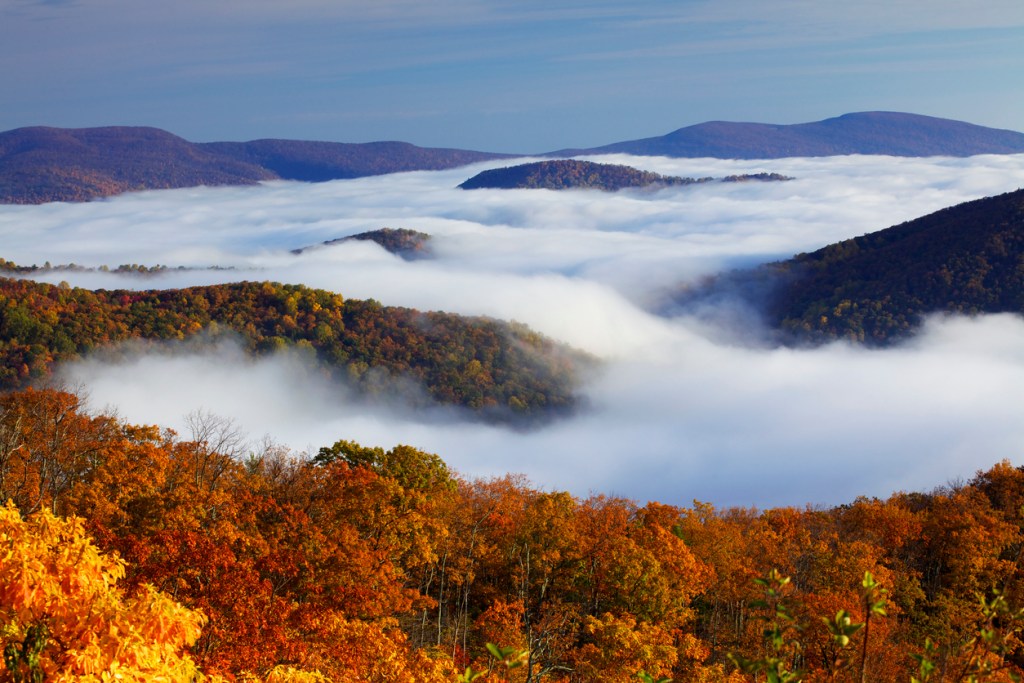
Why Travel to the Volunteer State?
Tennessee is home to 57 state parks, ranging from a mere 19 acres to a whopping 31,500. Each offers visitors a unique experience. In fact, history buffs, birdwatchers, spelunkers, and paddlers can all find something to enjoy here.
Best of all, many destinations provide scenic accommodations with easy access to big-city amenities. You can take advantage of Nashville’s music scene, Memphis’ culinary delights, and the excitement of Dollywood without spending all your time in metropolitan areas.
In order to sweeten the deal, the parks service offers many discounts for visitors. State residents get 10% off stays. Senior citizens and those with proof of ADA eligibility can also receive 25% to 50% off camping and lodging fees. Finally, veterans, state employees, and others can take advantage of reduced rates too.
Before you pack your bags, take a look at these five highly-rated Tennessee state parks with RV hookups.
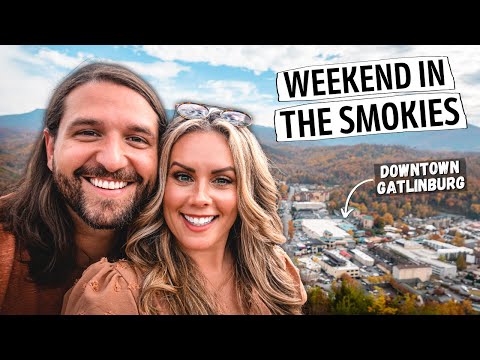
#1 Edgar Evins State Park
Edgar Evins State Park is about an hour and 20 minutes east of Nashville, Tennessee. This spot on the shores of Center Hill Lake features plenty of hiking, boating, and fishing opportunities. Additionally, birdwatchers have reported more than 150 species throughout the year, and many enjoy climbing to the top of the observation tower to see them in the canopies.
A one-mile trail links the campground to the marina, which has a restaurant, boat launch, playground, and other facilities. For a more substantial trek, the Merritt Ridge Trail traverses a peninsula and stretches over five miles into the glorious wilderness.
The campground at Edgar Evins won’t disappoint, either. Sixty sites have water and electrical hookups with 20-, 30-, and 50-Amp service. There’s a restroom with showers and flushing toilets, a dump station, and a general store where you can pick up last-minute necessities.
A number of spots put your camper on an elevated platform, giving you unencumbered views of the reservoir. We know many can accommodate 36-foot rigs, but if your setup is longer, give them a call to see if you’ll fit.
#2 Fall Creek Falls State Park
Fall Creek Falls State Park is one of the most popular in Tennessee. Located an hour north of Chattanooga, this destination features striking waterfalls that plunge into immense gorges. In fact, it’s a prime example of the Cumberland Plateau’s beauty.
You can explore nearly 30,000 acres of hardwood forest surrounding Fall Creek Lake here. Over 55 miles of hiking trails traverse the property, ranging from quick jaunts to overnight excursions. Many visitors also enjoy casting a line for catfish, bluegill, and largemouth bass.
However, this park includes modern amenities you rarely see at state-run facilities. You can play a round of golf on the award-winning 18-hole course. There’s also a driving range and putting green if you want to practice a bit. The Canopy Challenge Course lets you zipline through the trees and tackle up to 70 suspended obstacles.
Additionally, there’s a nature center with tons of interpretive displays, as well. Naturalists offer daily programs like arts and crafts, eco-demonstrations, and game nights.
If that’s not enough to convince you to visit, the campground might seal the deal. You’ll find 222 RV sites, with about half boasting full hookups. Most have a picnic table and a fire ring. You’ll also have access to seven bathhouses, trash service, and a dump station. Some spots can hold setups up to 65 feet long.
Here are the Best Free Camping Spots in Tennessee !
#3 Pickett CCC Memorial State Park
Pickett CCC Memorial State Park is about two hours north of Knoxville, Tennessee. This destination is in the 20,887-acre Pickett State Forest and adjacent to the 125,000-acre Big South Fork National River and Recreation Area. Its status as an International Dark Sky Park is no surprise.
But there’s also plenty to do here during the day. Arch Lake is a popular spot for fishing, swimming, and paddling. Nearly 60 miles of hiking trails lead to rock houses, sandstone bridges, and other unusual geologic formations.
Next, stop by the Pickett CCC Museum to venture back in time and learn about the Civilian Conservation Corps’ contributions to preserving the landscape. Interactive and interpretive exhibits help tell the story of Tennessee’s state parks.
Over 30 RV campsites include water and about twenty of those have electrical hookups with 20- and 30-Amp service, too. We’ve heard of rigs up to 34 feet fitting into these spots, but you may want to call if your setup is longer.
The sites have picnic tables and fire pits. A nearby dump station and restrooms with showers make for convenient stays. You can also purchase firewood without leaving the grounds.
As far as Tennessee budget camping is concerned, this destination is a winner!
Looking for more? Check out Tennessee’s Secret City !
#4 Rock Island State Park
Rock Island State Park is another wildly popular budget camping spot in Tennessee. Situated between Nashville and Knoxville, its proximity to the big city falls in its favor.
Caney Fork River Gorge draws visitors from all over. Its cascading waterfalls and stony riverbeds are a photographer’s dream. This is where the Collins, Caney Fork, and Rocky Rivers converge with Center Hill Lake.
In the early 1900s, a textile mill was the area’s cornerstone. Later, a hydroelectric dam was built to supply power to the region. It’s now a major recreational zone, but the dam is still operating. Of course, you’ll need to steer clear of certain parts of these rivers, as large amounts of water are regularly released.

Despite the dangers, there’s a lot to enjoy about this park. Anglers fish for crappie, catfish, walleye, and smallmouth bass year-round. Eight recreational trails, from short stretches to three-mile hikes, provide access to scenic overlooks, waterfalls, and wildflowers.
Fifty campsites offer water and 20-, 30-, and 50-Amp electrical service. A handful also have sewer, but you’ll need to book far in advance to score one of these treasured spots. They all have charcoal grills, picnic tables, and lantern holders. Rigs up to 35 feet should fit comfortably.
Finally, bathhouses with hot showers, trash service, and a dump station help ensure you’ll have the essentials.
Bring Tennessee’s wildflowers to your own backyard with a Premium Wildflower Seed Mix !
#5 Roan Mountian State Park
Located in the northeast corner of Tennessee, Roan Mountain State Park offers rest and relaxation for weary travelers.
You can get a sense of Southern Appalachia’s history by browsing the museum and visitor center. Here, you’ll see interpretive displays on past mining, logging, and farming ventures. The area was also a waypoint for soldiers during the Revolutionary War. In the summer months, you can tour the old Miller farmhouse, which is listed on the National Register of Historic Places.
Of course, there’s no shortage of recreational activities to enjoy. About 12 miles of multi-use trails meander the park. Furthermore, the Doe River is home to three trout species and is frequently restocked by the Tennessee Wildlife Resources Agency. You’ll even find tennis courts where you can put your arm to the test.
The campsite features 86 RV spots with water and 20-, 30-, and 50-Amp electrical hookups. They can accommodate rigs up to 45 feet, but folks with extended units should call ahead. In addition, restrooms with showers, trash service, and a dump station are all available.
Country Music and Hot Chicken are Just the Beginning
Tennessee’s state parks are an excellent option for folks traveling through on a budget. Campers can explore the great outdoors, learn about local history, and even take in the big-city sites while having a peaceful place to call home at the end of the day.
The next time you head to the Volunteer State, be sure to check out its many natural wonders!
Discover the Best Free Camping Across the USA
To be honest with you, we hate paying for camping . There are so many free campsites in America (with complete privacy).
You should give it a try!
As a matter of fact, these free campsites are yours. Every time you pay federal taxes, you’re contributing to these lands.
Become a FREE CAMPING INSIDER and join the 100,000 campers who love to score the best site!
We’ll send you the 50 Best Free Campsites in the USA (one per state). Access the list by submitting your email below:

7 Best RV Insurance Companies of 2024
Money’s main takeaways.
- RV insurance is essential for both full-time RV living and occasional trips.
- Premiums are based on factors like your driving record and RV type, age and condition.
- Our top picks include Good Sam, National General and Auto-Owners Insurance.
Why Trust Us?
Money’s editorial team has evaluated RV insurance providers since 2016. Our research and analysis take into account customer satisfaction, financial stability, coverage options and availability, among others. Read the full methodology to learn more.
- Reviewed 15+ companies
- Conducted over 1,000 hours of research
- Prioritized coverage, discounts, customer sentiment, the NAIC complaint index and financial stability
Our Top Picks for the Best RV Insurance Companies
- Good Sam – Best RV Insurance Agency
- RVInsurance.com – Runner-Up for Best RV Insurance Agency
- Nationwide – Best for Multiple Discounts
- National General – Best for Full Replacement Cost Coverage
- Progressive – Best for Disappearing Deductibles
- Roamly – Best for Renting Out Your RV
- Auto-Owners Insurance – Best for Customer Service
Best RV Insurance Reviews
- Offers full-timer coverage
- Manage your policy online without agent contact
- Discounts on campsites, gear stores, fuel, and more
- Not a direct insurer
Why we chose this company: Good Sam Insurance Agency is the best option for those who need help selecting coverage. It connects you with some of the best RV insurance companies to help you get the right coverage level for your needs.
Good Sam works with renowned insurance providers like Progressive, Foremost, Safeco, and National General to offer a range of standard coverage options. Additionally, through its partnership with MexicoInsuranceOnline.com, the agency connects clients to Mexico-based insurers and offers tailored add-ons for cross-border travel, whether for single-day or extended stays.
The company also extends a storage discount, allowing policyholders to suspend collision and liability coverage when their RV or trailer remains unused for over 30 days, reducing monthly premiums. Furthermore, Good Sam assists in crafting personalized policies for full-time RVers.
Learn more: Good Sam RV insurance review
See rates on Good Sam’s Secure Website >>
Why we chose this company: RVInsurance.com can help you find a suitable policy, whether you use your RV for vacationing or as your residence.
- Specialists can help you find a policy
- Policies available for all types of RVs
RVInsurance.com works with Foremost, National General and Safeco. These companies cover all RV types, from motorhomes to campers. They offer several policy add-ons, such as full replacement cost, full-timers liability coverage and roadside assistance.
You can get a quote online, but calling to speak with an insurance specialist lets you compare policies in more detail.
See rates on RVInsurance.com’s Secure Website >>
- Free annual reviews to reevaluate coverage and discounts
- Optional towing coverage includes lodging, transportation and meals
- Various policies available for easy bundling and savings
- Many customer complaints about the claims process
Why we chose this company: Nationwide Insurance offers over 10 different discounts, including discounts for staying claim-free during the previous policy period or installing safety devices, like smoke detectors.
Most RV insurers offer discounts, but Nationwide’s list is notably extensive. You can save by bundling your RV policy with home insurance, taking safety courses, joining an RV organization like the National RV Association, paying your annual policy upfront or opting for Nationwide’s full-time RV insurance package.
Note that not all discounts are listed on Nationwide’s website, and some only come up during the quoting process. For example, according to a customer service representative, the company also offers discounts to customers whose vehicles have safety features such as tire-pressure monitoring systems or fiberglass bodies.
Learn more: Nationwide RV insurance review
See rates on Nationwide’s Secure Website >>
- Coverage for specialized equipment like solar panels
- Pause your coverage when your RV is in storage
- Experts help you find a new RV after a total loss
- Low mileage discount
- Eligibility, benefits, coverage and discounts vary per state
- Limited information about policies on its website
Why we chose this company: Full replacement cost coverage can usually only be bought during an RV’s first model year. National General, on the other hand, lets you get the rider within an RV’s first five model years.
With full replacement cost coverage — also called total loss replacement — your RV is replaced with a new or similar one if it’s totaled or stolen, potentially reimbursing you for the original purchase price. This is typically only available for newly purchased motorhomes or travel trailers up to one or two model years old. If you buy a used RV or don’t insure your new one as soon as possible, you risk it being considered ineligible.
With National General, RVs are eligible during their first five model years, regardless of ownership (some companies limit this type of coverage to original owners). It also offers the flexibility to pause coverage during storage, helping you save on premiums while protecting against theft, fires, weather damage, and more.
Learn more: National General RV insurance review
See rates on National General’s Secure Website >>
- Accident forgiveness for claims under $500
- Horse trailer coverage up to $50k
- Pet injury coverage available
- Add-on coverage available for roof malfunction
- Standard plan excludes personal property and emergency expenses
- Rates differ based on whether you buy online or through an agent
- Discounts aren't available in all states
Why we chose this company: Progressive offers disappearing deductibles, accident forgiveness and an extensive array of discounts.
With Progressive, you can save on premiums if you’re the RV’s original owner or pay your policy in advance, among other discounts. However, Progressive stands out from competitors because it offers both disappearing deductibles and accident forgiveness.
Unlike competitors, Progressive doesn’t cap its diminishing deductible benefit at $500. Instead, it reduces your deductible by 25% each claim-free period, up to $0 after four periods. While it costs extra, the feature is included with comprehensive and collision coverage for vehicles valued at $25,000 or more. Accident forgiveness for claims of $500 or less is included at no cost.
See rates on Progressive’s Secure Website >>
- Specializes in RV insurance
- Coverage even when renting out your RV
- Policies for full-time RVers are available
- Covers Canada rentals
- Only offers RV policies
Why we chose this company: Insurers typically decline coverage if you rent your RV to someone else. With Roamly, you can rent out your RV and still be covered for liability and damage to the vehicle.
Rented RVs require comprehensive commercial insurance due to their higher risk exposure when compared to personal vehicles. Failing to insure your motorhome or camper when renting it out can lead to denied claims, especially if the renter lacks coverage.
With Roamly, your RV remains covered when listed on rental platforms like Outdoorsy (owned by Roamly). Renters booking your RV through Outdoorsy can opt for a renters protection package, including trip protection, interior damage and travel medical insurance. Roamly’s policies cover rented RVs for their actual cash value during the rental period and provide $1 million in liability insurance protection per trip.
Learn more: Roamly RV insurance review
See rates on Roamly’s Secure Website >>
- Premium reduction if RV is equipped with safety features
- Towing and roadside assistance in all 50 states and Canada
- Mobile app for Apple and Android
- No online quotes
Why we chose this company: Auto-Owners is our pick for personalized customer service because of its network of independent agents, online customer center and mobile app. Customers can access claims, billing and other important policy documents on their phone, tablet or computer.
Auto-Owners has an impressive customer service record, with fewer complaints with the National Association of Insurance Commissioners (NAIC) than most competitors. It also ranked above average in the southeast region in J.D. Power’s 2022 Auto Insurance Customer Satisfaction study.
Unlike other companies, Auto-Owners only sells its insurance products through independent agents. Instead of contacting the company online, you work directly with local agencies that can better advise you regarding specific insurance requirements in your area. For example, bodily injury and property damage liability limits set by law vary by state.
Learn more: Auto-Owners RV insurance review
See rates on Auto-Owners’s Secure Website >>
Other RV Insurance companies we considered
During our research for the best recreational vehicle insurance providers, we narrowed down our initial list to 7 companies. The following didn’t make our final cut, not because they were lacking, but because other competitors had more standout features.
- Covers motorhomes, travel trailers and campers
- Includes roadside assistance, hotel discounts and more
- Coverage for lodging and transportation if your RV is damaged
- Coverage options are not standard across regions
- RV policy not available nationwide
- Limited information available online
AAA offers coverage for different types of RVs and some of its policies also cover personal effects such as electronics. However, it didn’t make our list because it doesn’t offer coverage in all 50 states.
See rates on AAA’s Secure Website >>
- Discount if you transfer from another insurance company
- Discounts for drivers 55 years or older
- Gas price locator to help you find the cheapest gas
- Limited information on company website
- Online quotes not available
Allstate’s policies include emergency travel expenses if you’re over 50 miles from home when your RV breaks down and the issue is covered under the policy. Allstate is not on our main list because it only provides quotes through its sales agents and the information on its website is limited.
See rates on Allstate’s Secure Website >>
- Total windshield replacement deductible is only $50
- Personal effects replacement limits up to $100,000
- Free accident forgiveness after 5+ years
- Offers limited information on its website
- Enhanced RV coverage unavailable in HI, MA, MI and NC
- Total loss replacement coverage availability varies
While Geico offers coverage options comparable to those of other companies on our list (such as total loss replacement, emergency expenses coverage and vacation liability), its policies aren’t available nationwide. Its website also lacks crucial details, such as available discounts.
See rates on Geico’s Secure Website >>
- Loan or lease protection coverage available
- Deductibles diminish by $100 per year up to $500
- Insures motorhomes valued at up to $1 million
- Coverage available for custom equipment
- Only covers vehicles used 250 days or less per year
- Limited information available on website
- No online quotes available
Safeco covers class A, B and C motorhomes valued at up to $1 million, but only if used recreationally. It didn’t make our list because its website doesn’t offer much information and coverage is limited to vehicles used less than 250 days a year.
See rates on Safeco’s Secure Website >>
- Coverage for emergency expenses if camper is damaged or destroyed
- Pays for transportation of damaged RV to storage, repair shop or home
- Full-timer coverage for trailers, motor homes, luxury coaches and more
- Special policies for USAA members
- Not available in DC or Hawaii
- Limited information on website
Foremost, a subsidiary of Farmers Insurance, has policies for full-timers as well as stationary travel trailers. It also covers personal-use motor homes that you occasionally rent, lease or loan. Unfortunately, this policy doesn’t cover the vehicle while it’s rented, leased or loaned.
See rates on Foremost’s Secure Website >>
- Offers storage-only insurance during the off-season
- Policy extends to travel anywhere in Canada
- Insures equipment permanently attached to your RV
- No information regarding discounts
Despite offering coverage in Canada, Farmers Insurance fell short of our list due to limited information regarding specific coverages and discounts on its website . This lack of transparency makes it challenging for consumers to assess the scope and value of its policies.
See rates on Farmers’ Secure Website >>
- Multi-vehicle, safe driver and original ownership discounts
- Coverage for all RV classes, including slide-on campers
- Members get a 5% discount on policies
- Policies only available to military families
- 5% members discount not available in all states
USAA offers RV insurance through an alliance with Progressive, which covers almost all types of RVs. The drawback to USAA’s policies is that they’re only available to military families.
See rates on USAA’s Secure Website >>
Country Financial
- Multi-policy discount
- Mobile app for Apple and Android devices
- Only available through agents
- Operates in only 19 states
Country Financial’s RV insurance policies fall under home or auto insurance. That can be a drawback for consumers who already have a preferred auto or home insurer. Another notable snag in its coverage is that it’s available in only 19 states.
See rates on Country Financial’s Secure Website >>
National Interstate
- Options for RV full-timers
- 25% deductible discount for each consecutive claim-free year
- Windshield replacement coverage
- Coverage for commercial RVs
- Website lacks information about terms and discounts
National Interstate has policy options for RV full-timers and covers commercial RVs. This insurer is not featured on our main list because its website doesn’t provide details regarding policies or discounts.
See rates on National Interstate’s Secure Website >>
The Hartford
- Lifetime guarantee for repairs done in authorized repair shops
- 24/7 claims submission
- RV replacement if it's totaled in the first 15 months
- Only available to AARP members
- Not available in U.S. territories
The Hartford allows policyholders to customize their RV insurance coverage, and its lifetime guarantee for repairs in authorized shops is a highlight of its policies. However, coverage is only available to AARP members, which is a considerable drawback.
See rates on The Hartford’s Secure Website >>
RV Insurance Guide
Like auto insurance, RV insurance offers financial protection for accidents, injuries and other unforeseen events. It can cover repair costs, medical bills and liability expenses if you injure someone or damage their property.
While comprehensive policies covering collision, theft and personal belongings are widely available, occasional RV users may not need such extensive coverage. Read on for information on RV insurance costs, coverage options and tips for selecting the right policy for your needs.
Table of contents
How much is rv insurance, types of rvs, what type of insurance does an rv need.
- What does RV insurance not cover?
- How to buy RV insurance
Renting out your RV
According to Progressive, an RV insurance policy for a travel trailer (an RV you tow behind your vehicle) costs an average of $573 annually. In contrast, coverage for a motorhome costs an average of $958 per year.
The following factors influence the cost of an RV insurance policy:
- The type of RV: Motorhomes are more expensive to insure than trailers (especially those with state-of-the-art components).
- Age and condition: Older trailers and motorhomes cost less to insure due to their reduced resale value.
- Type of RV insurance: A policy with just liability coverage is more affordable than a comprehensive one with collision and personal property coverage.
- Where you live: Your state and zip code affect your insurance rates. RVs in areas prone to extreme weather will be more expensive to insure.
- Driving experience and driving record: A first-time RV owner poses a higher risk than an experienced RVer. Insurers will also review your general driving record to determine an appropriate rate.
- Claims history: A lengthy claims history is a red flag to insurers. Drivers who have never filed a claim will get much better rates than those who have.
- Additional coverage: Purchasing add-ons such as roadside assistance, total loss replacement, vacation liability and full-timers coverage will increase your premium.
Recreational vehicles fall into four categories: Class A, Class B, Class C and towable RVs. The first three are motorhomes, drivable units with living quarters and appliances. Towable RVs, also called campers or trailers, may also have amenities, but some are designed to transport animals or cargo.
Here’s the rundown of the different types of RVs available:
Class A motorhomes
Class A motorhomes are the most luxurious and spacious, measuring 24 to 45 feet long and fitting as many as 12 passengers. However, their size can make driving tricky and limit their mileage to around 10 miles per gallon or less.
Class B motorhomes
Class B motorhomes, also known as “camper vans,” are the smallest (17 to 19 feet long) and least expensive type. These are standard-sized vans usually packed with a compact kitchen, bathroom and foldable or fixed bed. Their limited living space makes them suitable for four passengers or less who enjoy minimalist traveling.
Class B+ or B Plus motorhomes
Class B+ or B Plus motorhomes are the big siblings of Class B camper vans. These vehicles measure between 17 and 30 feet, fitting bigger beds and more spacious bathroom and kitchen areas.
Class C motorhomes
Class C motorhomes measure 21 to 41 feet long and are easily recognized by their over-cab sleeping or storage area. Compared to larger units, they have better gas mileage and maneuverability and are ideal for full-time living. Class C motorhomes can accommodate up to eight passengers and include a kitchen, dining area, bathroom and sleeping quarters.
Towable RVs
Towable RVs can be hitched to SUVs, pickup trucks or any capable vehicle. This category encompasses fifth wheels, toy haulers, travel trailers, and pop-up and truck campers, typically ranging from 10 to 30 feet. Other types of towable RVs include utility, cargo and horse trailers.
Since RVs can be vehicles and primary residences, insuring them requires special considerations. Some policies offer basic liability protection, while others provide broader coverage for personal effects and emergency expenses.
Keep in mind that if your RV is self-propelled, your coverage should meet your state’s minimum liability insurance requirements. This applies whether you use the vehicle occasionally or as a residence.
If your RV is towable, the insurance policy on the towing vehicle may extend to the RV. However, note that the towing vehicle’s policy usually only covers liability, not physical damage to the RV or attached accessories.
Best RV insurance features for part-time RVers
People who use their motorhomes for weekend getaways should at least have basic liability coverage that meets their state’s minimum requirements.
Other types of RV insurance for part-time RVers include:
- Property damage liability coverage: Pays for damages you cause to another person’s property or vehicle.
- Bodily injury liability coverage: Helps pay the medical expenses of those you injure in an at-fault accident.
- Collision coverage: Covers repairs to your RV after an accident with another vehicle, whether you’re at fault or not.
- Comprehensive coverage: Pays for damages caused by theft, vandalism, natural disasters, fire and other non-collision accidents.
- Uninsured/Underinsured motorist coverage: Covers the cost of repairs to your RV and your medical payments if you’re in an accident caused by a driver without insurance or insufficient coverage.
- Personal Injury Protection (PIP): Covers medical expenses for you and your passenger in the event of an accident, no matter who is at fault. It may also cover lost wages.
- Campsite/vacation liability coverage: Helps pay for legal expenses if you’re deemed responsible for injuries or losses incurred by a non-family member within your campsite or RV.
- Roadside Assistance: Offers around-the-clock repairs, towing and emergency assistance should your RV experience a flat tire, battery discharge or other malfunction.
Best RV insurance features for full-time RVers
For added peace of mind, full-time RVers should consider having a more comprehensive policy that includes some of the above-mentioned add-ons as well as any of the following:
- Personal property coverage: Covers the cost of replacing any damaged or stolen personal effects. This includes clothing, furniture, jewelry and computers, for example.
- Total loss replacement: Replaces your RV with an equal or similar model if your vehicle is stolen or totaled in an accident. The insurer may reimburse you for the original purchase price in other cases. Lenders may require this coverage if you finance your RV.
- Full-time RV liability coverage: Adds additional coverage for liability and medical expenses if you live in your RV for six months or more each year.
- Emergency expense allowance: Covers up to a specified amount of living and travel expenses like car rentals, lodging and food if your RV leaves you stranded, usually more than 100 miles away.
- Specialized coverage: Can replace appliances like awnings, satellite dishes, and solar panels and can even provide coverage for any pet injuries that happen in the vehicle.
- Loss assessment: Helps cover fees RV associations charge for damage to common areas in a campsite, for example.
What RV insurance doesn’t cover
RV insurance won’t cover the following:
- Normal wear and tear: RV insurance protects your vehicle against unexpected events, not routine maintenance or deterioration.
- Mold damage, fungi or rot: Insurers consider mold a sign of neglect and won’t cover damages unless it’s directly linked to water damage caused by a covered event.
- Certain types of water damage: RV insurance doesn’t cover water damage caused by regular wear and tear, freezing temperatures or manufacturer defects.
- Earthquake coverage: RV insurance covers most natural disasters, including floods, storms and fires, but earthquake coverage varies by insurer.
How to Buy RV Insurance
Here are some tips on how to find and purchase the right RV insurance coverage for you.
Determine the coverage you need
Your car insurance policy may extend to towable campers or trailers, but not motorhomes. And while auto insurance may cover you against liability and damages to the RV, it generally doesn’t cover belongings or appliances inside the vehicle. Homeowners insurance may also offer some coverage, but only when the RV is parked on the insured property.
Another option is umbrella insurance for your RV, which covers liability claims exceeding your primary auto, home or RV policy limits. However, coverage only kicks in if your RV is covered by an underlying policy that meets the umbrella policy’s liability requirements.
Take time to shop around for insurance quotes
RV insurance costs depend on your driving history, location, type of vehicle and usage and any optional riders you select. To get the most affordable premium for the coverage you need, compare quotes from multiple insurers. Consult an independent insurance agent if you don’t have time to shop around.
Consider bundling multiple policies
Most insurers offer multi-policy discounts, helping you save on premiums by combining your RV policy with auto, home, renters, boat or even life insurance policies . Bundling can also help you avoid the hassle of dealing with different companies when you have to file a claim.
Check for available discounts
While these may vary by company, most insurers offer rate discounts for:
- Paying the total annual policy upfront
- Making monthly payments on time
- Staying claim-free during the previous policy period
- Being the vehicle’s original owner
- Installing safety features in your RV
- Having a favorable record of insurance losses
- Staying accident-free for at least three years
- Taking safety courses
- Being a member of an RV association
Drivers aged 50 and up can snag a lower rate, as can parents or guardians who opt not to insure drivers under 25 on their policy.
Insurance when renting an RV
If you plan on renting an RV for a vacation, consider getting RV rental insurance. This type of policy usually provides liability, collision damage waiver, and coverage for personal accidents or personal effects.
You can purchase a policy through the rental company or your insurer. However, remember that your current car or RV insurance policy may already extend some rental RV coverage. Coverage may not be available in some states or for trips longer than 30 days, so call your insurer to verify before heading out.
If you rent your RV to others, it’s considered a commercial-use vehicle, and your insurance policy won’t cover the renter. The person must obtain their own rental insurance. If you’re merely lending your RV to a friend or family member, your existing coverage may extend to them, depending on your policy.
Note that some states — including Arkansas and Wisconsin — require drivers to get special licenses to drive RVs. If you live in one of these states and lend your RV to someone, that person must have the required license if you want your insurance policy to cover them.
What kind of insurance do I need to rent out my RV?
To rent out an RV, you’ll need at least liability coverage, which pays for damages or injury you may cause to other people and their property in an at-fault accident. Except New Hampshire, all states and the District of Columbia, require that vehicles, including RVs, have liability coverage.
Insurance for towable RVs is another matter. When you tow your RV behind another vehicle instead of driving it, you only have to worry about having enough coverage to protect your belongings, not additional liability insurance.
RV Insurance FAQs
What states require trailer insurance.
Trailer insurance requirements vary by state and by type of trailer. Most local governments require liability insurance, while others also require uninsured motorist coverage.
Currently, only two states don't require any type of trailer insurance. You can drive an uninsured vehicle in Virginia if you pay an uninsured motorist fee. In New Hampshire, you can drive uninsured if you prove you have enough money to cover liability expenses in an at-fault accident.
Do you need trailer insurance?
You don't need insurance for a non-motorized trailer hooked to a towing vehicle. The vehicle's insurance coverage extends to the trailer attached to it. However, this coverage is typically limited to liability.
Talk to your auto insurance provider if you want to add property damage coverage for the trailer or purchase a separate RV insurance to ensure the trailer is insured against damage.
Who has the best RV insurance?
Does rv insurance cover water damage, what is vacation liability rv insurance, how we chose the best rv insurance.
- Coverage options and discounts: We picked companies that offer a comprehensive selection of coverage options and premium discounts.
- Customer satisfaction: We favored companies with above-average scores in J.D. Power’s U.S. Auto Insurance Study.
- Financial strength: We considered the financial strength of each insurer as evidenced by their A.M. Best rating. A.M Best is a credit rating agency that assesses the creditworthiness of insurance companies.
- Complaint index: We looked up every insurer’s complaint trend report from the National Association of Insurance Commissioners (NAIC) and favored those with few complaints.
Summary of Money’s Best RV Insurance of 2024
© Copyright 2024 Money Group, LLC . All Rights Reserved.
This article originally appeared on Money.com and may contain affiliate links for which Money receives compensation. Opinions expressed in this article are the author's alone, not those of a third-party entity, and have not been reviewed, approved, or otherwise endorsed. Offers may be subject to change without notice. For more information, read Money’s full disclaimer .
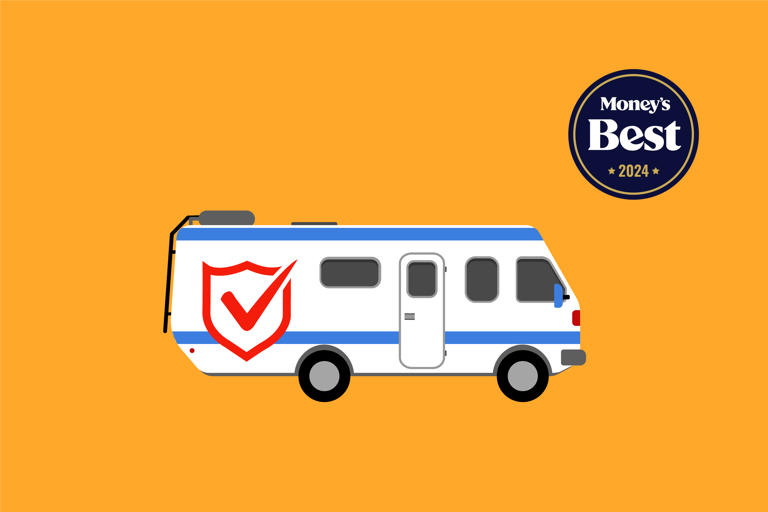

IMAGES
VIDEO
COMMENTS
Others to consider: The America the Beautiful pass from the US National Park Service, which allows a family—the pass owner and three accompanying adults age 16 and older (kids 15 and below are free)—entrance to all parks for just $80 a year. Harvest Hosts allows you to RV camp at more than 2,000 wineries, breweries, and farms in the US and ...
The new dream: See as many states as we can in our budget-friendly travel trailer with our senior pets, with the goal being all lower 48. We left Idaho in November 2020, and by August 2021, we were popping champagne in Arkansas, our 48th state together. Below, we'll give our best advice, RV travel tips, and route planning hacks for RVing the USA.
Route 66. Route 66, also know as the Mother Road, is the most iconic and celebrated RVing route in the USA. Historic Route 66 covers over 2,400 miles, starting in Chicago and ending at Santa Monica, California. For the classic experience, I would recommend sticking to the westernmost portion of the route.
Route 66. Distance: 2,332 miles. The classic American road trip, Route 66 spans from Chicago to Los Angeles. Unlike the other trips we list here, Route 66 is less a nature excursion and more a ...
USA RV Itinerary #1: California Highlights (plus Las Vegas) With this RV itinerary, you'll hit the best national parks and major cities in California, plus take a small detour to Las Vegas. The camping sites along this RV itinerary range from forest sites to beach-side camping. This is a circular route, so you could start from any point.
Remember that you are responsible for the campervan while it is in your possession. You should treat it like it is your vehicle and carry out basic maintenance checks every 300-500 miles. Basic maintenance includes checking things like tire pressure, and oil, washer fluid, and coolant levels.
Cheap Travel Destinations. One of the greatest things about traveling via RV is that you have the ability to see amazing things without spending much money. Choosing cheap travel destinations can help tremendously if you're trying to save money. Below are some of the best budget-friendly RV travel spots in the US.
First: Plan Your Route. As we stated earlier, backtracking for a cross-country road trip is never something anyone wants to do. You also don't want to find yourself traveling on roads or bridges that are not RV-friendly. Traveling in an RV can be stressful, but this stress is magnified when you're lost or on a road not approved for RVs.
Here are a few things to keep in mind about renting an RV: Prices will fluctuate based on availability and seasonality. Motorhomes will go between $175 to $275 per night on average for an older model (10 years and older), depending on the Class you rent. Newer RVs run between $150 to $450 per night on average.
If you're planning to travel as a couple, and you're going to purchase an RV, then I am definitely partial to Toyota motorhomes for roadtripping the USA. Toyota motorhomes are micro-RVs, which means they are about the same size as a campervan but thanks to an over-cab bed they feel much more spacious than a campervan.
This year's guide boasts over 50 resorts across the United States. Plus, you'll find a collection of getaway locations in Canada—new to the 2024 edition. Created based on suggestions from RV travelers, it's got all of the tools you need to ensure the perfect accommodations every time. ... RV travel is about so much more than getting to ...
3. Plan Your Route. Once you have a good idea of must-see destinations, it's time to plan your travel route. Travel route planning is one of the most important parts of planning an RV trip because most RVs are large and can't drive on every road. Don't rely solely on Google or Apple Maps for your travel route.
When the world shut down with COVID-19, Greyson Ferguson bought and renovated a 1960s camper, and took the opportunity to see the United States in a way he never expected. Editor's note: during COVID-19 there are restrictions on travel. Check the latest guidance in the United States and always follow local health advice.
RVLove. Driving an RV is harder than driving a car, the Bennetts said: It's bigger, heavier, slower, less fuel-efficient, and more physically tiring. They recommend taking breaks every couple of ...
Hitting the road in a camper van is one of the most intimate - and exciting - ways to experience the USA.. Which is why I set off on a two-year road trip with my husband and dog in 2017. We camped in 48 states, hiked countless national parks, ate in local towns and drove from coast to coast in our 1996 retro camper van.. As our trip unfolded, we learned that certain states suited us van ...
Love startups, traveling with our two kiddos, and RV life. Cofounded CampgroundBooking.com and sold it to Camping World. For six years Alyssa and I traveled all over the US full-time in our RV before settling in southwest Colorado.
Obviously, we were spending an extra $50 to $60 per day, or about $25 to $30 per person. This includes food and fun but it does not include the cost of the RV and/or maintenance. (Our net cost for the RV was $10,000 — $38,000 purchase price, $28,000 sale price — plus the $7751.39 for engine replacement.)
Before you are vibrant cities, breathtaking views, and iconic places such as Niagara Falls . 3. New York, New Jersey and Pennsylvania in an RV. Some of the most beautiful landscapes in America await you in rural New York, New Jersey and Pennsylvania. This route passes through cities such as Philadelphia, Washington, Niagara Falls , and New York ...
From there, the idea of living in an RV quickly transpired into an ideal solution for us to combine work, travel and quality time together. We chose a used 2012 Class A motorhome — like a bus. It's 36 feet long and has four slide outs, which makes it pretty roomy inside when we are parked.
Organ Pipe Cactus National Monument: Arizona. Organ Pipe Cactus is the only place in the U.S. where the organ pipe cactus grows wild. San Antonio Missions: Texas. The San Antonio Missions are a group of five frontier mission complexes situated along a 7.7-mile stretch of the San Antonio River.
Authentik USA is an RV road trip specialist based in USA. Customize your 10, 15 or 21 days itinerary and plan your all-inclusive motorhome holidays and vacations packages with a local agent. Motorhome vacations and roadtrips include campgrounds booking, campervan, rv rental and are available between May and October. RV rental prices are now on-line for 2024.
You can check out our post on 21 RV Apps That Are Super Helpful For Your RV Trip for more details. Below is a high-level list of RV trip planner apps, campground reviews and more. The Dyrt - a great way to find campground reviews. Allstays. RV Parky - a great way to put your whole trip together.
Embarking on an RV adventure along Route 66 is an extraordinary journey that takes you through a tapestry of history, culture, and natural beauty. This iconic highway, often referred to as the "Mother Road," offers a unique and immersive experience that captures the essence of Americana and the spirit of exploration.
America's southern states offer warm escapes that typical Canadian winters, unfortunately, cannot compete with. When the thermometer starts to drop and the snow starts to fall, those of us who can tend to pack up our RVs to migrate south for the winter. Recent numbers suggest that about 500,000 Canadian snowbirds flock south each winter.
The couple moved back to the US to travel in an RV. They moved back to the US in April 2022. Since October, the family has been traveling around Tennessee, Louisiana, Georgia, Indiana, Texas, and ...
Insurance may be more expensive for a large vehicle compared to your typical car in your driveway. It's a good idea to call around and find out how much insurance for different sizes of RVs will ...
Continue. More information. Allstate can help you protect your motorhome with quality RV insurance coverage and the support of a knowledgeable agent who are there for you.
The campsite features 86 RV spots with water and 20-, 30-, and 50-Amp electrical hookups. They can accommodate rigs up to 45 feet, but folks with extended units should call ahead. In addition, restrooms with showers, trash service, and a dump station are all available.
According to Progressive, an RV insurance policy for a travel trailer (an RV you tow behind your vehicle) costs an average of $573 annually. In contrast, coverage for a motorhome costs an average ...
What are the required motorhome insurance coverages? Whether you drive a class A motorhome, class B camper van, or class C mini motorhome, your RV insurance policy must have at least the minimum liability coverage limits required by your state for auto insurance. RV liability coverage can pay for injuries you cause to others while driving your motorhome, up to the limits of your policy.